

IMPACT REPORT 2025
The Kids Research Institute Australia acknowledges Aboriginal and Torres Strait Islander people as the Traditional Custodians of the land and waters of Australia.
We also acknowledge the Nyoongar Wadjuk, Yawuru, Kariyarra and Kaurna Elders, their people and their land upon which the Institute is located and seek their wisdom in our work to improve the health and development of all children.
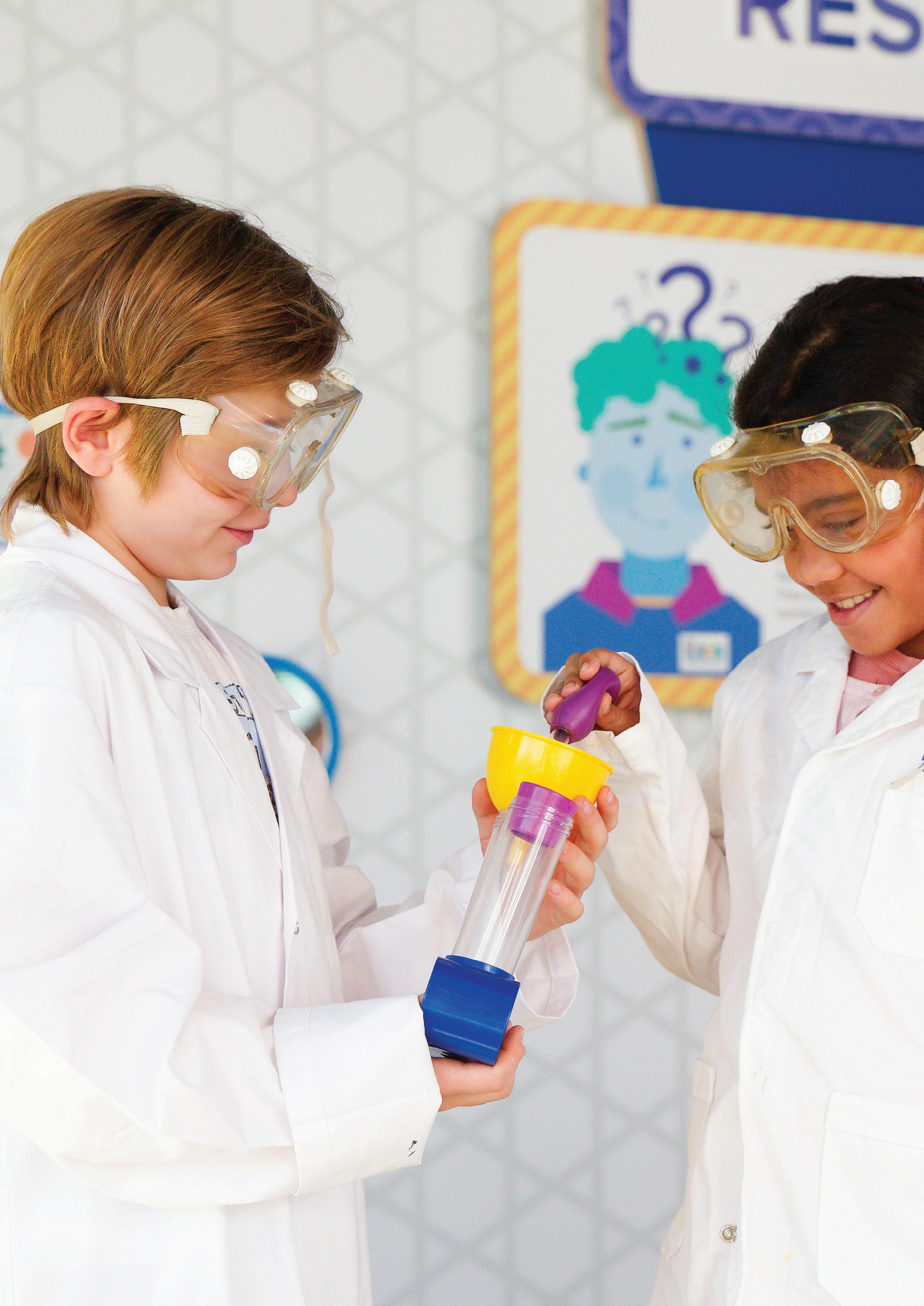
Cover photo: Siblings Lauren, 8, and Caiden, 9, are helping to promote sun safety for Aboriginal and Torres Strait Islander children. See story page 58.
This page: Samuel Zaknich, 8 and Malaika Morkel, 8, in The Kids Discovery Centre at Perth Children’s Hospital.
INTRODUCTION
35 years of thinking of the kids
TRANSLATION
Research that has been actively translated into policy or practice.
14 RSV hospitalisation admissions slashed by new immunisation program
16 STAMPing out RSV in Western Australia
18 Research breakthrough gives hope to children with rare and undiagnosed diseases
20 Early-stage type 1 diabetes clinic a WA first
22 Universal meningococcal protection soon to be a reality
PARADIGM SHIFT
Research that changes the very way we think.
26 Multi-partner project gains longevity thanks to support from BHP and Channel 7 Telethon
30 Penicillin breakthrough transforms RHD treatment
32 Custom mental health app empowers new mums with lifelong wellbeing skills
34 New research reveals crushing burden of Tourette syndrome and tic-related disorders
36 Joining the dots to keep children with cerebral palsy healthier and out of hospital
38 Evaluation critical piece of puzzle to strengthen case for new child protection assessment model
40 New evidence shows timely introduction of peanuts and eggs reduces allergy risks for kids
42 Sports betting a ‘gateway’ to problem gambling, new research finds
44 Gold standard treatment for all diabetes patients
COLLABORATING FOR IMPACT
How we work with others to make a difference.
48 Hope for kids with cancer thanks to one of Western Australia’s biggest ever donations
52 Early Years Partnership project keeping the cavities away for Central Great Southern kids
54 Waalitj kids stars of their own show in the quest to learn more about infectious diseases
56 The Kids researchers working to tackle wicked threat of antimicrobial resistance
58 United approach for strong healthy skin
60 Landmark study halves skin infections in remote Aboriginal kids
62 Shaping global policy on infectious disease with mathematical modelling research at The Kids
IN THE PIPELINE
Research that is in the pipeline towards translation.
66 New autism approach is pointing families in the right direction for support
68 Parents urged to trust their inklings to help babies’ communication development
70 ORIGINS research uncovers worryingly low iron levels in Western Australian toddlers
72 Harnessing the power of the digital age to improve adolescent mental health and anxiety levels
74 Innovative end to recurrent ear infections
76 Global program seeks to unlock immune system secrets to improve children’s lung health
78 Study proves health benefits of ‘liquid gold’
Our special thanks to those who have contributed to this report, including the researchers and families whose stories we have shared.
Thank you
At The Kids, our dedicated team of researchers, clinicians, and students work together with global collaborators to improve the health and wellbeing of children and families affected by some of the most challenging and widespread health issues. This vital work is ongoing and would not be possible without the generosity and commitment of our incredible community.
We thank all of our corporate partners, trusts, foundations, bequestors, and individual donors who help make our research possible. Every contribution, no matter the size, plays a crucial role in our mission to build a future where all children can thrive.
Special thanks goes to the Channel 7 Telethon Trust for its unwavering support over the years. Telethon funding helps us to meet the full cost of child health research — including our researchers, specialised laboratories and projects — ensuring our work continues to make a real difference. We are proud to be one of their beneficiaries and deeply value this enduring partnership.
The Stan Perron Charitable Foundation has also been instrumental in advancing our work, notably in 2024 through its support of the WA Comprehensive Kids Cancer Centre. This collaboration, in partnership with the Child and Adolescent Health Service, Perth Children’s Hospital Foundation and The University of Western Australia, is helping to transform outcomes for children with cancer.
Our supporters include corporate partners, as well as generous philanthropists and passionate community fundraisers. Throughout this Impact Report, you’ll see acknowledgements that reflect the breadth and depth of our supporter network.
Thank you for believing in our shared vision. Together, we are shaping a future of happier, healthier kids and families.
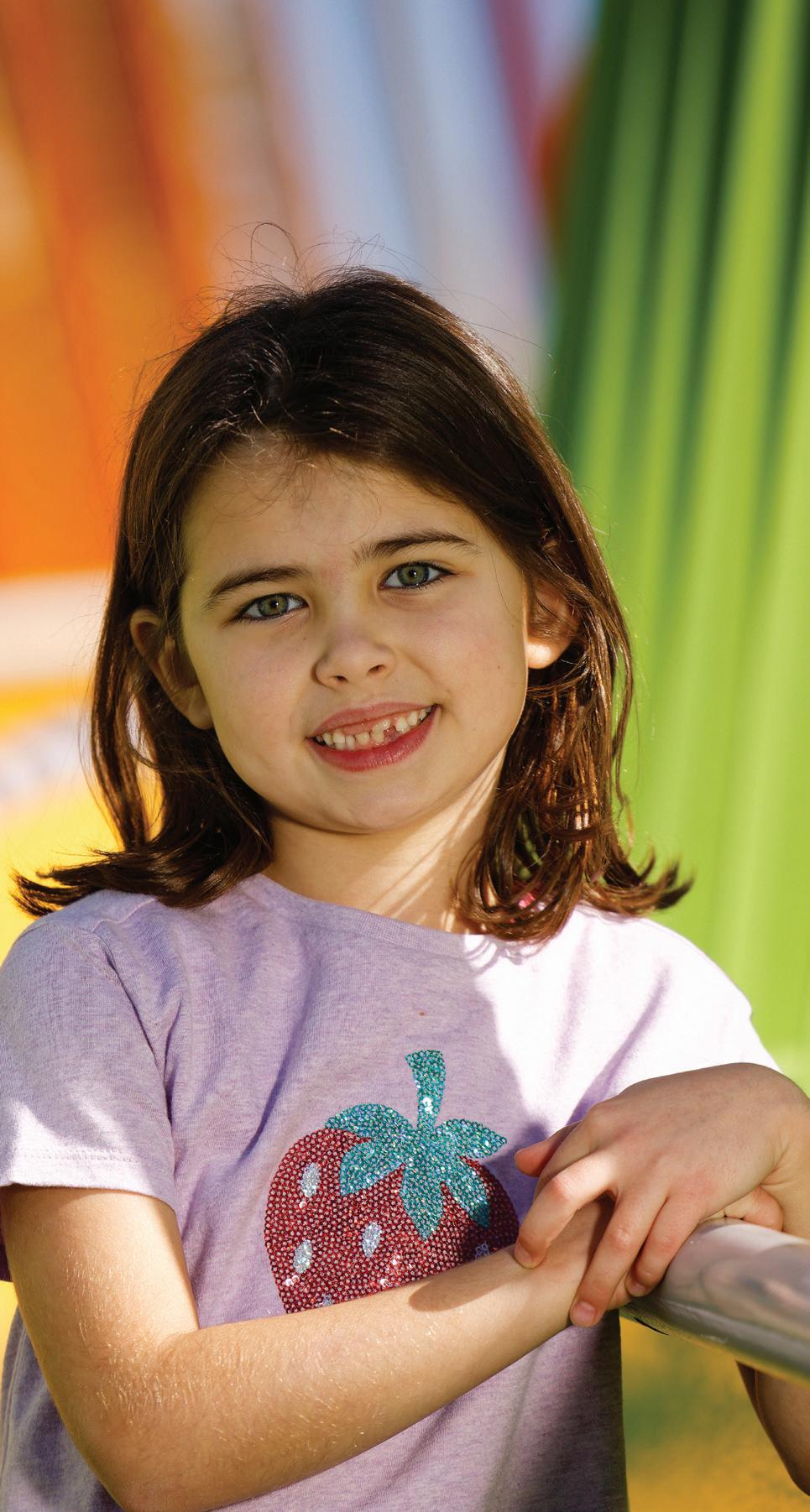
Eden Arbery, 7.
Foreword
For 35 years The Kids Research Institute Australia has been making life-changing discoveries, developing evidence-based solutions to major health issues and using the latest technology to find answers to the biggest problems facing the health and wellbeing of children and young people.
Our world-leading researchers have identified early intervention programs for children with developmental delays, found that folic acid in a mother’s diet before and during pregnancy helps prevent neural tube defects, played a pivotal role in the introduction of world-first respiratory syncytial virus immunisation that has saved many lives and prevented hundreds of babies being hospitalised, and identified that a new immunotherapy in combination with standard-of-care chemotherapy improved survival rates for babies with leukaemia.
But our job is far from finished. In 2024 we launched our new strategic plan, Research Reimagined, in which we have committed to having an even bigger impact on the health and happiness of kids over the next decade.
Under this 10-year blueprint, we have pledged to work with the community and key stakeholders to deliver research with greater impact, quicker. Research Reimagined aims to establish a pipeline of breakthroughs for tomorrow, acknowledging that these discoveries are fostered within an environment that identifies the major challenges affecting kids and tackles them systematically and holistically.
In true partnership and collaboration with community, we want to identify the biggest challenges for families and drive our research to those areas it is going to have the most impact.
In this year’s Impact Report, we provide an overview of just some of the projects our scientists are working on to achieve this goal.
They include a new early-stage type-1 diabetes (T1D) clinic that has opened at Perth Children’s Hospital which will radically change diabetes care and support for families navigating an early stage T1D diagnosis, and a remarkable story about how our scientists cracked the genetic code to identify the rare disease a 10-yearold Northam girl was born with.
We also explore the impact the new WA Comprehensive Kids Cancer Centre is going to have on children
diagnosed with cancer and how a collaborative partnership in WA’s Great Southern is helping kids’ dental health.
I hope you enjoy reading about the most significant projects being undertaken at The Kids and how we are working toward a better future for happy, healthy kids, everywhere.
Professor Jonathan Carapetis AM Executive Director

Executive Director Professor Jonathan Carapetis AM.
History of The Kids
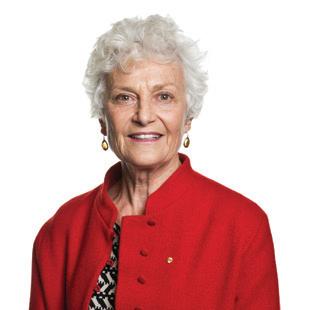
JUNE: The WA Research Institute for Child Health is officially opened. Fiona Stanley is the inaugural Director of the Institute
• Princess Margaret Hospital and The University of Western Australia executives meet to discuss the need for a child health research unit.
• Working party formed, chaired by Lou Landau, to consider establishment of an independent research institute.
• Paediatrician Lou Landau and epidemiologist Fiona Stanley envision a multidisciplinary institute for scientists, researchers and clinicians to investigate the causes, prevention and management of childhood diseases and disability.
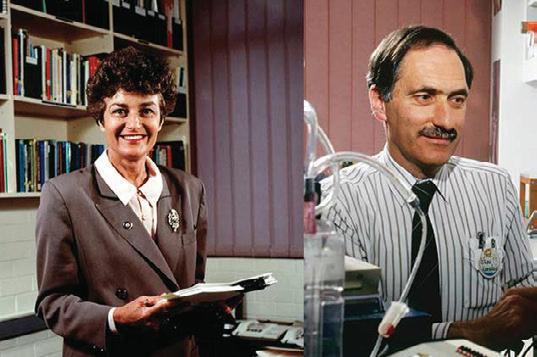
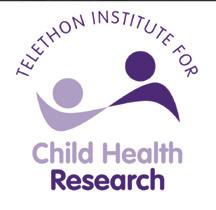
2011 new logo
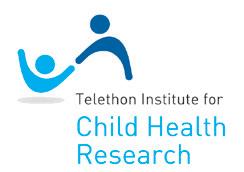
JUNE: The Institute changes its name to Telethon Institute for Child Health Research in recognition of the ongoing support from Western Australians through Channel 7’s Telethon
MARCH: The Institute changes its name to the Institute for Child Health Research
1997

SEPTEMBER
GovernorGeneral, His Excellency Sir William Deane officially opens the Roberts Road building
JULY: The Institute raised $11.2 million dollars, matched by both State and Federal Governments to build a new home at 100 Roberts Road, Subiaco
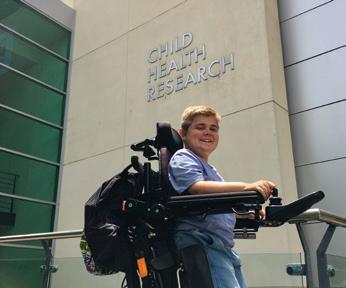
JULY: Plans announced to build a stateof-the-art research facility for the Institute within the new children’s hospital on the QEII Medical Centre site
DECEMBER: Fiona Stanley retires
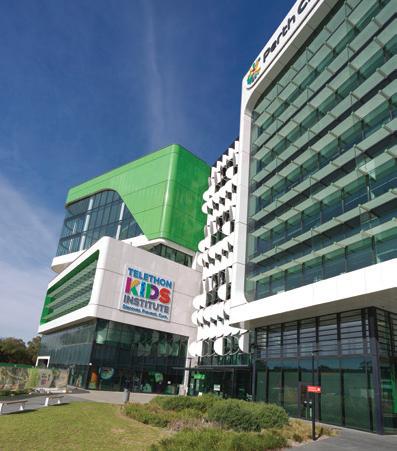
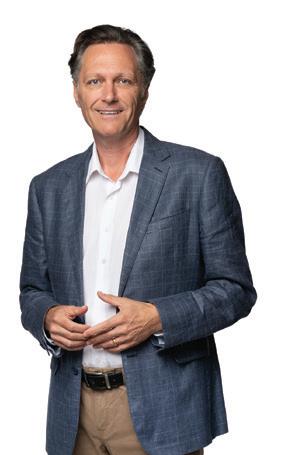
JULY: Jonathan Carapetis is appointed the Institute’s new Executive Director

AUGUST: The Institute moves to its new home at the new Perth Children’s Hospital
FEBRUARY: The Institute changes its name to Telethon Kids Institute
WA Governor Chris Dawson and Mrs Darrilyn Dawson become Patrons of the Institute
NOVEMBER: Telethon Kids Institute together with Telethon Speech and Hearing and Telethon, announce that by mutual agreement, both organisations will stop using Telethon in their name. This reflects the growing reach and number of beneficiaries of Telethon

AUGUST: The Institute changes its name to The Kids Research Institute Australia, to be known as The Kids
Our Impact
Here is what we achieved in 2024
27 Clinical trials
Awarded
$50.2 million in research funding
75 We submitted
Non-clinical trials
317 grant applications
Researchers received 83 % of the funding pool from the WA Child Health Research Fund
Our work was cited in
272 policy documents from 24 countries This includes 58 such as the World Health Organization, United Nations and World Bank
policy documents published by Intergovernmental Organisations,
Our total body of 7,266 publications gained more than 45,000 new citations Our research contributed to
146 of our articles had a CNCI greater than two
648 publications
46 researchers had a Scopus H-index greater than 40
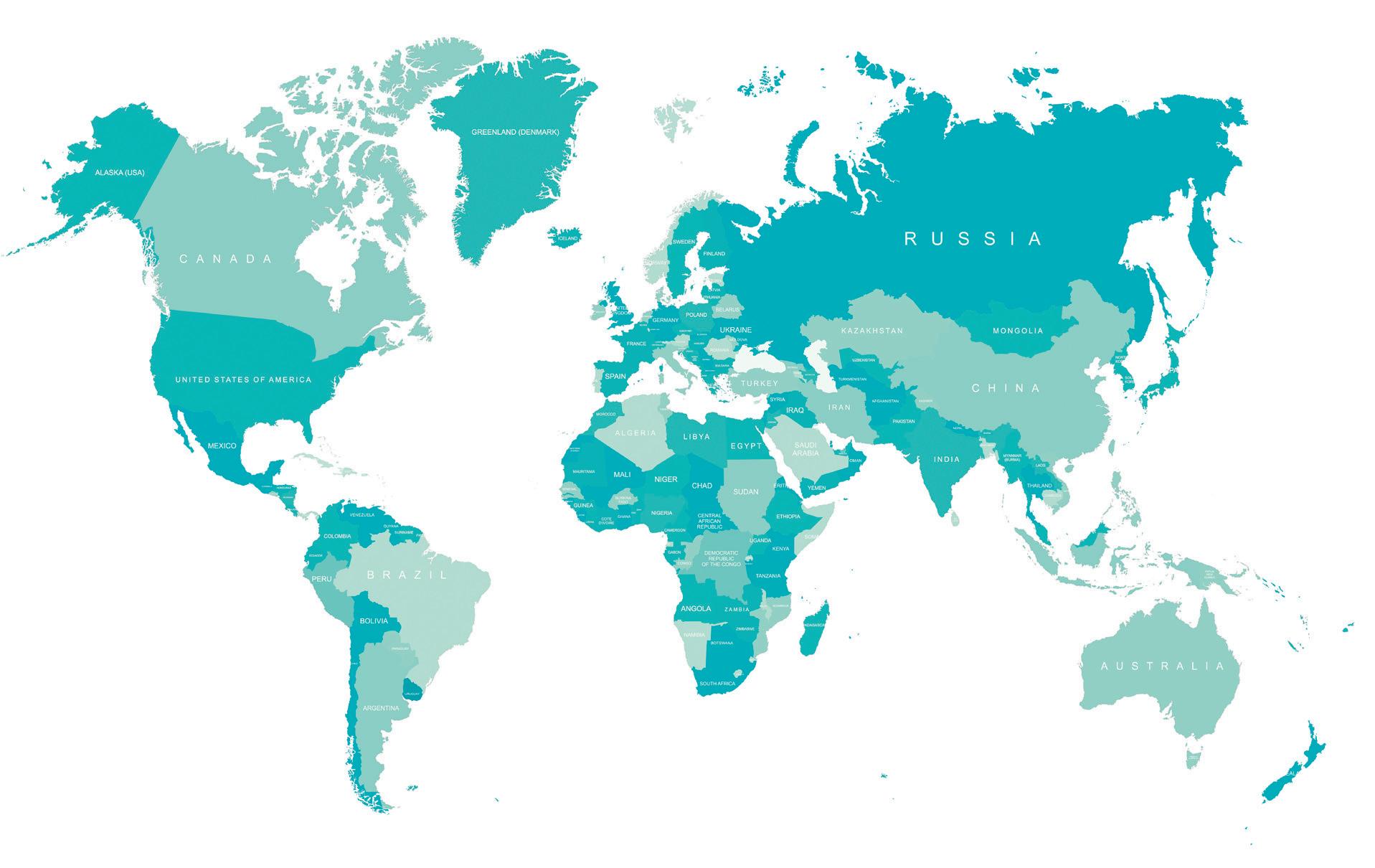
2.83
5,469
35 years of thinking of the kids
In its simplest form, science is about asking questions and finding answers. But it’s what we do with those answers that truly makes a difference. At The Kids Research Institute Australia, we want our research to have impact so we can change the lives of children and young people for the better.
CHILDHOOD SARCOMA Worldfirst immunotherapy gel applied inside wound after removal of solid tumours showing promising results in reducing recurrences

HEALTHY SKIN Developed national healthy skin guidelines to guide diagnosis and treatment of skin sores, scabies and fungal infections
DEVELOPMENTAL DELAYS
Game-changing early intervention program for children showing neuro-development delays
INFANT LEUKAEMIA Survival improvements of 50-80% using new immunotherapy in combination with standard-of-care chemotherapies

EAR INFECTIONS Nasal therapy to prevent childhood ear infections – which are the major cause of childhood hearing loss
CYSTIC FIBROSIS Led paradigmchanging discoveries that lung changes can be detected early in CF, changing life trajectories with early interventions
RHEUMATIC FEVER Developing a diagnostic test for RF instead of current diagnosis based on clinical features
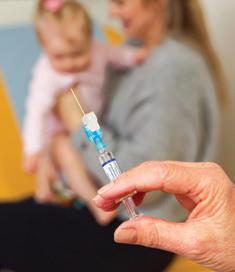
RSV Took part in two gamechanging trials investigating a world-first RSV immunisation for babies
Our epidemiological research helped identify best immunisation targets for Australian-first immunisation program for babies
VACCINES Conducted pivotal trials that contributed to the licencing of more than 10 childhood vaccines
STREP A VACCINE Leading the world in developing a platform to accelerate vaccines for Strep A
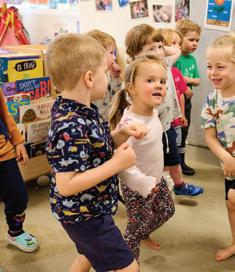
PLAY ACTIVE Evidence-based program of physical activity for childcare centres launched nationally
EARLY YEARS CENSUS Led the development and adoption of first national census of early childhood development
RHEUMATIC HEART DISEASE
Developed a blueprint for eliminating RHD in Australia
CEREBRAL PALSY Developed the first cerebral palsy register in Australia
CHILDHOOD BRAIN CANCER
Led trans-Tasman clinical study to validate a new diagnostic test for kids with brain cancer to better understand genomic characteristics of tumours
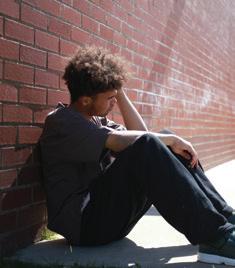
SUICIDE CLUSTER Spatial epidemiology used to identify suicide clusters
CYBERBULLYING Developed Beacon – a cyber safety app for parents

MALARIA Using cutting-edge geospatial modelling to track and monitor malaria to inform control interventions, policies and programs
FETAL ALCOHOL SPECTRUM DISORDER Developed and implemented a diagnostic tool for fetal alcohol spectrum disorder in Australia
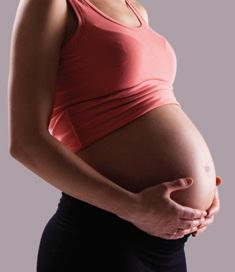
AUTISM Key role in the development of national guidelines to assess and diagnose Autism Spectrum Disorder in Australia
CHILD DISABILITY Broke the mould for how quality of life is measured in intellectual disability
RARE AND UNDIAGNOSED
DISEASES Pioneering genomic interrogation tool integrated into a national initiative, aiming to elevate diagnostic rates for rare diseases to over 70%
TYPE 1 DIABETES First in Australia to introduce insulin pump therapy to children with diabetes. Now at the international forefront of trials of an artificial pancreas
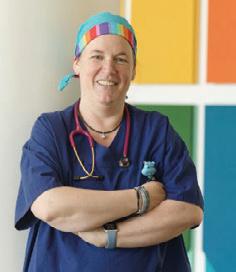
PERIOPERATIVE CARE Developed chewable tablets giving children sensation of a full stomach to reduce stress of fasting before surgery
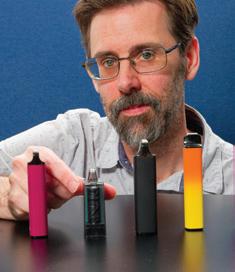
FOLATE Helped discover that folic acid in a mother’s diet before and during pregnancy helps prevent neural tube defects
RESPIRATORY DISEASE
Demonstrated the important role of safe sun exposure and Vitamin D during pregnancy for the development of a baby’s lungs, brain and bones
VAPES Found the majority of e-cigarettes contained known lung toxins and potential carcinogens
SUPERBUGS Opened WA’s first phage manufacturing facility which could see patients battling antibiotic-resistant superbugs have access to life-changing therapies

SCREENTIME World-leading study found toddlers exposed to screentime at home are hearing fewer words and making fewer vocalisations
VIRTUAL WA
Developed a digital replica of the State to inform public health policy on matters including asthma, obesity and suicide
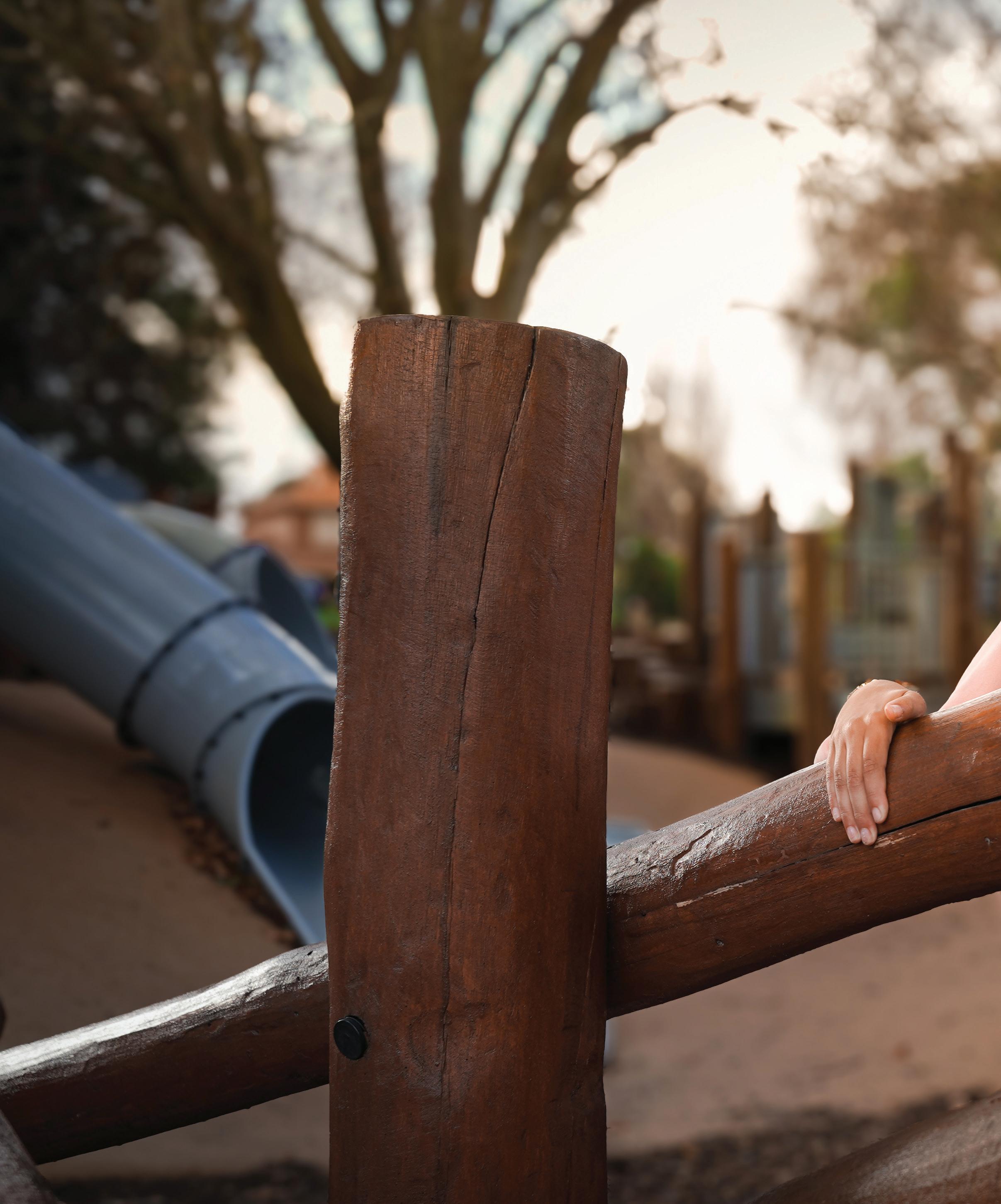

Director of First Nations Strategy and Leadership
Associate Professor Glenn Pearson with siblings Summer Skeen, 12, and Andre Skeen, 11.
Research that has been actively translated into policy or practice.
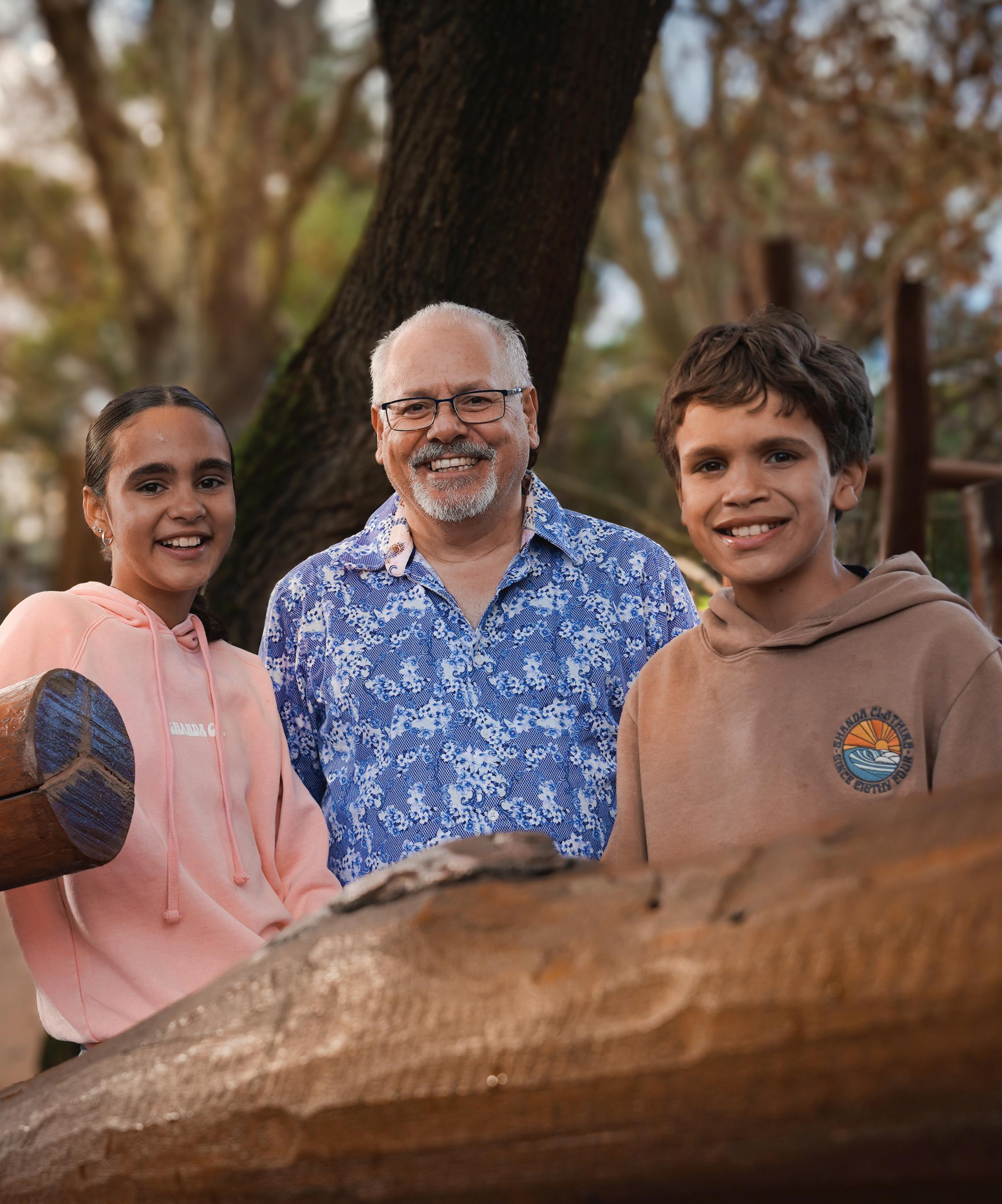

Charlotte Duffy and her twins Finn and Ember were among the first babies in WA to receive an RSV immunisation.

RSV hospitalisation admissions slashed by new immunisation program
An Australian-first study demonstrating the effectiveness of a new immunisation against respiratory syncytial virus (RSV) for babies found it to be almost 90 per cent effective in reducing hospitalisation rates.
Led by researchers at the Wesfarmers Centre of Vaccines and Infectious Diseases, based at The Kids Research Institute Australia, the REVIVE Study investigated RSV-related hospital admissions following the introduction of WA’s immunisation program providing babies with a long-acting monoclonal antibody called nirsevimab.
Affecting the airways and lungs, RSV is a lifethreatening virus responsible for sending 3.6 million children to hospitals worldwide each year. It is especially dangerous for vulnerable young babies at high risk of potentially deadly complications such as severe bronchiolitis and pneumonia.
In 2024, Western Australia was the first Australian State to offer a free RSV immunisation program for all babies born throughout the winter season, providing more than 24,000 doses of nirsevimab throughout April to September last year.
Lead author of the REVIVE Study, Dr Ushma Wadia, said the program was found to be extremely effective, with the immunisation roll-out helping more than 500 babies avoid a hospital admission caused by RSV.
“Working alongside WA Health and Pathwest to evaluate hospitalisation rates at Perth Children’s Hospital, Fiona Stanley Hospital and Joondalup Health Campus has allowed us to become the first place in the southern hemisphere to successfully demonstrate the major impact of RSV immunisation in young babies,” said Dr Wadia.
“The data gained from the REVIVE Study aligns with outcomes from research conducted in the northern hemisphere and can now be used as evidence to inform vaccine policy throughout the world, including in lower-income countries where morbidity rates for RSV are at their highest.”
The success of WA’s nirsevimab program also contributed to the roll-out of a national, $174.5 million RSV immunisation program now underway for all pregnant women and newborn babies which hopes to keep 10,000 Australian babies out of hospital each year.
New guide for families
Researchers from the STAMP RSV program have developed an online tool designed to help WA families and health-care providers learn the best way to protect babies and young children against RSV.
Designed to help parents understand which RSV vaccines or immunisations they are eligible for as part of Australia’s new RSV Maternal and Infant Immunisation Program, the guidance tool provides users with recommendations based on answers provided to a series of questions, such as stage of pregnancy, the time of year and family background.
The tool then provides information according to criteria set by the WA Department of Health, letting parents know their eligibility for a vaccine given to pregnant women and/or a monoclonal antibody for the baby at or after birth.
Developed in consultation with the STAMP team’s RSV Community Reference Group, it is hoped the new tool will help empower the community to make their own decisions when it comes to providing their baby with the best possible protection against RSV.
Scan the QR code to use the RSV Immunisation Guidance Tool.
NEXT STEPS


• In addition to continued monitoring of WA’s RSV immunisation program, the Wesfarmers Centre is leading the evaluation of the national RSV PAEDS-FluCAN program.
• PAEDS-FluCAN, funded by the Commonwealth Department of Health, is a hospital-based surveillance program for patients with RSV at 23 sites throughout Australia.

The REVIVE Study is funded by Perth Children’s Hospital Foundation, in addition to support from the Stan Perron Charitable Foundation for the Wesfarmers Centre’s on-going STAMPRSV research program.
STAMPing out RSV in Western Australia
The STAMP RSV program, led by Associate Professor Hannah Moore, The Kids Infectious Disease Theme Head, aims to maximise uptake of new and emerging RSV immunisation strategies by providing the evidence to inform public health policy.
The STAMP RSV program comprises three interrelated work areas:
1. Raising Community Awareness
The STAMP team is currently working alongside three stakeholder groups to address community attitudes around RSV immunisation.
Aboriginal and Torres Strait Islander families: researchers are yarning with Aboriginal families in regional towns such as Kalgoorlie and Geraldton to explore how RSV affects families in these areas. By conducting World Cafés with the local community, the team aims to gain two-way understanding around the introduction of the new national RSV immunisation program and ensure the development of culturally appropriate information resources.
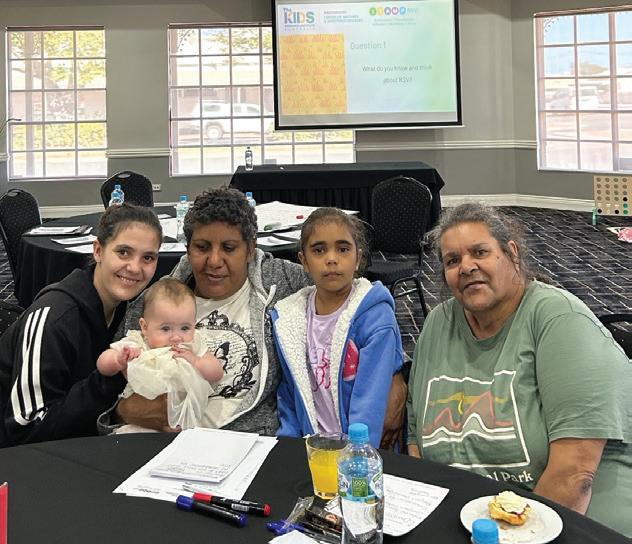
Multicultural parents and carers: the team held a Community Conversation at Sudbury House in Mirrabooka to discuss conducting focus groups with different language and cultural groups. They will also engage with the Refugee Health Clinic at Perth Children’s Hospital to assess RSV and immunisation knowledge among the refugee population.
Parents of children with increased medical vulnerability: children who have existing health complexities are at increased risk of life-threatening complications of RSV, so researchers are speaking to families who can contribute valuable insights into prevention and care strategies for at-risk populations. A recent partnership with Down Syndrome WA has helped to connect researchers with families who are now helping to shape the future of RSV immunisations.
2. Enhancing Surveillance
The surveillance of STAMP involves the REVIVE study, looking at RSV hospitalisation and the effectiveness of RSV-preventative products. We know very little about how many RSV infections occur with mild or zero symptoms in the community. To address this knowledge gap, the STAMP team have launched the PATROL Study – ‘Parents Actively Tracking RSV in Little Ones’. Families with children aged four and under who attend daycare or kindy on a regular basis are invited to participate and monitor their children for potential infections to learn how often children are getting RSV each year.
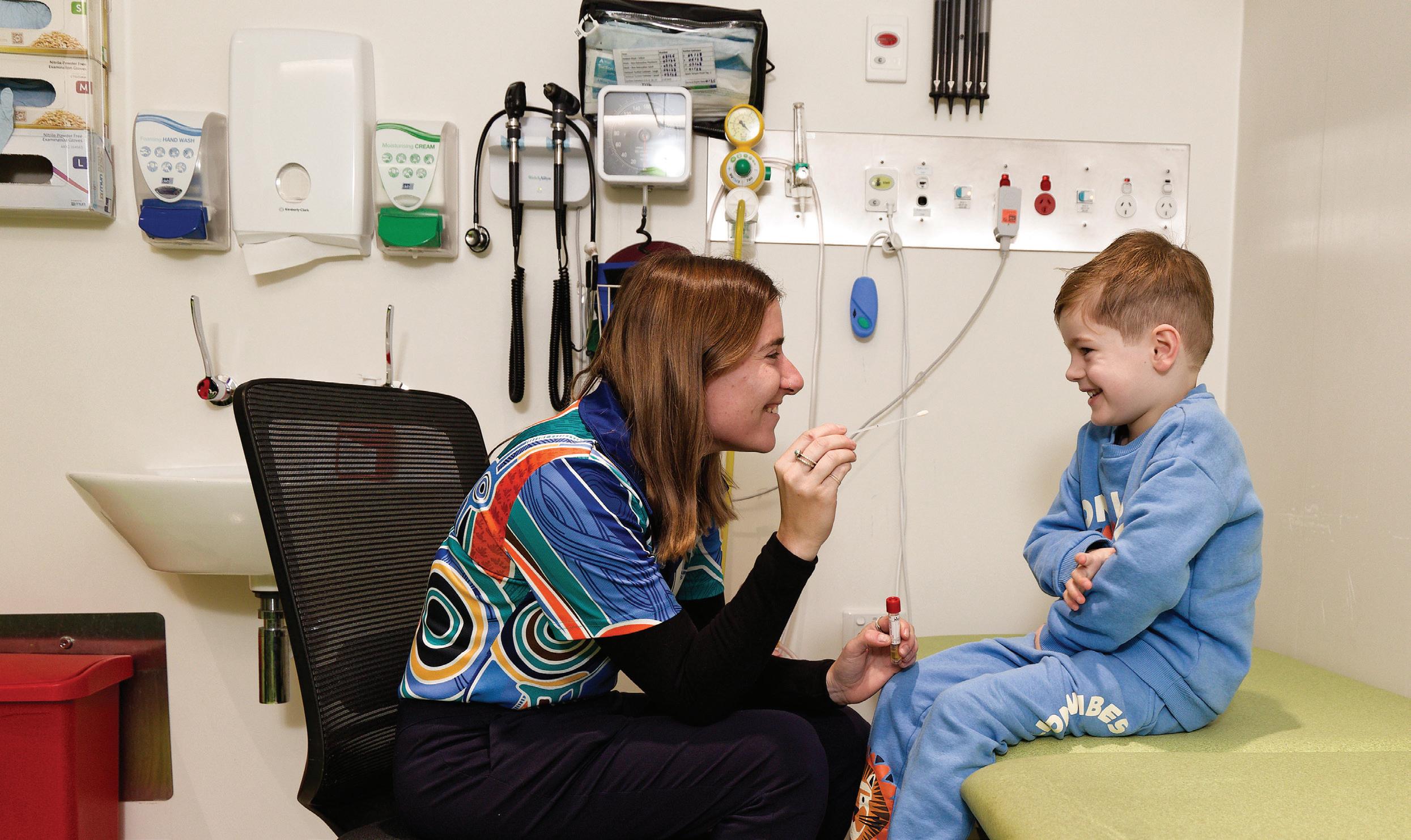
World cafe.
3. Population Dynamics
The third aspect of STAMP RSV uses population-based linked data to refine dynamic transmission models and predict the impact of various immunisation scenarios. These mathematical models have been constructed to mimic the real-world epidemiology of RSV observed across temperate WA, and replicated the success of the 2024 nirsevimab immunisation program. The STAMP RSV team is now adapting these models to look at maternal vaccine and infant immunisation in a hybrid approach to provide evidence for the most beneficial immunisation program.
$3.4 million funding boost supercharges fight against RSV
The RSV team back row, left to right: Cathy Pienaar, Anita Williams, Dhruv Shah, Marlene Rychner, Fiona Giannini, LeslieAnn Conway, Joanne Harvey. Front row left to right: Carla Puca, Hannah Moore, Chris Blyth, Minda Sarna.
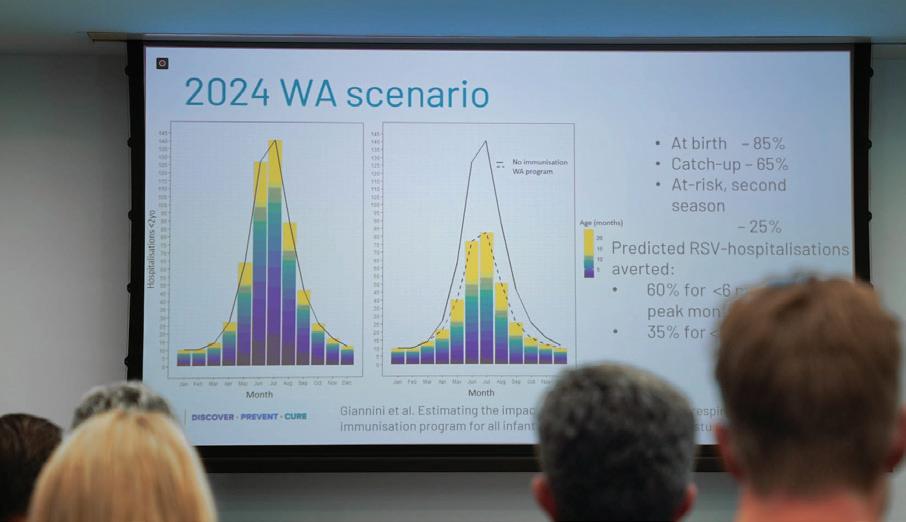

RSV research led by the Wesfarmers Centre has secured more than $3.4 million to assess the epidemiology of the virus throughout the country and optimise Australia’s immunisation strategy.
Building on the work of the STAMP RSV program on a national scale, the RISE Partnership Project, which stands for Modelling RSV Immunisation Strategies for Evidence-based Policy, has been awarded a $1.5 million National Health and Medical Research Council Partnership Grant, as well as Future Health Research and Innovation Fund cofunding of $1 million from the WA Government.
RISE has also received $880,000 in support from WA Department of Health, Child and Adolescent Health Service, PathWest Laboratory Medicine WA and Immunisation Foundation of Australia.
A collaboration between researchers, policymakers, clinical and laboratory service providers and community advocates, RISE will guide equitable and efficient RSV immunisation policy by using realworld data and mathematical models.
“With this funding, we will be able to harness world-class data, assess the impact of current immunisation strategies, and develop evidencebased tools to guide future policy,” Associate Professor Moore said.
“I’m proud to see this vital research being led out of WA - we are in the unique position of being able to leverage the proven success of Australia’s first-ever RSV immunisation program for young babies launched here in 2024, and we will use this evidence and our expertise in RSV epidemiology and modelling to guide the development of an immunisation strategy designed to provide the best protection for our kids.
“Our ultimate goal is to reduce the burden of RSV and prevent as many hospitalisations as possible, both here in Australia and across the globe,” she said.
STAMP Forum.
Left: Carla Puca testing four-year-old Beau Gleeson for RSV as part of the PATROL Study.
Research breakthrough gives hope to children with rare and undiagnosed diseases
A complex five-year experiment which cracked the code of a genetic mystery has paved the way for faster and more accurate diagnoses of the most rare and unknown diseases affecting children.
Scientists at The Kids Research Institute Australia, together with the Undiagnosed Diseases Program and Perth Children’s Hospital (PCH), combined medical expertise with laboratory investigations and cutting-edge computational biology to uncover a unique combination of cellular characteristics which pinpointed the cause of an undiagnosed disease that has puzzled doctors since 10-year-old Northam girl Charlotte Patterson was born.
The researchers then scoured literature and data from around the world to find other patients with similar traits to match the findings to the condition, which they now believe affects less than 10 people globally.
The findings were delivered to Chalotte’s family by doctors from the Undiagnosed Disease Program (UDP) at PCH.
The quest to find the cause of Charlotte’s condition started in 2019 and was boosted in 2020 by a donation of more than $1.1 million raised at that year’s Channel SevenTelethon Ball.
The Kids’ Precision Health Program Head and computational biologist, Dr Timo Lassmann, said discovering the characteristics of the variant gene which caused Charlotte’s disease was like finding a needle in a haystack.
“Charlotte’s case was extremely complicated and challenging because of the unique characteristics of the variant,” Dr Lassmann said. “Now, as a result of this work, we will be able to apply the process we used to other cases to diagnose unknown diseases more quickly.”
In her short life, Charlotte has been diagnosed with cerebral palsy, seizure disorder, a heart defect, intellectual disability and many physical abnormalities that until now, have been unexplained. She has had 64 surgeries, takes 16 different medications daily and requires a feeding tube.
Her mother, Laura West, said it had been extremely difficult for the family to not know what caused Charlotte’s condition.
“We had no roadmap, no idea what the future might look like or what her lifespan might be,” Mrs West said. “We have just had this endless and ever-growing list of things that are wrong with Charlotte and no idea what caused any of them.”
The Kids’ Translational Genetics Team Head, Dr Vanessa Fear, said the discovery of what caused Charlotte’s condition was astounding. After a complicated process of assessing the genetic variant in the laboratory, The Kids’ researchers discovered the variant was actually changing the basic machinery in cells responsible for the gene and protein expression, and altering the way the neural cells were developing.

Dr Fear said researchers had created a model of Charlotte’s disease in the laboratory so they could not only determine what was causing her symptoms, but also investigate how they could modify cell pathways to improve outcomes for Charlotte.
“I am just really proud to have been a part of this process where so many people have worked every little step of the way, from collecting blood samples to analysing the cells, to finally providing this extremely valuable data we could feed back to Charlotte’s clinician and her family,” Dr Fear said.
UDP lead Dr Gareth Baynam said families with a child with an undiagnosed disease were forced to live in ‘limbo land’ where their world was filled with uncertainty.
“You don’t know what the right treatment is, and you don’t know if you’re receiving the wrong treatment,” Dr Baynam said. “What I hope is that through getting this diagnosis it really does help Charlotte have better health, to have a better
Charlotte Patterson and her brother Josh.
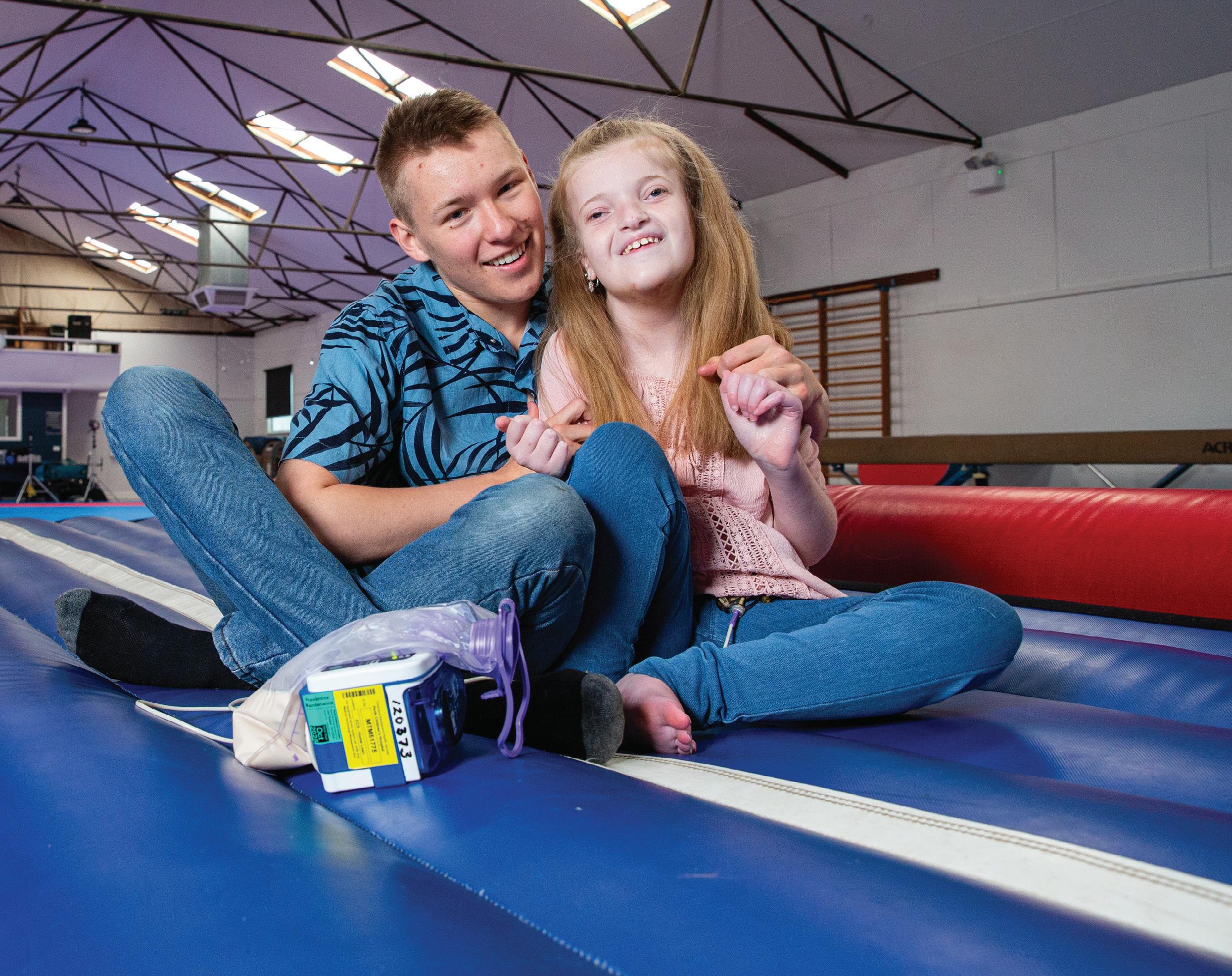
medical home and to have more certainty about what the future brings.
“We
can now unequivocally say that
Charlotte
is going to have a long life. She is not going to go backwards,
there
is a path forward.”
Mrs West said receiving a diagnosis for Charlotte was lifechanging for her family. “It gives us hope for the future,” she said. “I think the best bit was learning that this specific gene variant has just occurred out of the blue. It was something that happened and it’s not hereditary and can’t be passed on.” This was particularly important for Charlotte’s three siblings.
Dr Lassmann said the case underscored the vital role of collaboration between clinical and research teams and highlighted the value of translational genetics teams taking on the most difficult cases.
The Kids Executive Director, Professor Jonathan Carapetis, said the discovery was groundbreaking and set up a pipeline for similar breakthroughs in rare and undiagnosed diseases.
“The work The Kids’ computational biology team is undertaking is world-leading,” Professor Carapetis said.
“They are using cutting-edge technologies and computational science to unlock some of the biggest medical mysteries and help other children with undiagnosed diseases.”

Charlotte and her mother Laura West.
Early-stage type 1 diabetes clinic a WA first
An early-stage type 1 diabetes (T1D) clinic at Perth Children’s Hospital is radically changing diabetes care and support for families navigating the diagnosis of early-stage T1D.
The clinic, an Australian-first co-designed model of care for early-stage T1D, is the result of a collaboration between WA families, the Diabetes Department at Perth Children’s Hospital and the Rio Tinto Children’s Diabetes Centre at The Kids Research Institute Australia.
For 12 months, researchers and clinicians worked alongside WA kids and their families, to better understand what support and education families needed to help manage the early-stage T1D journey and then develop a much-needed model of care.
T1D is one of the most common chronic conditions in children. In Western Australia, there are more than 1,200 children living with T1D and about 150 children are newly diagnosed every year.
Dr
Aveni Haynes, Theme
Lead
for Epidemiology and Early-Stage T1D, said research advances in the field – such as T1D screening programs –meant children could now be identified early in their T1D journey, before they had any symptoms or signs when they are likely still feeling well.
“Identifying the early stages of T1D can occur months to years before kids become unwell and need to start insulin treatment. As research advances continue, such children may be offered treatments in the near future to slow the progression, delaying the need for daily insulin treatment,” Dr Haynes said.
“While some families want to know whether their child has early-stage T1D so that they can prepare and be informed of research or clinical trials available for early intervention, this news can be difficult for many families to come to terms with. Families need to have resources and support available to provide them with advice on what this diagnosis means for them and their child.”
Currently children identified with early-stage T1D, and their families, live with the knowledge that they have a high chance of needing lifelong treatment with insulin, but they do not know when this will happen. Up until now there has been no specific clinic or support pathway available for such families living in WA.
“We wanted to provide a model of care to meet the needs of families living with early-stage T1D, so we undertook a co-design project that included community conversations, workshops and focus groups with community members and health care providers to understand their unique needs and gain feedback on a fit-for-purpose clinic to be established at Perth Children’s Hospital.”
Dr Sarah Black, who is leading the delivery of the resulting early-stage T1D clinic, said the team was excited to launch the new model of care.
“Our research nurses have been working with WA families like these for years and could see the gap in existing care to meet the need for them to be supported in their early diabetes journey,” Dr Black said.
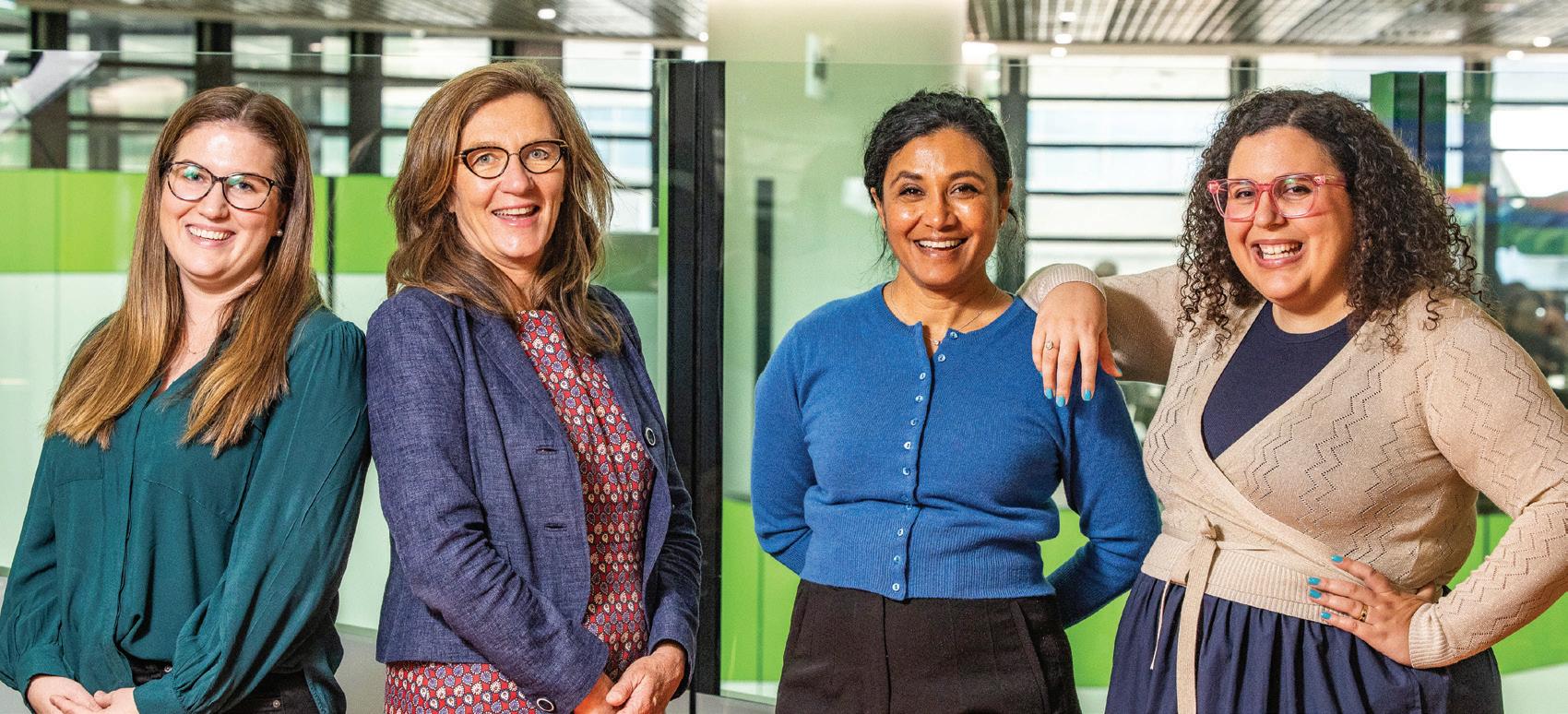
“In this new clinic, WA families will be cared for by a multidisciplinary team and receive medical and psychosocial support and relevant education.
“The goal of this clinic is to create a flexible and adaptable health
Alex Tully, Professor Liz Davis, Dr Aveni Haynes and Dr Sarah Black. Photo courtesy of The West Australian.

care service that evolves with advances in the field and needs of affected families.”
Yvette Saint, mother of Emily, was part of the co-design process following Emily’s early-stage diagnosis. She attended the first clinic in May and said seeing their daughter begin care at the early-stage T1D clinic had been a tremendous relief for their family.
“Knowing she is now in a clinical setting brings us comfort during uncertain times, and having her health closely monitored eases much of the stress we’ve been carrying,” Mrs Saint said.

This new model of care has been proudly funded by Channel 7 Telethon Trust, Rio Tinto and Breakthrough T1D
10-year-old Emily Saint (lives with T1D) with her sister Olivia Saint, 7, who attends the early -stage T1D clinic.
Photo courtesy of The West Australian.
Universal meningococcal protection soon to be a reality
A life-saving meningococcal vaccine covering all five common strains of the deadly disease could soon be available thanks to vital research demonstrating the safety and effectiveness of a combination Men ABCWY vaccine.
Conducted by the Wesfarmers Centre of Vaccines and Infectious Diseases alongside national and international collaborators, the global research published in The Lancet Infectious Diseases and Clinical Infectious Diseases found the combination vaccine to be highly effective in providing universal protection for young adults and teenagers.
A rare but very serious disease, meningococcal can result in death if not recognised and treated quickly, and children who survive are often left with lifechanging health complications such as brain injuries, deafness, severe scarring or amputated limbs.
Professor Peter Richmond – Head of the Vaccine Trials Group at the Wesfarmers Centre, Head of Paediatrics at The University of Western Australia’s Medical School and a paediatrician at Perth Children’s Hospital – said the introduction of the Men ACWY vaccine to the National Immunisation Program (NIP) in 2018 saw a significant reduction in cases caused by the W and Y strains, and the B variant had become the most common cause of meningococcal in Australia.
“There is no single vaccine available that covers the five common strains – A, B, C, W and Y – and while meningococcal B vaccines have been shown to be safe and effective in children and young adults, the low incidence of the disease means it hasn’t been considered cost-effective for inclusion on the NIP,” Professor Richmond said.
“Parents wanting full protection against all five strains of disease must purchase a separate Men B vaccine privately at a significant cost of at least $100 per dose, with each child needing two or three doses depending on age of vaccination – something that may be out of reach for many families.
“Our aim was to show that a combination ‘pentavalent’ vaccine containing the A, B, C, W and Y strains of meningococcal in one injection was safe and would provide the equivalent levels of immunity as the meningococcal B and Men ACWY vaccines given separately when tested against more than 100 variants of the disease.
“Thanks to the success of this research, the combination vaccine was recently approved by the FDA for use in the US for older children and young adults aged 10 through to 25 years, and we hope to see it licensed in Australia in the near future.
“Ideally, we would like to see this vaccine replace the current Men ACWY vaccine given to all teenagers in Year 10 at high schools throughout Australia, and our research going forward will focus on studies demonstrating its safety and efficacy for babies and toddlers in the hopes of future inclusion on the NIP from 12 months of age.
“This would be the best way to eradicate meningococcal disease in children and give parents the peace of mind that their child has the highest possible protection against this devastating disease – an outcome we are certainly looking forward to achieving in coming years,” Professor Richmond said.

NEXT STEPS
Additional vaccine research currently underway at the Wesfarmers Centre’s Vaccine Trials Group includes:
• Providing broader protection against pneumococcal disease by studying a new vaccine covering 21 bacterial serotypes instead of the 13 in the current vaccine provided as part of the NIP.
• Investigating how burn injuries in children affect their immune system and response to vaccines in the Childhood Health and Immunity PostBurn (CHIP) Study.
• Conducting a retrospective surveillance study looking at the realworld effectiveness of the maternal RSV vaccine for babies hospitalised in Australia.
Difficult journey for Tahlea after fight back from disease
At just six months old, Tahlea Dalgety was flown from Geraldton to Perth with a slim chance of survival after contracting meningococcal disease.
Her mother Chelsea Perrin was told to say goodbye to her beautiful baby girl, but when Tahlea made it through the first critical 48 hours, she thought life would quickly get back to normal for the young family.
“It was October 2018, and I had no idea what lay ahead – I naively thought we would soon be heading home, celebrating Christmas and enjoying the summer holidays,” Ms Perrin said.
“The doctors had to sit me down and explain the road ahead, which ended up being three weeks in the ICU, followed by 162 days on the general ward, and then years of surgeries and skin grafts.
“Returning home to Geraldton wasn’t an option, so we had to relocate to Perth permanently to manage Tahlea’s ongoing medical support.”
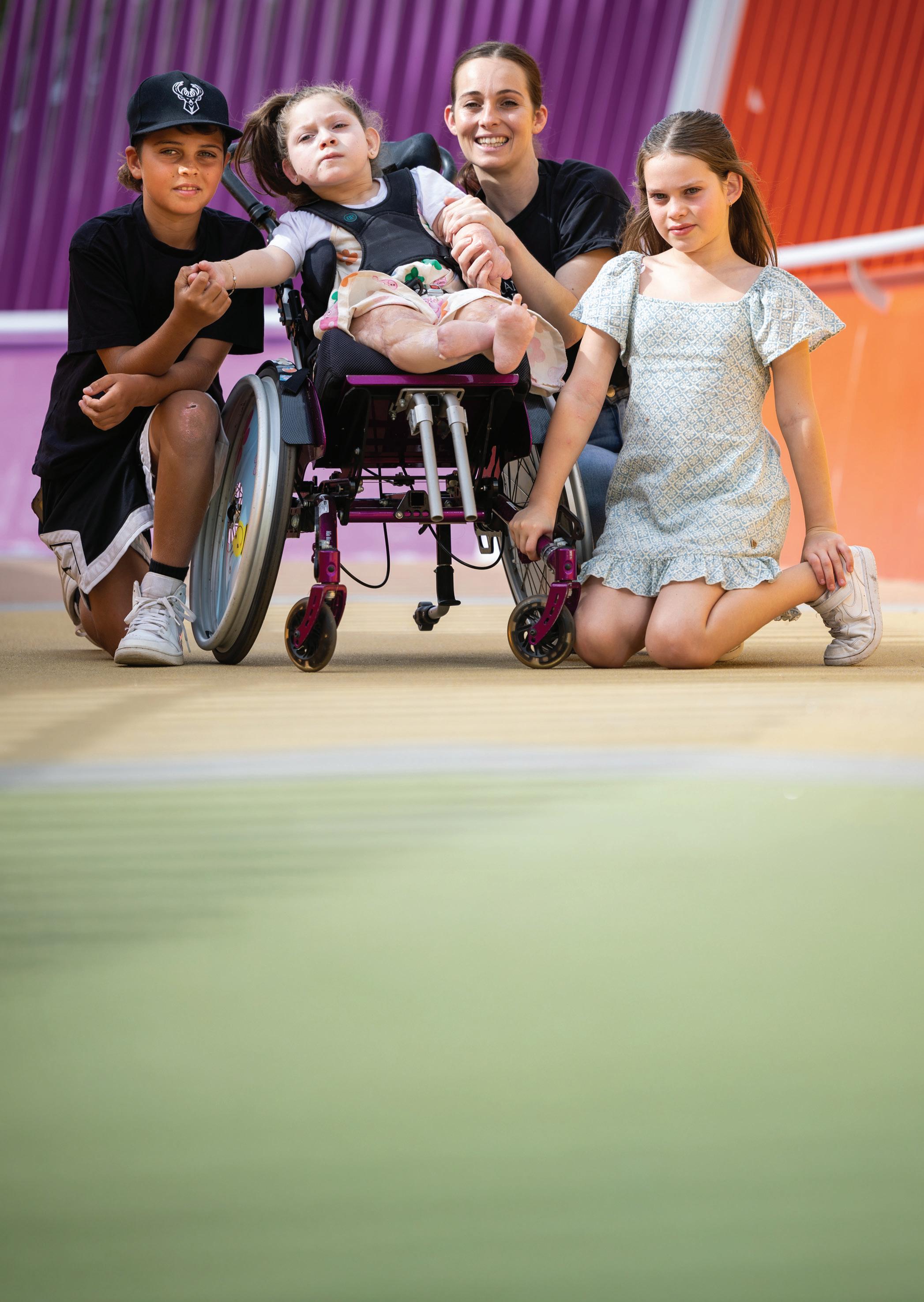
While Tahlea’s fight against meningococcal left her with amputated fingers and toes, scarring to 80 per cent of her body, epilepsy and a brain injury that means she is unable to talk, walk or swallow on her own – she hasn’t let it dampen her bright and cheeky spirit.
Now aged seven, Tahlea enjoys attending her local primary school and loves taking part in dance competitions alongside her big sister Ava.
Ms Perrin said the introduction of the combination vaccine to the National Immunisation Program would be a game-changer for families.
“Meningococcal is not a game, and it doesn’t discriminate – every child deserves full protection against this terrifying disease and I’m so thankful this research will make that possible.”
Above image: Mum Chelsea Perrin with her children. left to right, Kai Dalgety, 11, Tahlea Dalgety, 7 and Ava Dalgety, 9.
Photo courtesy of Andrew Ritchie - The West Australian.

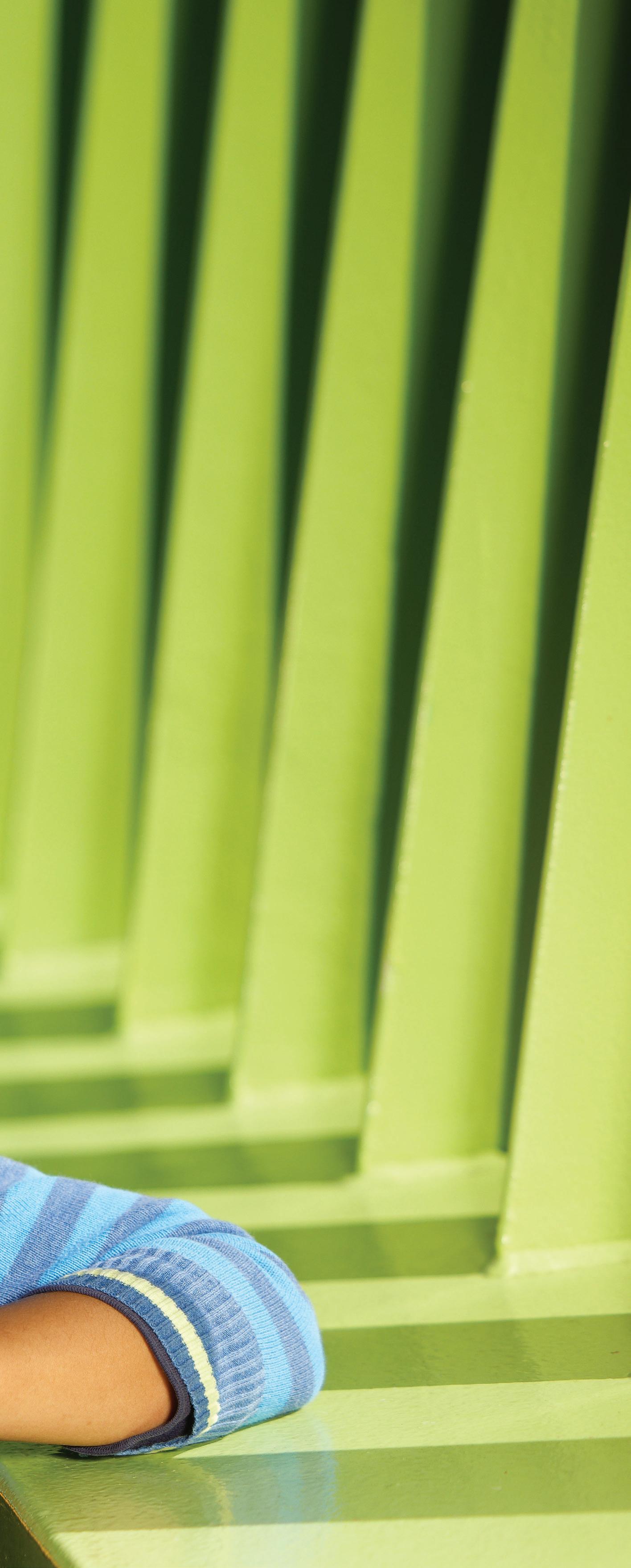
PARADIGM SHIFT
Research that changes the very way we think.
Seven-year-old Dhani Morkel on The Kids' Bridge near Perth Children's Hospital.
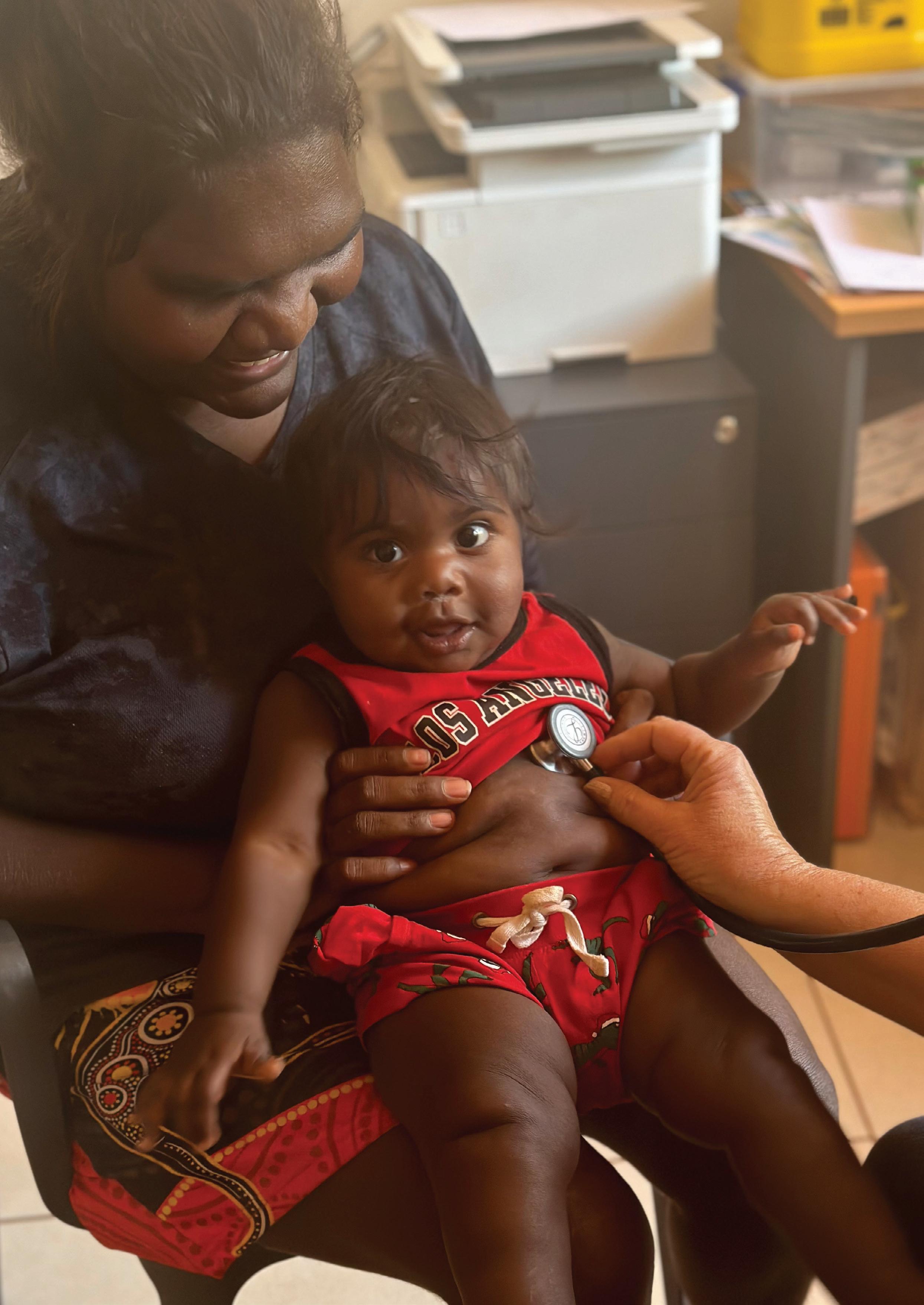
Shemiah Atkins at the health clinic with her son Jeremias, 2.
Multi-partner project gains longevity thanks to support from BHP and Channel 7 Telethon
An ambitious five-year multi-partner project to improve health and wellbeing outcomes for Aboriginal children across three Western Australian sites, supported by BHP through the Channel 7 Telethon Trust, has been a springboard for additional support and funding to enable key initiatives to continue.
Using a comprehensive, community-designed and familycentred approach, Journey Together - driven by Scientific Lead Professor Alex Brown and Director of First Nations Strategy and Leadership Associate Professor Glenn Pearson from The Kids - combined research, action and advocacy in partnership with communities, families and services in Port Hedland, Newman and Perth.
Associate Professor Pearson said, at its core, the Journey Together Initiative blended research, data analysis, action and advocacy to foster meaningful partnerships with Aboriginal families, communities and service providers.
“The Journey Together Initiative has explicitly focussed on supporting local Elders, using local services, programs and their governance methods to ensure community priorities are identified and acted on,” Associate Professor Pearson said.
He said the success of the Initiative stood as a testament to the power of collaboration, local leadership and datainformed decision making in creating meaningful, lasting impact.
Critically, the Journey Together Initiative has enabled essential services delivered by project partners to secure significant extra funding to ensure the sustainability of many of the programs introduced under the Initiative.
Associate Professor Pearson, said extending the life of the Journey Together Initiative was an important objective of the project team.
“Across the five years of the program, investment in local capacity building has been a key pillar to build and enhance the sustainability of the work. This includes employing and training local workers who understand the local context and who can identify the strengths that exist within communities to draw on and to deliver successful outcomes.”
“We said at the outset that we wouldn’t wait until the end of the project to act on what we learn. The communities and services we are partnering with have identified priorities, and by embedding research into these projects we have had impact, and evolved throughout the project’s life.”
A priority project in each location was identified to respond to immediate local need.
Newman and Western Desert Perinatal
Care and Early Childhood Development
For pregnant women living in WA’s east Pilbara, significant issues systematically impede their pregnancy journey and a safe healthy start to life for their babies.
The Puntukurnu Aboriginal Medical Service (PAMS) identified gaps including a lack of access to timely and culturally appropriate antenatal and postnatal care, particularly in Newman; lack of access to clinical and emotional care and appropriate accommodation for women waiting to give birth in Perth or Port Hedland, causing stress; and the need for better coordination between different clinical services after birth and for babies and young children.
In response PAMS developed the Upstream Health (Perinatal and Early Child Development) Project with the aim of creating better conditions for babies and children to start their life with strong foundations.
Significant achievements in the life of the project have included:
• Support for 129 pregnancies
• Health checks for 25 children
• The securing of a new Thriving Families Hub site
• Establishment of a Women’s Advisory Group
• Evaluation of the Upstream Model of Care

Antenatal checks have been a critical part of the Newman priority project.
Perth Integrated Developmental Paediatric Care
Derbarl Yerrigan Health Service (DYHS) developed a holistic paediatric service unit anchored in primary health care and underpinned by care coordination provided by an experienced nurse and multi-disciplinary team.
Through the development of this model more Aboriginal children have had timely and equitable access to specialist paediatric care in a culturally safe and trusted environment, providing additional support to families before and after visits, and parallel access to GPs and comprehensive primary care services offered at DYHS.
The successful model has seen:
• High clinic attendance, with paediatrician attendance rates consistently higher than 93 per cent
• 320 children case managed by paediatricians through more than 1000 consultations
• Many clients assisted in accessing the National Disability Insurance Scheme
• Fortnightly speech and occupational therapy drop in sessions very well attended
• Fast-tracking of in-house culturally safe autism assessments for older children who may have otherwise faced years of delay in obtaining a diagnosis
• Reduced wait times for Aboriginal families to see a paediatrician
Port Hedland Kumaparniku Wraparound Service
Early in the consultation phase of the project, local Elders through Hedland Aboriginal Strong Leaders, education representatives and others identified that vulnerable families needed help navigating and accessing local support services that were already available in Port Hedland.
With the support of BHP, a research collaboration with Julyardi Aboriginal Corporation was established to develop the Kumaparniku Wraparound Service, providing critical support and service navigation for disadvantaged Aboriginal families with young children in Hedland.
The service centred around goals identified across life domains such as employment, housing, health and family and support is provided through service navigation and brokerage to the family to achieve those goals with the ethos of client empowerment.
The aim of the project is for at-risk families with one or more children under the age of five years to achieve the goals they have identified as important for their family and increase empowerment and self-efficacy, family safety and resources.
The project helped 17 families, including 53 children, achieve personal goals such as securing employment, enrolling in education, finding permanent housing, improving health outcomes and accessing legal assistance.

“The ultimate success of Journey Together will be the result of the way that lessons learned shape future policies – ones which must be more attuned and responsive to the needs and aspirations of Aboriginal families.”
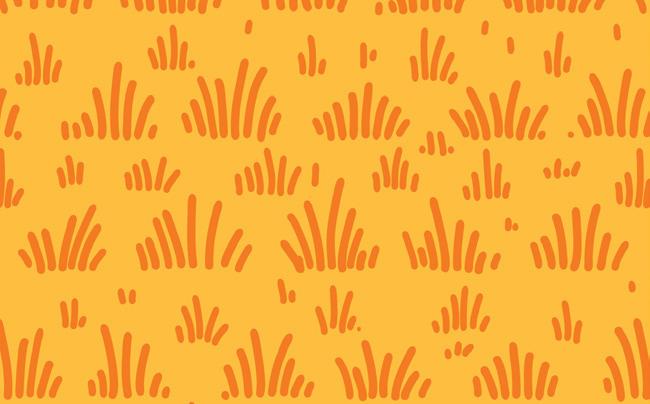
The Journey Together Initiative was funded by BHP via the Channel 7 Telethon Trust
One-year-old Lavina Watson.

Regular health checks have been one of the successful outcomes of the Journey Together Initiative.
The impact of the Journey Together Initiative
Local workforce training and employment
Building relationships and trust
Sustained funding for local projects
Building the evidence base to shift the dial on Closing the Gap
Educational engagement for young kids
Improved relations between services
Reduced wait times for complex paediatric care
Supporting the growth of new community and service leaders
Building local evaluation expertise
Increase in occasions of service
Penicillin breakthrough transforms RHD treatment
A unique study purposely giving participants Streptococcus pyogenes (Strep A) to learn how much penicillin it takes to prevent infection has found the amount needed is much lower than previously thought – a discovery that will transform thinking on treatment for people living with rheumatic heart disease (RHD).
According to findings from the Controlled Human Infection for Penicillin Against Streptococcus (CHIPS) Trial – led by a team of researchers at the Wesfarmers Centre of Vaccines and Infectious Diseases, based at The Kids Research Institute Australia – the concentration of penicillin required to fend off infection is less than half the amount used in treatment protocols delivered to patients for the past 75 years.
The trial, a rare human challenge model, was nine years in the making for lead researcher Laurens Manning, Head of Strep A & ARF Therapeutics research at the Wesfarmers Centre, and Associate Professor at The University of Western Australia’s Medical School.
“As an infectious diseases physician, I’m usually treating people rather than intentionally infecting them, but this unique study model was designed to give us the breakthrough knowledge we need to make radical changes to the current treatment of RHD,” Associate Professor Manning said.
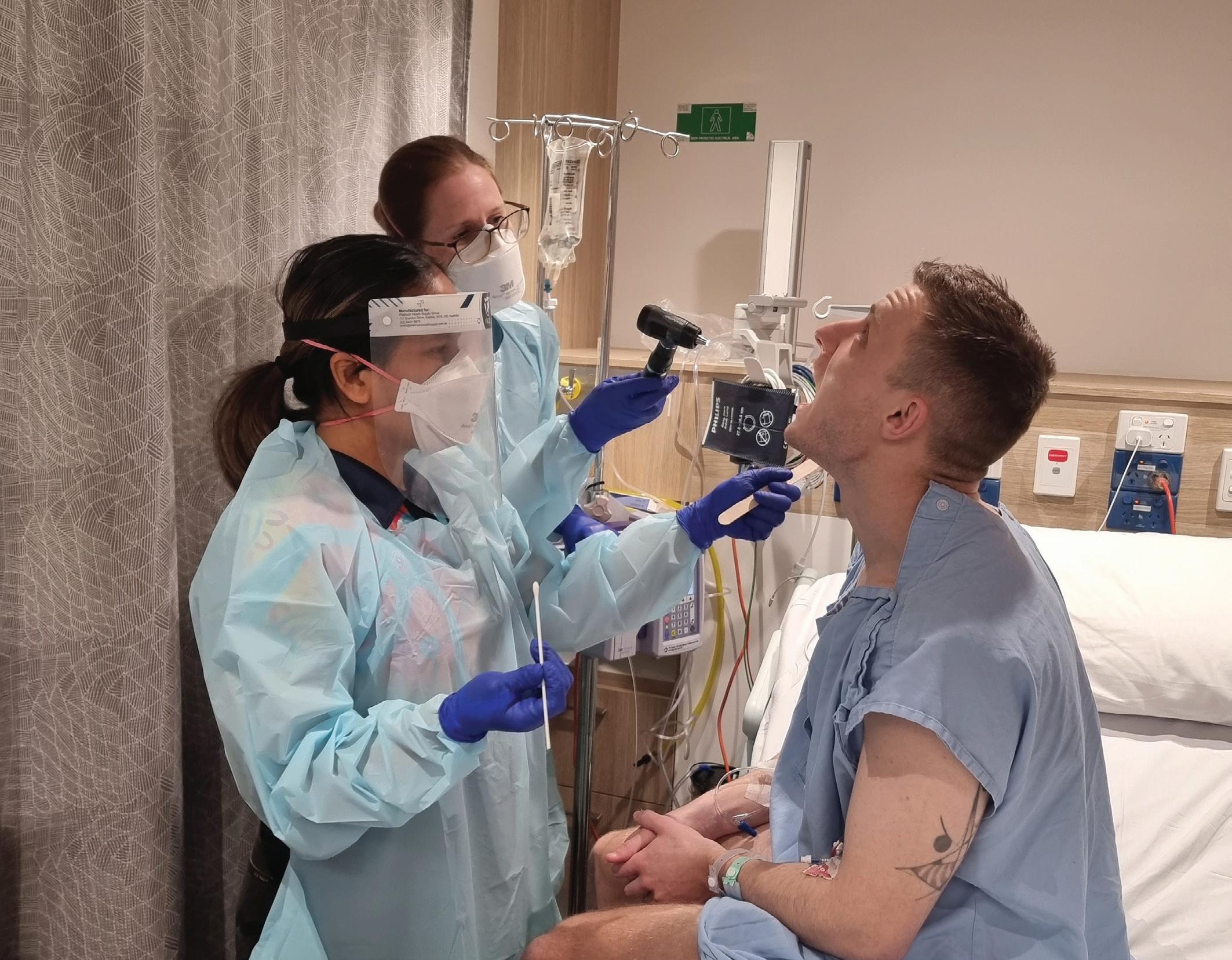
Dr Thel Hla from The Kids and Dr Jasmine Williams from Linear Clinical with the first CHIPS study participant.
“It’s
never been known exactly how much penicillin prevents sore throats – the most common symptom of a Strep A infection – so we decided to embark on a human challenge trial to discover the exact concentration required to protect against infection.”
Responsible for painful sore throats, acute rheumatic fever (ARF) and RHD, Strep A can also lead to lifethreatening kidney disease, sepsis and heart failure. Patients diagnosed with RHD are required to endure painful intramuscular benzathine penicillin G injections once a month over a 10-year period to avoid further infections.
“Back in the 1950s, researchers decided that 20 nanograms of penicillin per millilitre should be the target concentration in the bloodstream for longacting penicillin but this assumption was never actually tested,” Professor Manning said.
"The ‘20’ figure became the golden number to adhere to ever since, but injections delivered into the muscle at that concentration are extremely painful, which makes sticking to the monthly schedule very challenging and many patients do not receive all their required treatments.”
Published in Lancet Microbe, the results showed that just 8.1 nanograms of penicillin per millilitre was required to prevent infection in 60 study participants who were infected with a well-studied, safe strain of Strep A.
“Working alongside Linear Clinical Research, Curtin University and Murdoch Children’s Research Institute, we were able to use cutting-edge science to evaluate patient responses to various levels of penicillin, at super fine margins, to determine the minimum effective penicillin exposure,” Associate Professor Manning said.
“Now that we have a clear target, we can accelerate development of new, long-acting injections, ideally into the skin rather than the muscle, that are considerably less painful and can be given at three-month intervals instead of monthly.
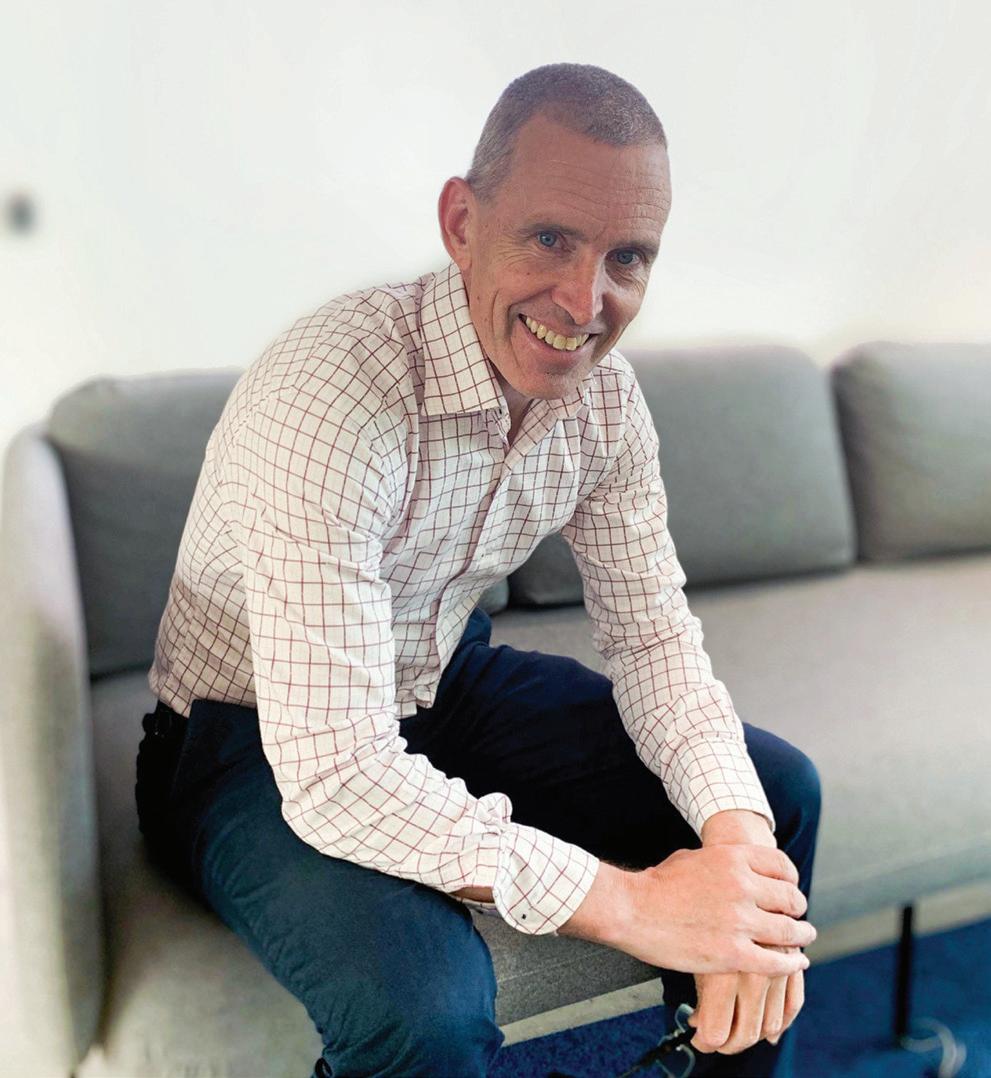
Professor Laurens Manning
“This outcome is very exciting as it underpins everything we have been working on in this space – with these advances in delivery methods and efficiency, we hope to see longer-acting injections embedded in Australia’s national guidelines within the next few years and, in turn, see a dramatic rise in patients receiving the critical treatment they need to prevent potentially deadly rheumatic fever recurrence.”
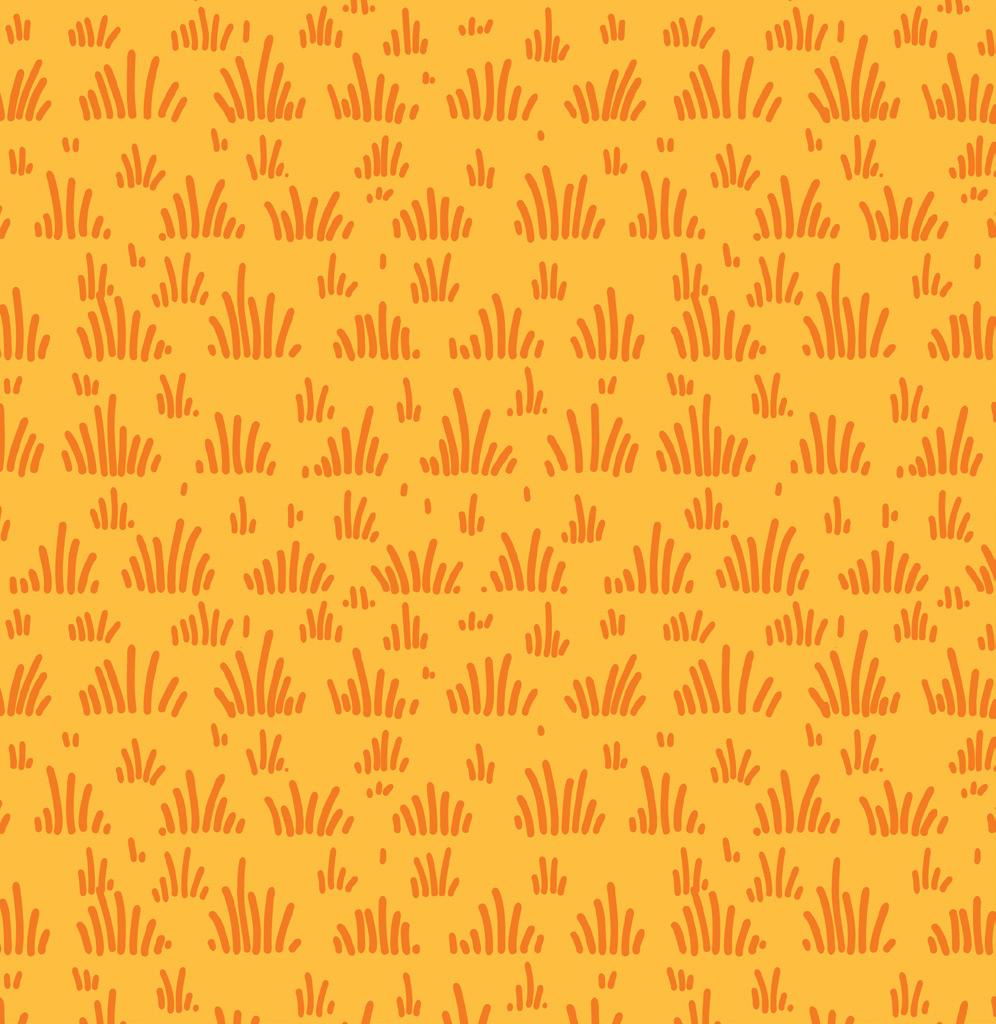
NEXT STEPS
Over 400 of the longer-acting injections, called subcutaneous injections of penicillin (SCIP) have already been administered to study participants in New Zealand to evaluate their effectiveness. The results found SCIP is safe, well tolerated and provides favourable penicillin exposure for most individuals. Further research will now be conducted to understand effectiveness over longer periods and in diverse populations and settings.
Researchers are developing a new treatment formulation made in Australia that aims to be more effective and affordable in comparison to the formulations that are currently available.
Associate
Custom mental health app empowers new mums with lifelong wellbeing skills
Researchers from The Kids Research Institute Australia and Joondalup Health Campus’ ORIGINS project have found their custom app designed to increase mental health skills, has boosted long-term skill use amongst perinatal women 12 months after the study concluded.
Despite many mental health apps currently available, there is minimal research into the uptake and longterm engagement of wellbeing apps amongst perinatal women, with few existing apps targeted to women during and post-pregnancy tailored to build positive mental health and emotional wellbeing.
Identifying this gap, ORIGINS Co-Director Dr Jackie Davis, collaborated with researchers at The Kids to develop and pilot the Mums Minds Matter study - a subproject within the ORIGINS longitudinal birth cohort platform - investigating the most effective resources to support emotional heath before, during and after pregnancy.
“Maternal psychological distress - that is prolonged stress, anxiety and depression - is related to poorer
physical and mental health in mothers, as well as developmental problems in their children,” Dr Davis said.
“Research strongly supports that early intervention and prevention of psychological distress in women is fundamentally important in supporting the mental and physical development of both child and mother.”
"The sustained use of skills learned through the study’s app implies that Digital Mental Health Interventions (DMHIs) have the potential to be an affordable and effective treatment to help mothers struggling emotionally."

Ghislaine Platell with her husband Peter, son Michael, 4, and Hugo, aged 10 months.
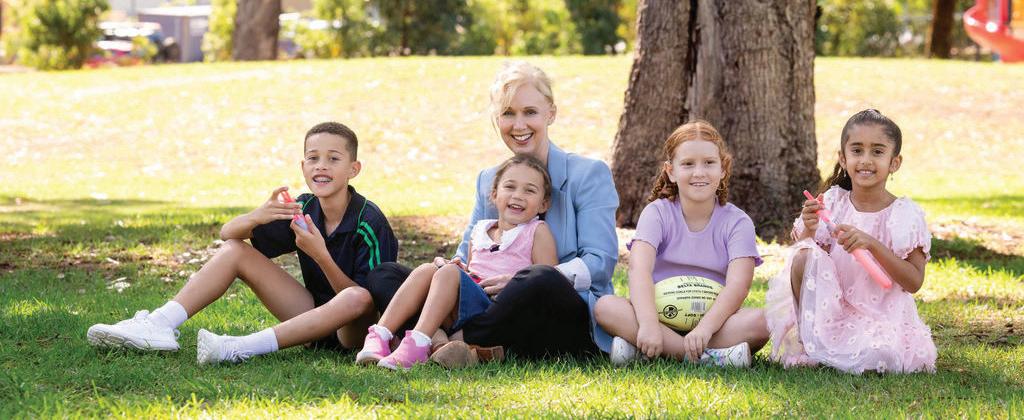
Mums Minds Matter participant, Ghislaine Platell, said the study’s app helped her embrace slowing down and being present - an approach she knew she needed as a parent but found harder to adopt than expected.
“I’ve always dealt with mild anxiety, but after I received my ADHD diagnosis while pregnant with my second child, I joined Mums Minds Matter because I know my mental health is important, and I wanted to know how it impacted my children as well.”
After being randomly selected to receive one of three stress-reduction training programs, participants described how the training has continued to enable regular relaxation through breathing exercises and visualisations, nearly 12 months post program finalisation.
“Having an awareness of your own mental state while you’re parenting enables you to be your best, most calm self, for them,” Ms Platell said.
She said the study highlighted the importance of prioritising her own mental health, as it not only benefited herself but taught her children positive habits.
“It’s so beneficial. I know myself that changing behaviours later in life is trickier in theory. If you know how to do that from the start, you’re going to be a lot better off.”
Dr Davis and the Mums Minds Matter team aim to provide recommendations on the design of current and future mental health apps targeted to perinatal women to increase long-term engagement and mental wellbeing.

Participants enrolled in the Mums Minds Matter study were randomly allocated to one of three stress-reduction training programs created for the study by the research team, including:
Mindfulness Trainingteaches individuals to focus their attention on the present moment in a non-judgmental and accepting way. It helps reduce overthinking, stress, and emotional reactivity by encouraging awareness of thoughts, feelings, and bodily sensations as they arise.
Loving-Kindness and Compassion
Training - This practice involves cultivating warm, caring feelings toward oneself and others.
Participants learn to direct wellwishes and kindness toward themselves, loved ones, and even difficult people, with the goal of building emotional resilience, empathy, and positive social connections.
Progressive Muscle Relaxation - A technique that involves systematically tensing and then relaxing different muscle groups in the body. It helps reduce physical tension and promotes a sense of calm, making it effective for managing anxiety and improving sleep.
Mums Minds Matter is a nested sub-project within ORIGINS, a longitudinal interventional birth cohort study running in collaboration with The Kids Research Institute Australia and Joondalup Health Campus.
ORIGINS is following the health of 10,000 children and their families, providing a wealth of data and biological samples used by researchers investigating early interventions and targeted supports that enable child and family flourishing.
Dr Jackie Davis and ORIGINS participants
Lucas Dine, 9, Chloe Dine, 4, Chloe Whalan, 7, and Xara Bhogal, 5.
New research reveals crushing burden of Tourette syndrome and tic-related disorders
One in two children with a tic-related disorder have thought about ending their life, while one in 10 children and one in four affected adults have attempted suicide, new research into Tourette syndrome has found.
The research, led by The Kids Research Institute Australia and UNSW Sydney, has revealed the crushing daily challenges faced by Australians living with Tourette syndrome and other tic-related disorders.
It found bullying, discrimination, lack of understanding and the exhaustion of living with their condition were among the factors that drove many of those affected to despair.
An estimated 50,000 Australian children and adults have a lifelong tic-related condition, most commonly Tourette syndrome, yet many struggle to obtain an accurate diagnosis or appropriate support.
The national Impact for Tourette’s survey – led by Dr Melissa Licari from The Kids Research Institute Australia and UNSW, and Professor Valsamma Eapen from UNSW – captured the experiences of more than 200 individuals and caregivers across Australia, including their efforts to obtain a diagnosis and treatment, functional challenges, impact on mental health, obstacles faced in education and employment, and the emotional and social struggles experienced by individuals.
Key findings include long wait times for a diagnosis, a lack of knowledge about tic-related conditions among health and education professionals, a lack of effective
support or treatments, and heavy mental health impacts on individuals and caregivers.
“Heartbreakingly, almost three quarters of the adults and one in two of the children with tic-related disorders reported they had contemplated suicide, while one in four adults and one in 10 children had actually attempted suicide,” Dr Licari said.
“A third of the children and almost half the adults had engaged in self-harming behaviours.”
More than 80 per cent of those with tic-related conditions reported experiencing tics daily – many as frequently as every few seconds and some for hours at a time in episodes known as ‘tic attacks’.
Four out of five children and adults had tics that caused physical pain, with two thirds reporting they had sustained injuries from their tics, including lacerations, dislocations and fractures.
“Our report shows three out of four children had been ridiculed or bullied by other students, while a third had been ridiculed or bullied by teachers,” Dr Licari said.
“Two out of five affected adults reported they were unable to work due to the severity of their tics –leading to financial strain – while similar numbers had experienced discrimination in the workplace, including ridicule or bullying by co-workers.”

The report also highlighted difficulties obtaining a diagnosis, accessing treatments, and obtaining disability funding. Three out of four respondents who had applied for National Disability Insurance Scheme (NDIS) funding had had their applications declined despite evidence of significant functional impairment.
“There are currently no national standards or clinical practice guidelines outlining recommended therapies or interventions following the diagnosis of a tic disorder,” Professor Eapen said.
Max Radcliffe, centre, with their mother Vicki Radcliffe, left, and The Kids researcher Dr Melissa Licari.
“One in four respondents reported they had waited more than two years to receive a diagnosis, with some waiting up to four years, while a third of those who did receive a diagnosis received no recommendations for services or interventions.
“Families are facing a long and difficult path to diagnosis, then an even trickier path to find appropriate treatments. This places an enormous strain on families, leading to significant mental health impacts.”
The report includes seven key recommendations, including funding to develop a National Clinical Guideline for the diagnosis and treatment of tic disorders; funding for resources and training programs for health professionals, educators and school staff, employers and policymakers; targeted funding for enhanced support for individuals with tic disorders and their families, including mental health services; and clear standards for the way students with tic disorders should be supported in school settings.
Max Radcliffe, who lives with Tourette’s said overnight they went from being able to hide their tics, to not being able to. They struggled to get health professionals to believe their tics were involuntary.
Max and their mother, Vicki, said they were hopeful this research would make it easier for kids living with Tourette’s to get a diagnosis and help.
Impact for Tourette’s was undertaken in collaboration with national advocacy organisation Tourette Syndrome Association of Australia (TSAA).
“Despite its prevalence, Tourette syndrome remains under-recognised, often overlooked, or misdiagnosed,” TSAA President Mandy Maysey said.
“Many individuals with Tourette syndrome go through life without receiving an accurate diagnosis, leaving them without appropriate support. They also often face discrimination due to a lack of awareness around their symptoms by everyone from teachers to health providers and employers.”
Ms Maysey said the study had provided valuable insights into the challenges, sacrifices, financial burdens and emotional stresses experienced by people affected by tic disorders, and their families.
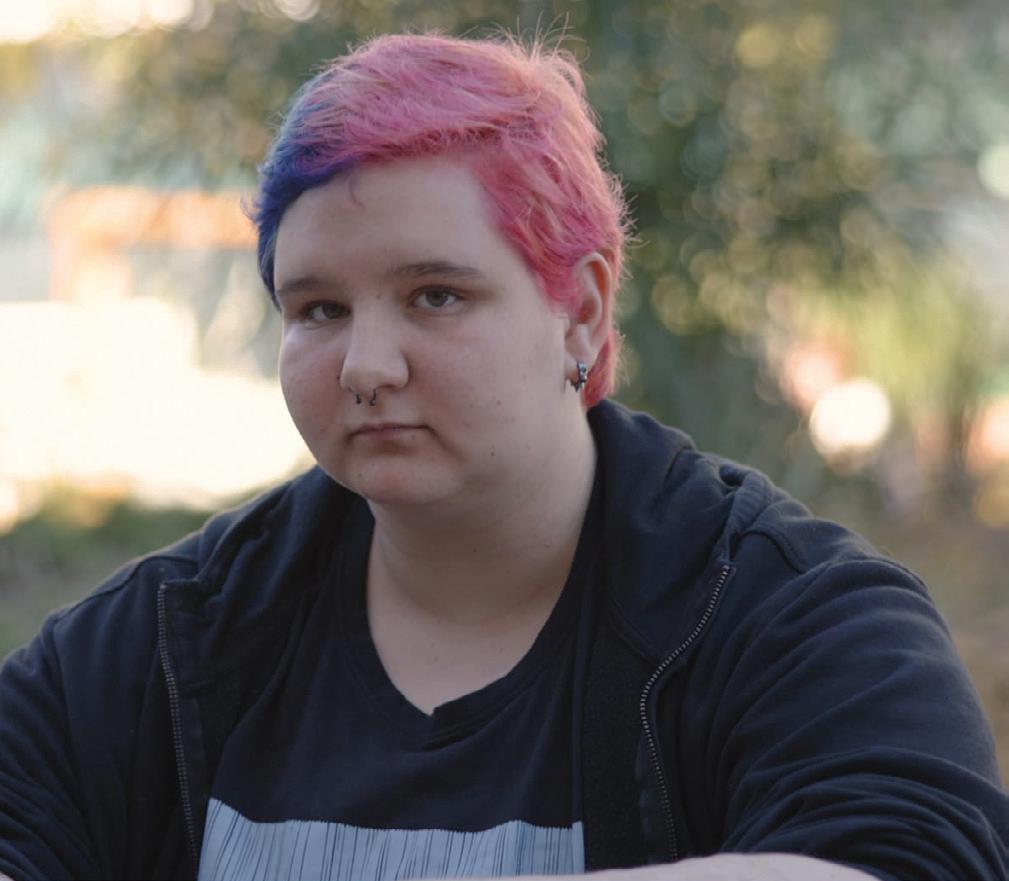
About Tourette syndrome
Tourette syndrome is a chronic neurological disorder characterised by involuntary, repetitive movement and vocalisations known as tics. It is one of a group of neurological conditions known collectively as tic disorders. Tourette syndrome affects approximately one per cent of school-aged children, with one in four experiencing lifelong symptoms. It most often begins between 4-6 years of age. It is not a degenerative condition, and people with Tourette’s can expect to live the normal lifespan.
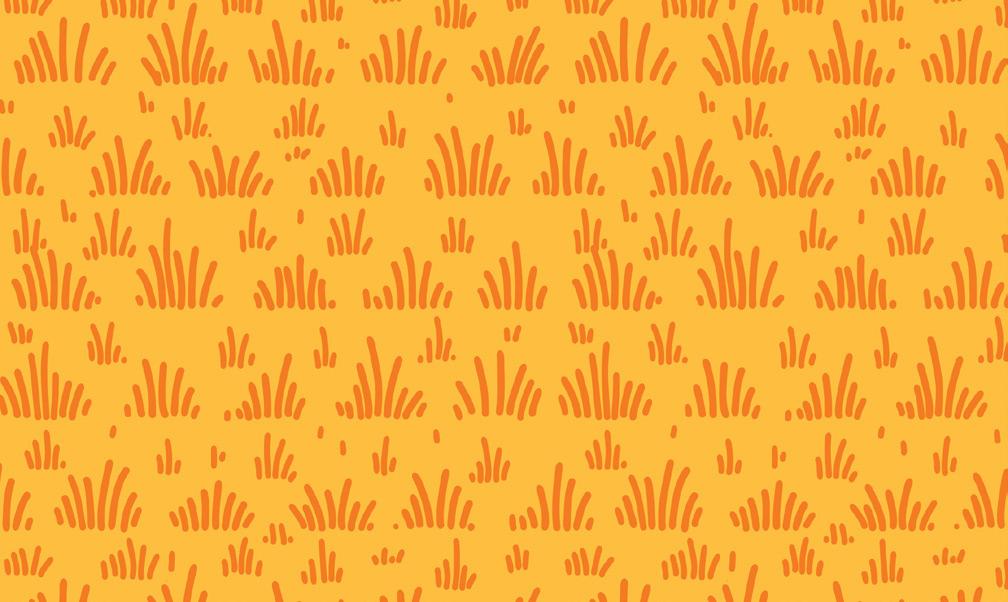
The Impact for Tourette’s survey and report were supported by internal funding awards at The Kids Research Institute Australia, including the Julie Bishop Award for emerging women in science, presented to Dr Licari in 2023, and an Embrace Award presented to Dr Licari and Professor Eapen in 2024.
Max Radcliffe lives withTourette syndrome.
Joining the dots to keep children with cerebral palsy healthier and out of hospital
A 13-year pipeline of research led by The Kids Research Institute Australia in collaboration with Perth Children’s Hospital has transformed the way respiratory illness is predicted and managed in children with cerebral palsy (CP), with a gamechanging new program helping to keep kids with CP out of hospital.
Preventable respiratory disease is the biggest driver of unplanned hospitalisations and premature death for children with the motor disability CP, but for decades no one had put two and two together to focus on the prevention part of the equation.
It was in 2011 that Dr Marie Blackmore – then working as research coordinator at Ability WA and later as a researcher within the Child Disability Team at The Kids Research Institute Australia – and Dr Andrew Wilson, a respiratory physician at Perth Children’s Hospital and honorary Fellow within the Wal-yan Respiratory Research Centre at The Kids, first joined the dots.
“When I talked to respiratory physicians, two independently told me the same thing: that the early respiratory deaths in these children were preventable, if only we had a way of identifying them before it was too late,” Dr Blackmore said.
“I thought this is just terrible, we’ve got to do something. We need to figure out how to spot these kids in advance and intervene before they get to the stage that the best we can do is provide palliative care.”
Drs Blackmore and Wilson put together a team of clinicians and researchers to narrow down risk factors that could identify the children with CP who were most likely to get severe respiratory disease.
They created a questionnaire covering as many risk factors as they could think of, completed by more than 550 WA families. The team then followed participating children’s hospitalisations for the next five years to see which factors would predict subsequent hospitalisation for respiratory disease.
“We identified nine diverse risk factors, including swallowing difficulties, reflux, epilepsy, and mobility, most of which were potentially modifiable,” Dr Blackmore said. “Once the risk factors were known, the question became ‘What do we do about them?’”
Enter the next phase of the research program, driven by team member Dr Noula Gibson, a Perth Children’s Hospital physiotherapist and honorary researcher with The Kids.
After a literature review revealed a paucity of research into preventative interventions, the growing team consulted experts worldwide to develop the first consensus statement of recommendations for prevention and management of respiratory disease in children with CP.
Armed with these recommendations, the team developed resources for families and clinicians and in 2021 came up with RESP-ACT, a model of care which aims to identify at-risk children, provide them with comprehensive assessments and individualised healthcare plans, and overcome the siloing of care typical in complex conditions like CP.
A successful 12-month feasibility study at PCH underscored the need, showing nine out of 10 participating children – many not yet three years of age – already had lung changes associated with respiratory disease.
The pilot’s success led in late 2024 to a $600,000 grant from the WA Child Research Fund, which is now enabling the team to roll RESPACT out to more children via an implementation study.
While the program – the success of which has depended on strong community collaboration and consultation – is still in a study phase, it has already led to changes in clinical care and better health outcomes.
Other countries are also paying attention, with the UK and New Zealand picking up and building on the risk factor checklist included in RESP-ACT.
“Respiratory disease in children with cerebral palsy is a slow, insidious process that quietly builds up while parents are busy dealing with all the other aspects of CP,” Dr Blackmore said. “It’s hiding in plain sight, but you need to be actively looking for it to catch it in time.
“RESP-ACT is giving families and clinicians the tools to do that – making sure kids with CP can stay out of hospital and lead happier, healthier lives.”
Program eases worries for parents

Although still in a study phase, RESP-ACT has already seen a marked drop in respiratory-related hospitalisations for participants.
For one of those participating families – Stacy and Luc Tasker and son Nathan, 5 – the other big win has been a reduction in their levels of worry about when to seek help for Nathan.
“Probably the most important and best thing for us has been the education and confidence we as a family got out of it,” Nathan’s father Luc said.
"Children like Nathan have complexities and are more likely to get sick than kids without underlying medical issues. It’s very common for parents of

NEXT STEPS
The team is now gathering further health data and examining implementation strategies with the ultimate aims of setting up a multisite trial and making RESP-ACT a sustainable, embedded program available to every child in WA with CP who is at risk of respiratory disease.
children with a disability and with these underlying issues to worry about whether their child is okay or not okay – should I be doing something here or not? Do I need to take my child to ED now or wait until morning?
“As well as other information and support, the RESP-ACT team gave us a little flow chart specific to Nathan showing this is when things are okay, this is when you should start being concerned, this is when you should seek medical help.
“It has certainly lessened our anxiety and has given us more confidence to know when Nathan is actually ill enough that we need to reach out for more support, versus something we can manage ourselves.”

This work has been supported by WA Health Networks, NonGovernment Centre Support, Ability Centre, WA Health Research Translation Projects funding, and the WA Child Research Fund.
Luc Tasker with this son Nathan, 5, and Dr Noula Gibson. Photo courtesy of The West Australian.
Evaluation critical piece of puzzle to strengthen case for new child protection assessment model
Learnings from an evaluation of a trial of a multipartner collaboration to strengthen at-risk South Australian families and help keep children out of the child protection system, has informed the way children and families are supported across the State.
The evaluation was conducted by The Kids Research Institute Australia, in partnership with the University of Adelaide, into the Child and Family Assessment and Referral Networks (CFARN) pilot program.
Set up in response to the 2016 Royal Commission into the SA Child Protection System, CFARN aimed to divert families who present with issues during pregnancy up to the age of two years, that are likely to put children at increased risk of harm, from later child protection involvement.
SA Department of Human Services Director, Safer Family Services, Kerry Beck, said the evaluation of the program gave the Department confidence that the multi-agency and cross-sector approach was benefiting kids and families.
“This evaluation work has been seminal in the way we approach child protection in the very early stages of a child’s life,” Ms Beck said. “It has helped to reshape and reform how family support services in this State operate.
“The work has validated our approach and resulted in significant positive outcomes for children who can be supported to stay with their families.”
Ms Beck said that shifting to this way of working to strengthen families has contributed to the slowing of children entering out-of-home care in SA. “This is an extraordinary outcome,” she said.
The principles of care that aim to address system dysfunction and increase support for families include:
1. Intervening earlier, ideally during the antenatal period so support can be established and parental capacity strengthened before the child is born.
2. Improving service collaboration across the government and non-government sectors.
3. Regular meetings for case coordination.
4. Increase families’ trust in services through a restorative practice approach.
5. Applying trauma-informed practice principles to work with families in a way that recognises the impact of trauma across generations.
6. Employing assertive engagement to connect with families in a way that reduces barriers to engaging with support.
7. Fostering culturally-inclusive practice.
Head of Early Years Systems
Evidence at The Kids, Associate Professor Yasmin Harman-Smith, said the evaluation sought to identify ways in which CFARN practice principles were contributing to reduced systems dysfunction and improved family support, any factors impacting the implementation of the service model, and early outcomes for children and families.
“Through administrative data analysis, interviews and focus groups and systems mapping, what we found was the CFARN model was working as it was intended and families were receiving improved supports,” Associate Professor Harman-Smith said.
“The pilot program led to improvement across the sectors around the knowledge of families’ circumstances and through better relationships, ensured staff were able to improve what was known about the risk and protective factors within families. This meant case workers were better able to assess risk to children and pinpoint the supports needed to strengthen families.
“Importantly, the evaluation identified fewer child protection contacts six months post intervention for those successfully engaged in CFARN compared to those eligible for the pilot program, but who didn’t receive the service.”
Associate Professor Harman-Smith said the extension of the CFARN model underpinned the importance of the evaluation in providing evidence to demonstrate the efficacy and the success of the model.
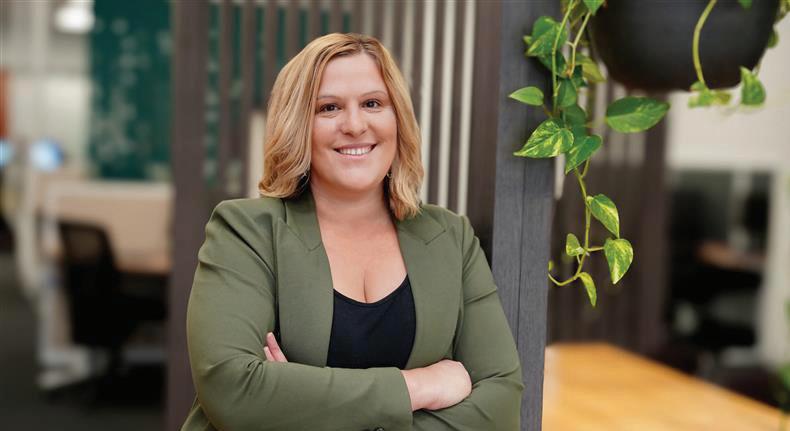
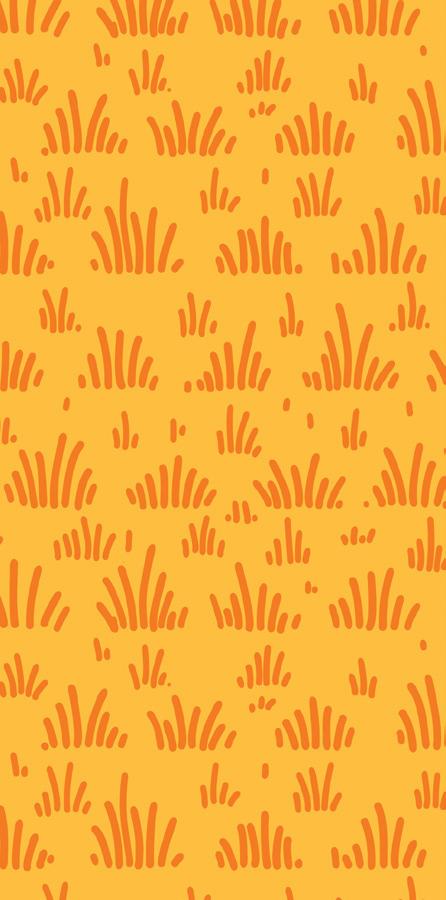
Prevalence of presenting concerns for CFARN clients
Young Maternal Age Service Evasion & Disengagement
Unemployment Poverty
Parenting/Attachment
Mental Illness
Mental Health & Emotional Wellbeing Medical Issues
Child Health and Development
Child Disability
Housing Instability Homelessness
Dysfunctional Relationships Drug & Alcohol
Domestic Violence & Family Violence
Current Criminal/Legal Concerns
Parent Childhood Trauma Trauma Experience
Neglect
Child Protection
% of clients with each presenting concern
The evaluation was undertaken by The Kids Research Institute Australia in partnership with the BetterStart Group at the University of Adelaide.
Associate Professor Yasmin Harman-Smith.
New evidence shows timely introduction of peanuts and eggs reduces allergy risks for kids
Families who introduce peanut butter and eggs to their baby’s diet at around six months of age can significantly reduce the chances of them developing a life-threatening allergy, according to a new study published in the Journal of Allergy and Clinical Immunology – In Practice.
The findings from The Kids Research Institute Australia are the first evidence internationally of their kind and provide renewed confidence to parents about to embark on the introducing new foods to their babies journey – even if they have a family history of allergies.
Co-author and Head of the Nutrition in Early Life team at The Kids, Associate Professor Debbie Palmer, said Australia’s guidelines were changed in 2016 to encourage the timely introduction of these common food allergens.
However, some parents were still confused about when to introduce allergens – especially those families with a history of allergies.
“This is the first time we have been able to directly test the current Australasian Society of Clinical Immunology and Allergy (ASCIA) Infant Feeding and Allergy Prevention Guidelines and our research shows they are working,” Associate Professor Palmer said.
“In our study, egg allergy was four times lower and peanut allergy was five times lower when these food allergens were introduced around six months of age, instead of 10 months or later.
“Importantly, our study also illustrates the benefits of directly providing parents and caregivers with hard copies of the updated guidelines and shows they should be widely distributed in the community via healthcare professionals, including child health nurses and GPs.”
Co-author Summer Walker said the study compared two groups of babies: group one (506 babies born 2006-2014), who received no allergy prevention infant
feeding advice and where egg and peanut butter was introduced after 10 months; and group two (566 babies born 2016-2022,), where all families were provided with hard copies and explanations of the updated infant feeding and allergy prevention guidelines when the babies were six months of age.
All babies had a first-degree relative with a history of allergic disease, and all were assessed for food allergies at age one.
“For the babies in group two – whose caregivers followed the updated guidelines and introduced peanut butter and egg around six months of age – egg allergy reduced from 12 per cent to three per cent, and peanut allergy reduced from around six per cent to one per cent,” Ms Walker said.
“By increasing the distribution of guidelines and encouraging health professionals to share the information, we can considerably reduce the incidence of food allergies in the community.”
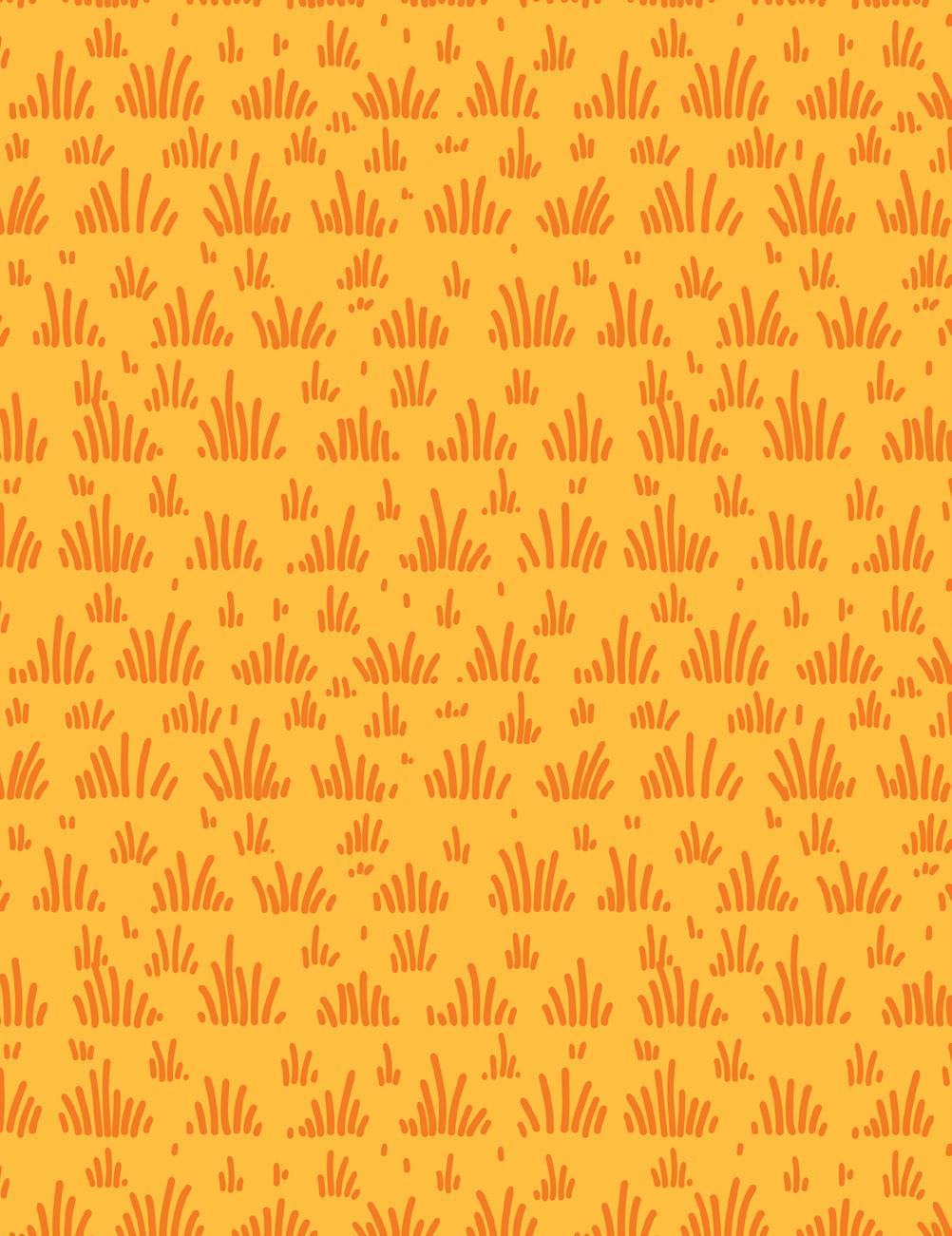
• First-of-its-kind study delivers new evidence that timely introduction of peanuts and eggs significantly reduces a baby’s risk of developing food allergies – even babies with a family history of allergies.
• Egg allergy was four times lower and peanut allergy was five times lower when these food allergens were introduced around six months of age, instead of 10 months or later.
• Findings strongly support use of the Australian Infant Feeding and Allergy Prevention Guidelines and support calls for health professionals to share these directly with families.
Guidelines provide reassurance for parents
Eight-year-old Harriet knows the telltale signs of her allergy straight away.
“Her lips swell, her tongue swells up and she gets a rash and gets very sore. It can be really frightening,” her mother Ruth Kerr-Sheppard said.
And while Harriet must be on alert for peanuts, always carrying an epi-pen, her younger sister Neve, likes to eat peanut butter whenever she can.
The bubbly six-year-old is allergy free; her mother thanking the updated advice that was
given to her when Neve was around six months old.
“The advice when Harriet was a baby was to delay the introduction of peanut and eggs, whereas the advice for Neve was to introduce those allergens earlier - around six months old.”
Through participation in this research study –Ms Kerr-Sheppard was given a hard copy of the new feeding guidelines and had them explained to her.
“As a new parent there is so much information out there, and you just want to do what’s best for your child,” Ms Kerr-Sheppard said.
“Given Harriet had such a severe allergy, I was worried Neve would develop one too. But we followed the guidelines and it made a big difference.”
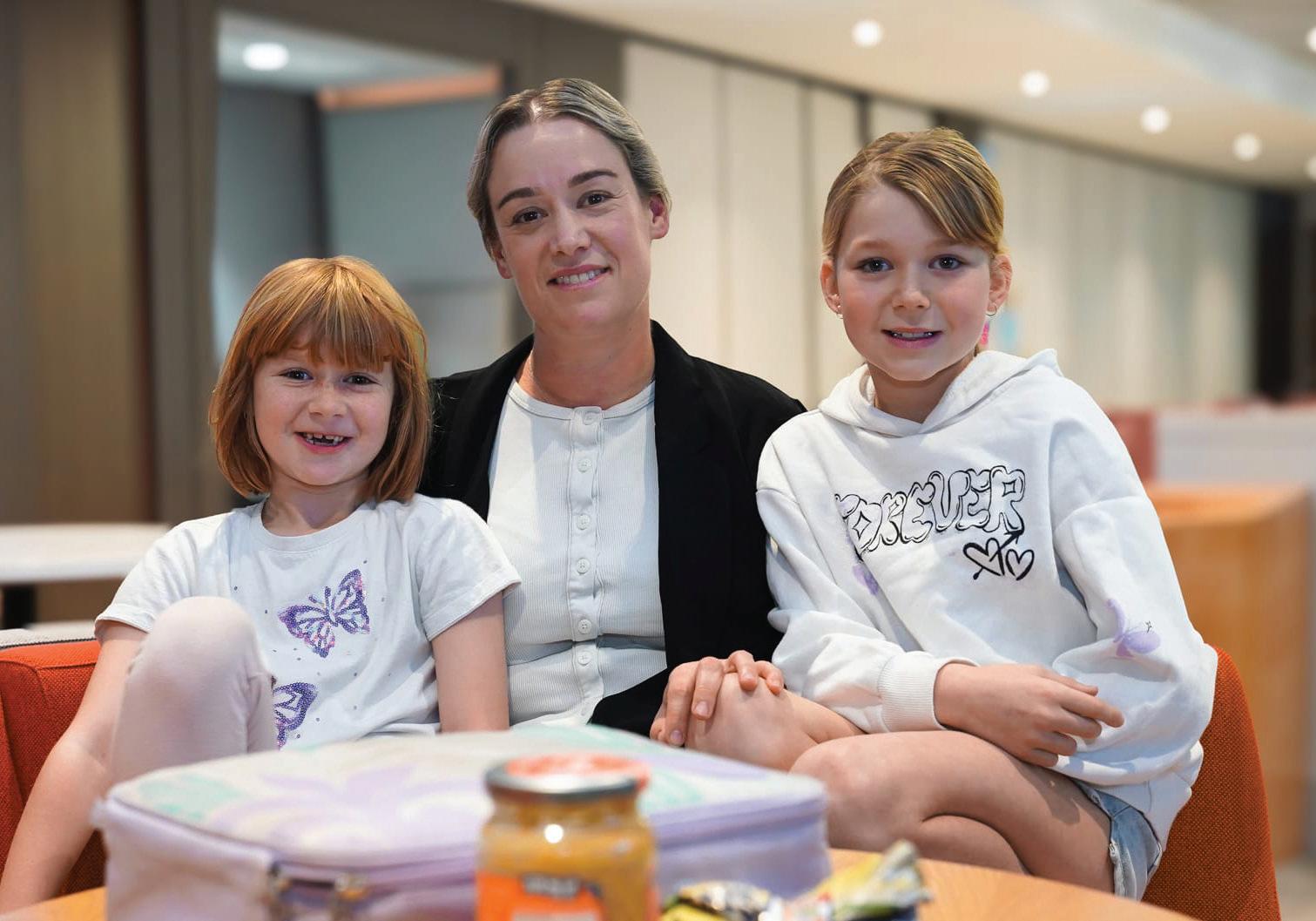
Ruth Kerr-Sheppard with her daughters Neve, 6, left and Harriet, 8.
Dr Vincent Mancini
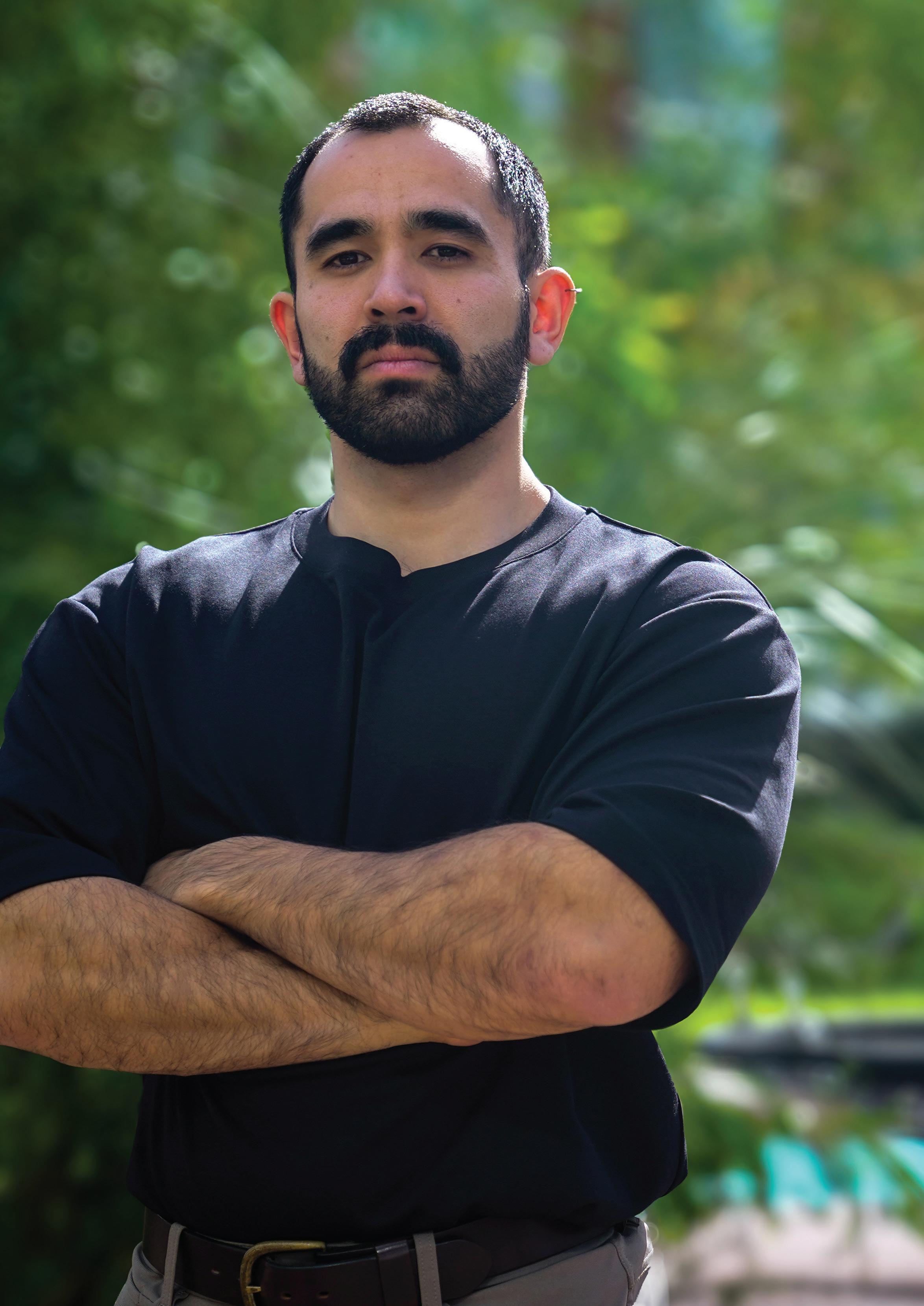
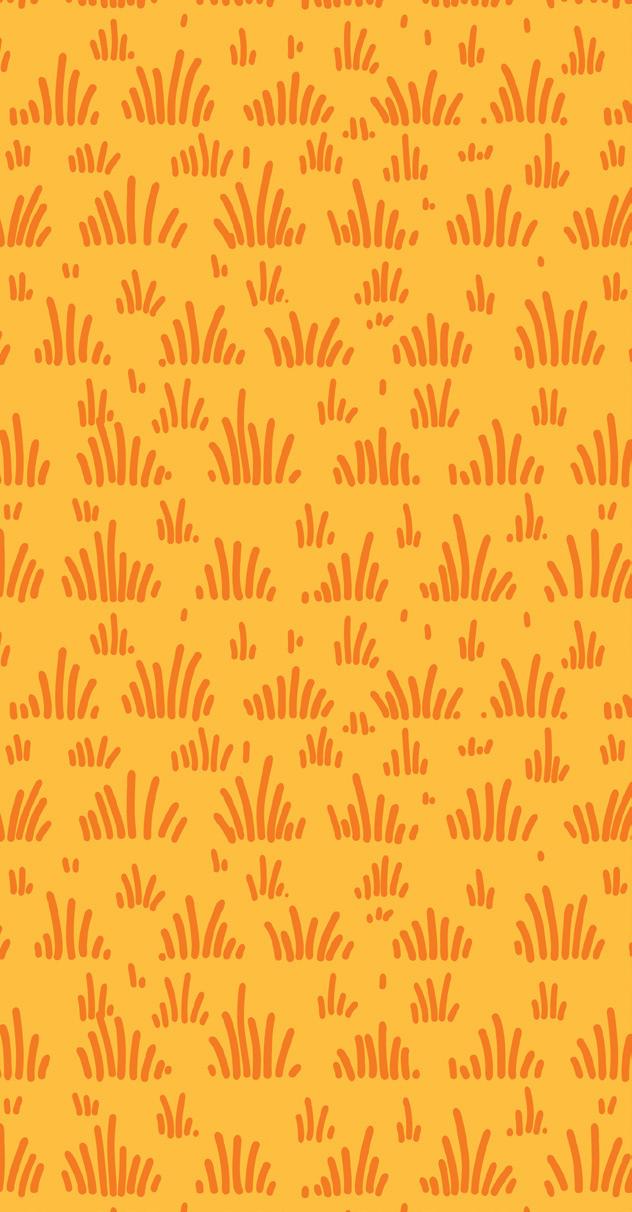
NEXT STEPS

• The Kids will partner with the community and teachers to develop novel ways to engage and educate young men about the harms of online gambling.
• Future studies will examine the prevalence of underage gambling rates in Australia.
• Researchers will also examine the role of social media ‘betfluencers’ as an additional risk factor.
Sports betting a ‘gateway’ to problem gambling, new research finds
Young men who participate in sports and fantasy sports gambling are at a higher risk of developing problem gambling behaviours, recent research from The Kids Research Institute Australia has found.
Using data on men aged 18-25 from Australia’s longestrunning study on male health, the Ten to Men initiative, researchers also linked higher levels of depression to increased odds of developing problem gambling in the future.
Lead author and The Kids Senior Research Fellow Dr Vincent Mancini said young men were more susceptible to forms of gambling featuring a skill-based component, where there is a perception that they can beat the odds.
“We know
younger people are more likely to engage in risky behaviours compared to older people, and men are about twice as likely as women to engage in any form of gambling,” Dr Mancini said.
“Young men may think they have an edge with sports gambling because they know one team is out of form, or a player is injured, but betting agencies factor this data into their odds.”
The findings highlight a potential generational and gender divide in gambling behaviours which might be missed in population-level research on gambling behaviours that often focus on the harms caused by electronic gaming machines, or ‘pokies’.
“When we speak to young men and their parents, it’s often sports gambling that comes up as the greatest concern, which runs counter to prevailing wisdom that most gambling harm is derived from pokies machines,” Dr Mancini said.
Kate Chaney, MP for Curtin, took to social media following a meeting with Dr Mancini this July to highlight the “groundbreaking research” and call for gambling advertising reform.
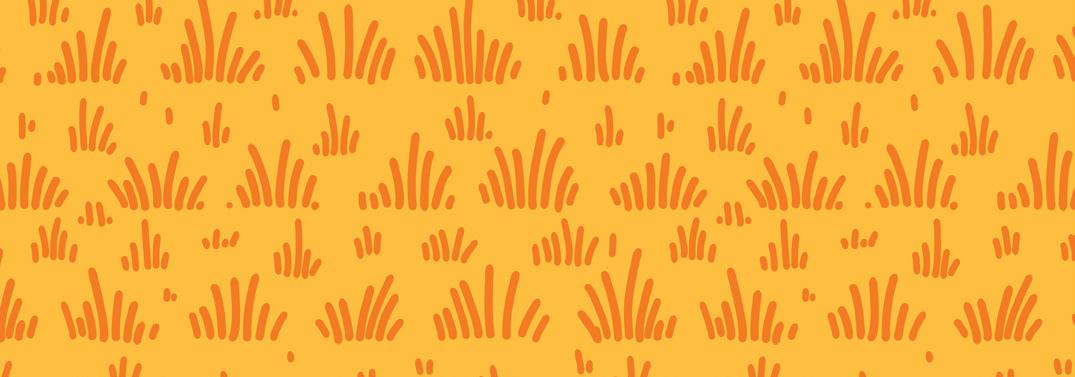
This project included co-investigators from the University of Sydney, University of Melbourne, and the Movember Institute of Men’s Health. It received funding from Embrace at The Kids.

Gambling addiction led to $100,000 loss
Mark Kempster knows firsthand how sports gambling can take over your life.
As a teen playing local footy in Hobart, Mr Kempster was drawn into having a punt as part of the club’s – and indeed, the sport’s – wider culture.
“It isn’t the club’s fault,” Mr Kempster said. “It’s social and you kind of had to do it to fit in around that time.”
“It’s something I controlled into my early 20s, and then the proliferation of sports-betting apps in the mid-2000s was when my addiction really fell off a cliff.”
Over the next decade, Mr Kempster lost approximately $100,000 while constantly being targeted with ads and inducements, as he struggled to overcome stigma and reach out for help.
“In the end I managed to get myself through it with the help of my partner and my family, but I was a pretty horrible person over that time.”
“I haven’t had a bet in five years now, and I have so much passion to help people not fall into the trap that I fell into.”
Now, Mr Kempster works with the Alliance for Gambling Reform to run programs on gambling awareness and advocate for harm minimisation strategies including a reduction in online gambling advertising, mandatory precommitment cards and sweeping education programmes for young people, as recommended by the federal government’s You win some, you lose more report, handed down in 2023.
“I do a lot of work with teenagers, and I get bombarded with messages from parents, saying their 16-17 year-old is gambling and they don’t know what to do. It’s so difficult to tell a parent what to do in that situation,” he said.
“We have to put something in place to stop this or we’ll lose a whole generation to addiction.”

Mark Kempster
Gold standard treatment for all diabetes patients
Imagine you had a healthy daughter one day and the next being told she has an incurable condition that requires day-to-day care and insulin treatment to stay alive.
This is what happened to Kaitlyn Crouch and her husband, Justin Crouch. Their bright and spirited daughter Quinn was just 19-months-old when her parents took her to Perth Children’s Hospital emergency for an urgent insulin infusion.
Mrs Crouch’s nursing background proved vital for her daughter when she noticed Quinn had a thirst for water “she could not quench”. Recognising this as a symptom of diabetes, she went to her doctor, who ordered blood tests.
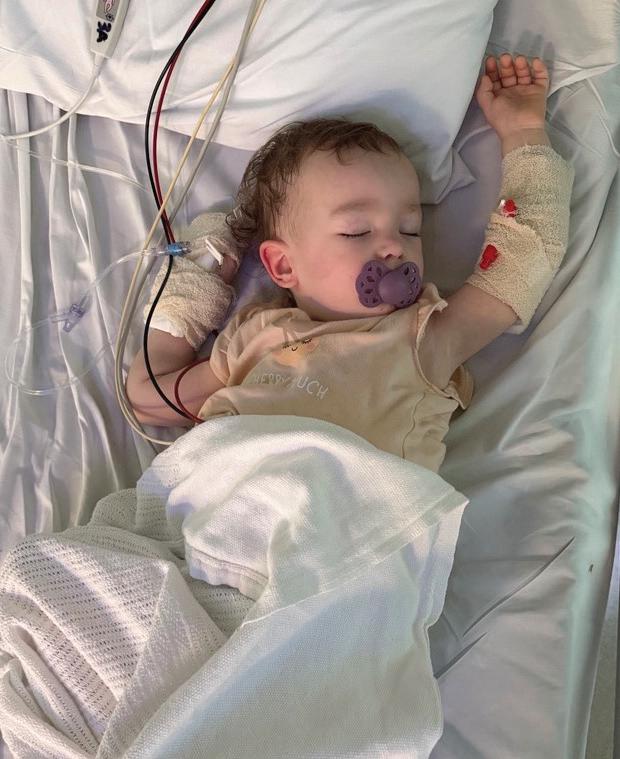
Two days later Mrs Crouch received a phone call to get her daughter to PCH urgently. That day she was diagnosed with type 1 diabetes.
The care Quinn now requires is 24 hours a day, seven days a week, 365 days a year, for the rest of her life. And while insulin provides a lifeline, it is not a cure.
But Kaitlyn counts their family as one of the lucky ones. Thanks to funding for the Children’s Diabetes Centre ‘Equitable Access from Diagnosis Study’, Quinn, and all other newly diagnosed WA children with T1D this year, have access to the best insulin delivery technology at no costfrom the beginning of their diabetes diagnosis.
“There is no good way for your child to become sick, especially with a condition as life changing as type 1 diabetes but by joining this program we’ve had the best experience, and so much support from the amazing team,” Mrs Crouch said.
“The technology has made our lives so much easier with a smoother transition into our new reality; if we were doing insulin injections, Quinn wouldn’t be back in day care, I wouldn’t be back at work.”
The hybrid closed-loop (HCL) system contains a blood glucose monitor known as a continuous glucose monitor communicating with an insulin pump to adjust
insulin delivery in the background, putting an end to insulin injections which can be traumatic and challenging for young children.
While the glucose monitors are government-funded, the insulin pumps normally cost up to $10,000 every four years outright or are only available through the top private health cover, placing them out of many families’ reach until now.
Diabetes specialist Dr Kate Lomax, who is based in the Department of Endocrinology and Diabetes at Perth Children’s Hospital and at the Children’s Diabetes Centre at The Kids Research Institute Australia, is leading the project.
She hopes to prove a case for subsidising the devices, creating equity of care for all children with type 1 diabetes.
“There are many patients who struggle to access the best therapy, so the idea of the project was to reduce the barriers and increase the equity in terms of access to HCL systems for our families, from right at the beginning of diagnosis. We’re also trying to prove that is beneficial for them in the longer term,” she said.
“What happens to their anxiety levels, their sleep levels, their diabetes distress is what the project focuses on”.
“We’re following their outcomes for two years postdiagnosis to give a long-term picture. The point is to change and inform policy.”
“It’s a really tricky illness to manage, especially in little ones, so this is taking away so much of that burden and stress.”
Mrs Crouch said she hoped that one day the hybrid closed-loop system could be made available for everyone through the government, “this system really is the golden standard of treatment for diabetes.”
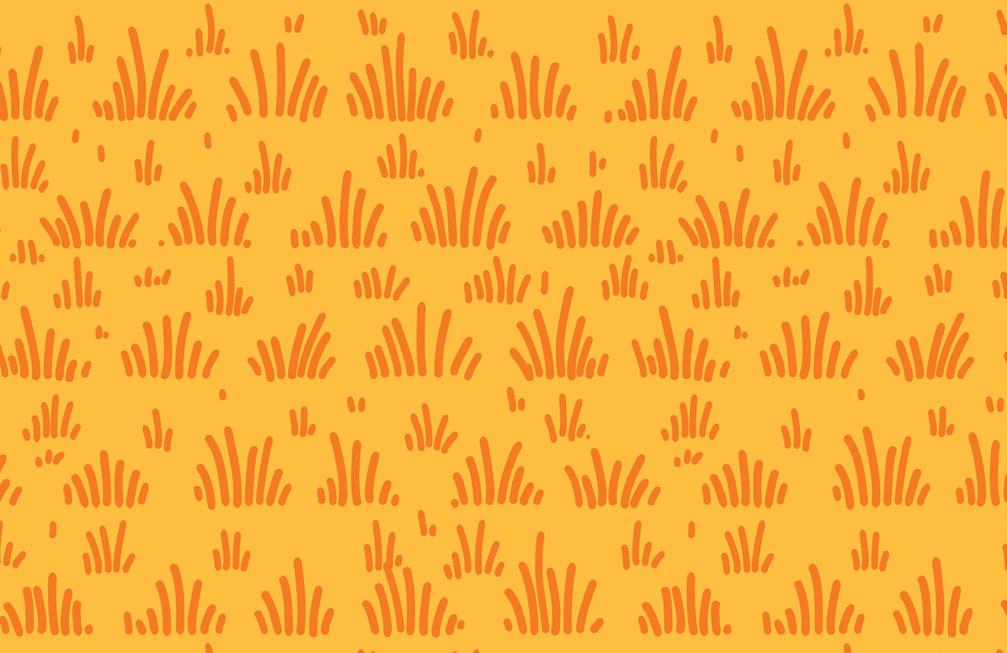
This study has been proudly funded by a WA Child Research Fund grant, Rio Tinto, Breakthrough T1D and Perth Children’s Hospital Foundation.
Dr Kate Lomax received a Telethon Trust Fellowship to support her work on this project and is now the recipient of a PhD Pathway Scholarship supported by Child and Adolescent Health Service, The Kids, Perth Children’s Hospital Foundation and The University of WA.
Quinn Crouch in intensive care aged 19 months.

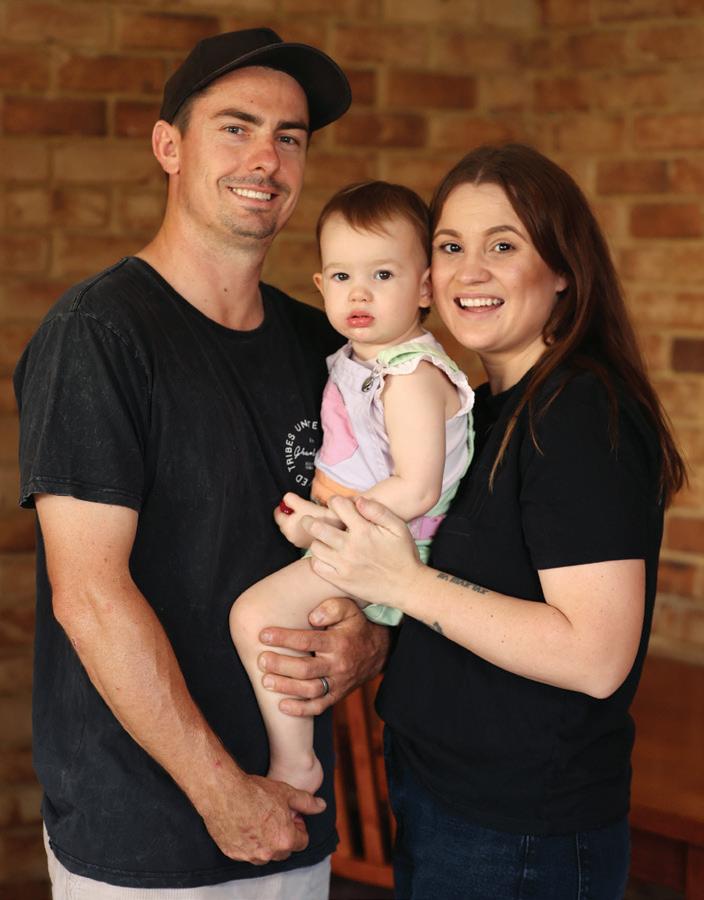
Kaitlyn Crouch with her daughter Quinn.
Right: Quinn Crouch, 23 months, with her parents Justin and Kaitlyn Crouch.
Photos courtesy of The West Australian.
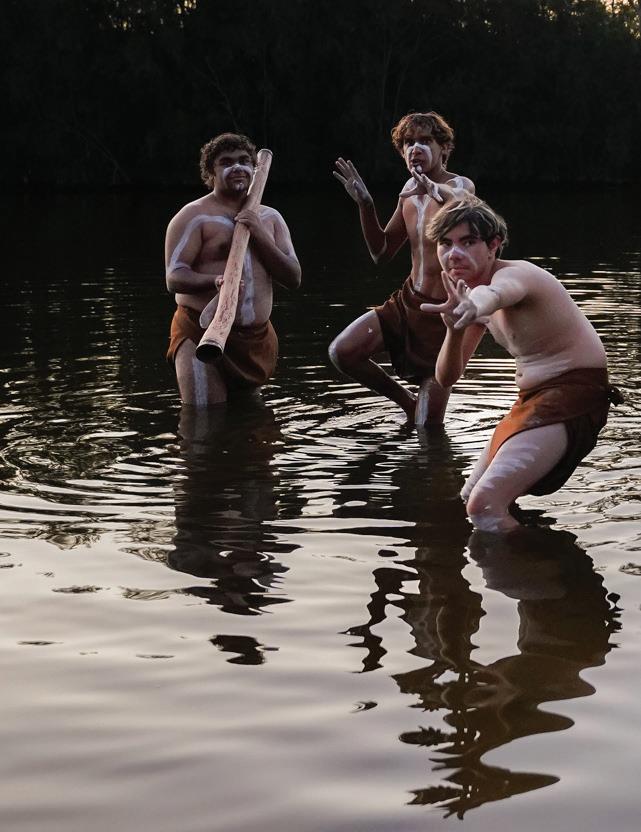
Members of Indigenous dance troupe Bilya Booladarlung.


COLLABORATING FOR IMPACT

How we work with others to make a difference.
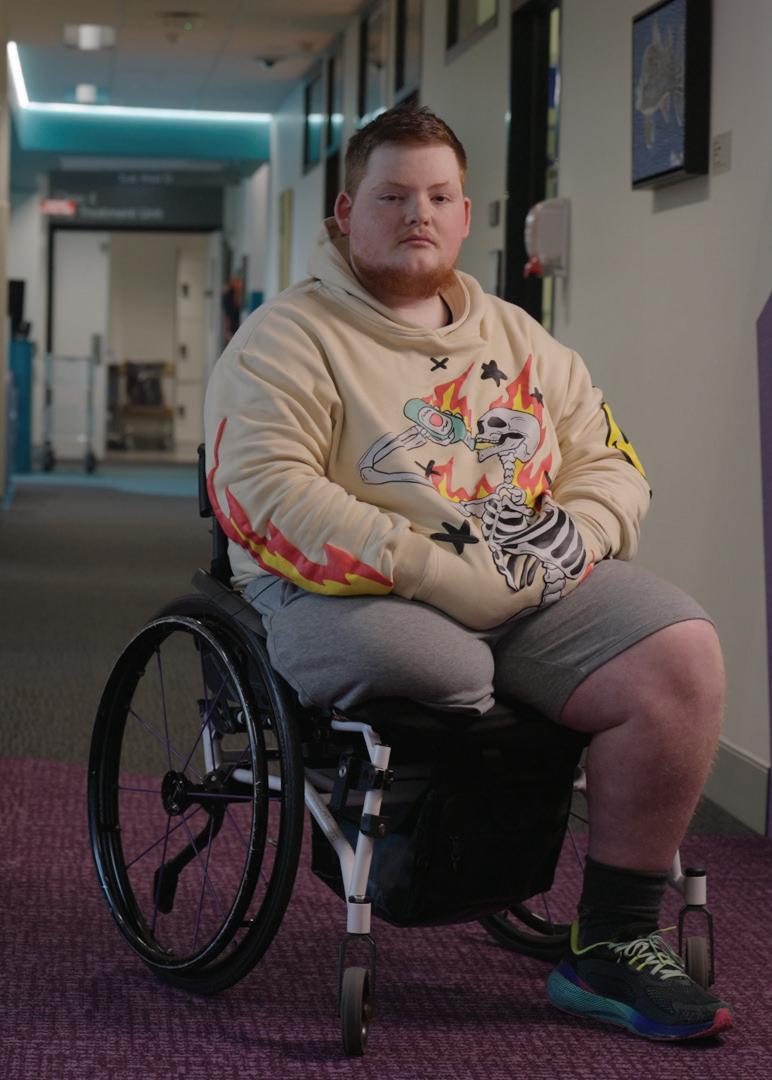
Angus Hollington is hopeful the new Centre will mean kids diagnosed with cancer today don’t suffer the ill effects of cancer treatment.
Hope for kids with cancer thanks to one of Western Australia’s biggest ever donations
Angus Hollington is the face of why we need to do more for kids with cancer.
He spent nearly half his life being one of those kids, surviving two separate bouts of cancer: first, Ewing’s Sarcoma, an aggressive cancer of the bone and tissue diagnosed when he was 11 and then at 16, Acute Myeloid Leukaemia caused by the chemotherapy used to successfully treat his Ewing’s.
By the end of that second round, he was an amputee – the leg that had been saved at such a heavy cost the first time finally succumbing to a nasty infection.
“Realistically for me I was kind of happy they got rid of it,” Mr Hollington, now 22-years-old said.
“For six years it caused pretty much every problem I had. So yeah, while I don’t have a leg, I survived two cancers – I’ll take that.”
Mr Hollington is in remission and down to seeing his oncologist just once a year – a relief from the constant rounds of appointments, surgeries, chemotherapy and stem cell treatments he endured for so much of his childhood.
Having gone through all he has – including relentless bullying at school for looking different as a result of his treatment – Mr Hollington could be forgiven for allowing his cancer story to recede quietly into the background as he gets on with his hard-won life.
Instead, he has committed to talking about his experience at any opportunity as a way of raising awareness about the relentless toll current treatments take on young bodies, and to encourage people to support vital research into better options that improve survival rates without the harsh side effects.
He said he was filled with hope for the children diagnosed today with cancer thanks to a major donation to establish the WA Comprehensive Kids Cancer Centre.
One of WA’s biggest ever philanthropic gifts is expected to transform childhood cancer research and treatment by improving outcomes for children with cancer and discovering more effective and less toxic treatments.
The Stan Perron Charitable Foundation will contribute $135.5 million over the next decade to the multi-partner collaboration, which will build on the significant work already being undertaken by Perth Children’s Hospital (PCH) and The Kids Research Institute Australia.
Perth Children’s Hospital Foundation (PCHF) will also make a multi-million-dollar contribution over the next five years with an option to extend and The University of Western Australia will add up to $9 million to help improve the lives of kids impacted by cancer in WA and across the globe.
“It’s such an amazing thing to know that so much money will be contributing to the amazing research that they do here at The Kids Research Institute for childhood cancer,” Mr Hollington said.
“I’m just so excited to see this going towards finding better treatments for kids that are going through what I went through.
“It means the world. I wish every day that nothing like what happened to me, happens to another child.”
The financial commitment from the Stan Perron Charitable Foundation, one of WA’s oldest charities, is an incredible contribution to the State and a fitting legacy to its founder, businessman Stan Perron, who died in 2018.
Child and Adolescent Health Service Chief Executive, Valerie Buic said investing in childhood cancer research and care was important with 1240 Australian children diagnosed with cancer each year.
“Childhood cancer is the leading cause of death by disease for Australian children,” Ms Buic said.
“We have a great opportunity to do more in this space and give our children and young people access to worldleading care and research.
“This field is moving extremely rapidly with precision medicine, genomics and other science advances. The donation will not only benefit Western Australian children – it will allow our Perth Children’s Hospital clinicians and The Kids researchers to contribute to these advances and lead the field in their areas of expertise.”
Chair of the Stan Perron Charitable Foundation, Elizabeth Perron said the intent and objectives of the Comprehensive Kids Cancer Centre aligned perfectly with the intent of the Foundation established by her father.
“The Foundation’s guiding principles for giving expressly target any activity that improves the health and wellbeing of children in Western Australia,” Ms Perron said.
“While the funding is significant, like all projects funded by the Foundation, we are concerned less by the amount of money donated but primarily by the impact of the activity on the lives of children.”
Cutting-edge laboratory and clinical research have been shown to improve short, medium and long-term patient outcomes through seamless operational and cultural integration between researchers and clinicians.
Importantly, it can immediately translate into improved treatment, survival and whole-of-life outcomes for patients.
While this is already happening at PCH and The Kids, the initiative will give the work a longer-term future, underpinned by sustained funding instead of short-term, project-based grants. It will also mean no Western Australian child will miss out on the best treatment available.
Professor Nick Gottardo, head of the Oncology and Haematology Department at PCH, said in the past 70 years only 50 new drugs had been approved to treat paediatric cancers, whereas for adults 60 cancer drugs were approved every year.
“Current treatments for kids cancer cause severe and often life-long side effects including problems with emotions, reproduction, growth, development, hormones, learning, memory problems, heart, lung, digestive system, hearing, vision and most strikingly, can cause secondary cancers,” Professor Gottardo said
“This amazing donation will give us the chance to build on the world-leading research we are already undertaking and ensure kids in WA can be treated right here in WA.
“It will mean that kids with cancer will have access to the best treatment options without needing to leave the State and kids diagnosed with cancer in the future will benefit from transformative discovery research.
“It will advance our pre-clinical discovery pipeline to significantly improve outcomes for kids yet to be diagnosed with cancer, to discover more effective and less toxic treatments that will be adopted worldwide and to improve the lives of kids impacted by cancer globally.
Our vision is for all kids with cancer to survive and thrive.
The Kids Executive Director Professor Jonathan Carapetis said the initiative was a research model

Cancer clinician-researcher Professor Nick Gottardo speaking at the media announcement for the WA Comprehensive Kids Cancer Centre.
exemplar where researchers, clinicians and families with lived experience had charted a course for what would be needed in kids’ cancer research and treatment in the next decade.
“This is research reimagined. Nothing about this work is business as usual. It has been borne out of genuine partnerships with kids and families at the heart of the plan.
“This funding is a game-changer for childhood cancer research and treatment in WA.
“It will bring together ‘Team WA’ - an interdisciplinary team of clinicians and researchers; it will also attract and retain the brightest minds in this field from around the world and facilitate the purchase of the most advanced equipment needed to ensure game-changing research breakthroughs,” Professor Carapetis said.

By 2035 it is the goal for:
• Every child with cancer to have access to the world’s best cancer treatments in WA, including treatments ‘home-grown’ in our local laboratories.
• Aboriginal kids with cancer to receive tailored treatment with a culturally sensitive approach to care.
• All kids with cancer to have access to novel, effective treatments with reduced life-long side effects, resulting in improved outcomes and the best chance of a life free from long-term physical and psychological complications.
• To be recognised as world-leading, with collaborative networks across the country and the world.

Our Partners
Key local partners also include the Harry Perkins Institute of Medical Research, Sir Charles Gairdner Hospital, Linear Clinical Research and the Cancer Council of Western Australia.
Left to right: UWA Deputy Vice Chancellor (Research) Anna Nowak, Child and Adolescent Health Service Chief Executive Valerie Buic, former WA Health Minister Amber-Jade Sanderson, Tracey Hollington, Angus Hollington, cancer researcher Professor Nick Gottardo, Medical Research Minister Stephen Dawson, Elizabeth Perron, cancer researcher Joost Lesterhuis, The Kids Executive Director Professor Jonathan Carapetis and Perth Children’s Hospital Foundation Chief Executive Officer Carrick Robinson.
The WA Comprehensive Kids Cancer Centre has been made possible thanks to the Stan Perron Charitable Foundation, the University of Western Australia and the Perth Children’s Hospital Foundation.
Early Years Partnership project keeping the cavities away for Central Great Southern kids
Delivering child dental health screening to regional schools and culturally safe locations and targeting oral health promotion at hard-to-reach populations could help keep the cavities away.
Evaluation of the Early Years Partnership’s (EYP) Central Great Southern Dental Project found that more than 70 per cent of children aged between one and four-years-old received dental checks, many for the first time.
Former Chief Investigator Dr Lynne Millar said the project, in which student dentists were supported by dental specialists to take services to areas where they were needed most, had proven very effective.
“A majority of children had not seen a dentist prior to this project and many had undetected dental health problems,” Dr Millar said. “Dental caries were detected in the teeth of more than half of children aged three to fiveyears-old, more than a third of children aged two to three-years old and one in ten children aged between one and two-years old.”

Dr Lisa Bowdin and dental student Devika Purushothaman undertake dental screening with a Central Greath Southern child.

The project is one of a number being undertaken by the EYP, which aims to improve school readiness for children in four areas cross Western Australia, aiming to create a sustainable blueprint for long-term change.
Now at the halfway point of a 10-year collaboration between the WA State Government Departments of Communities, Health and Education, and the Minderoo Foundation, the EYP communities were selected based on data indicating a need for improvement in early childhood outcomes. The Kids Research Institute Australia was the evidence and evaluation partner between 2019-2025.
Other EYP projects include research into family safety in all four locations, Connected Beginnings in which staff or local ‘connectors’ advocate on behalf of community members to ensure services are delivered in a way that best meets their needs, and Brain Box, which is a resource for professionals to provide accurate, critical and consistent information to parents about the importance of the first 1,000 days of a child’s life.
Professor Francis Mitrou, who heads The Kids Human Development and Community Wellbeing team, said the Institute was proud to have been the evaluation partner of the EYP to inform and guide policies and services to improve school readiness.
Professor Mitrou said a community-based participation research model was used to evaluate the dental project where results and learnings were shared soon after each dental visit.
“This resulted in more streamlined practices and a more targeted approach to recruiting children and families,” he said.
The success of the program led to positive changes at a local level, including child oral surgeries now taking place at Katanning Hospital instead of families having to travel to Perth, allowing practitioners to use the school dental clinic, and training allied health staff in oral health detection, prevention and some minor treatments. It was hoped the project could be expanded to other EYP sites.
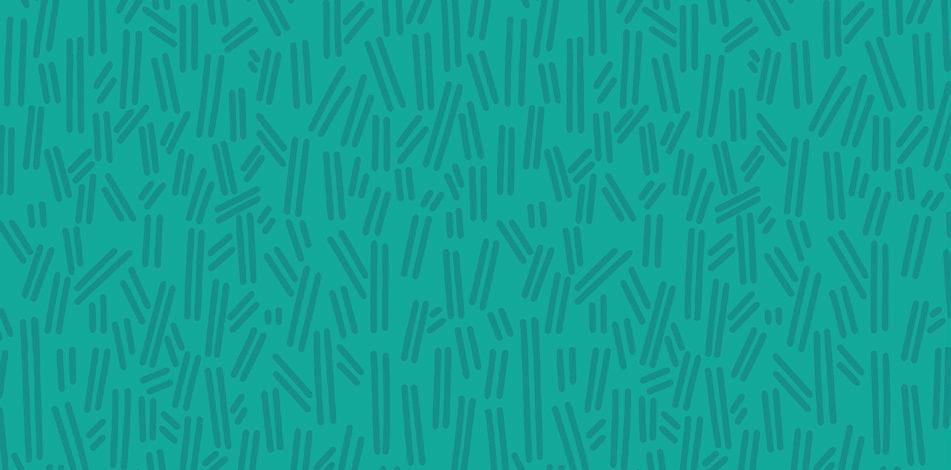
The Early Years Partnership is a partnership between the WA State Government and the Minderoo Foundation. The Kids was the evidence and evaluation partner (2019-2025).
Dental student Nichola Eliot checks one-and-half-year-old Koda’s teeth with the help of his mother, Stacey Smith.
Waalitj kids stars of their own show in the quest to learn more about infectious diseases
An interactive community engagement project led by the Wesfarmers Centre of Vaccines and Infectious Diseases, based at The Kids Research Institute Australia, encouraged school kids to become the star of their own show as they explored germs and vaccines through dance, movement and play.
Involving the Waalitj Foundation after school club in Lathlain, the project provided the opportunity to connect with kids in Years 3 to 6 and empower them to consider and articulate what infections and vaccines mean to them in their own unique way.
Facilitated by Kyle Morrison, a Noongar Yamitji artist, and Jacqui Hume, Community Involvement Coordinator for the Wesfarmers Centre and former contemporary dancer, the one-hour sessions over 10 weeks used a mix of Indigenous culture, drama and dance and infection control practices to help kids learn more about living healthy lifestyles.
Big hits with the students included drawing activities and adapting games like ‘Red Light, Green Light’ and ‘Wink Murder’ to fit into the infectious disease themes, encouraging creative movement responses to questions like, ‘how do you think germs move?’ and ‘how are germs defeated?’.
of the students were nervous about getting vaccines, helping to guide messaging on future health resources.
Carly Davis, Waalitj Club organiser, was interested in connecting with the Wesfarmers Centre on this project to help the kids understand that being healthy is important for people to have success in their life.

“This was such a special opportunity – the kids got to work with amazing artists, learn more about Noongar culture and language and different forms of drama – all while learning about infectious diseases and the importance of vaccination to protect each other and vulnerable people in the community,” Ms Davis said.
“The energy and enthusiasm from the group was incredible, and the kids were thrilled to perform in front of audience at the final session and show off their new skills and knowledge.”
The sessions also uncovered some interesting insights for researchers, such as the main reasons why many
“I really hope that the lasting impacts of this project on our Waalitj participants and community is that we see
11-year-old Olivia Di Pietro enjoying learning about germs.
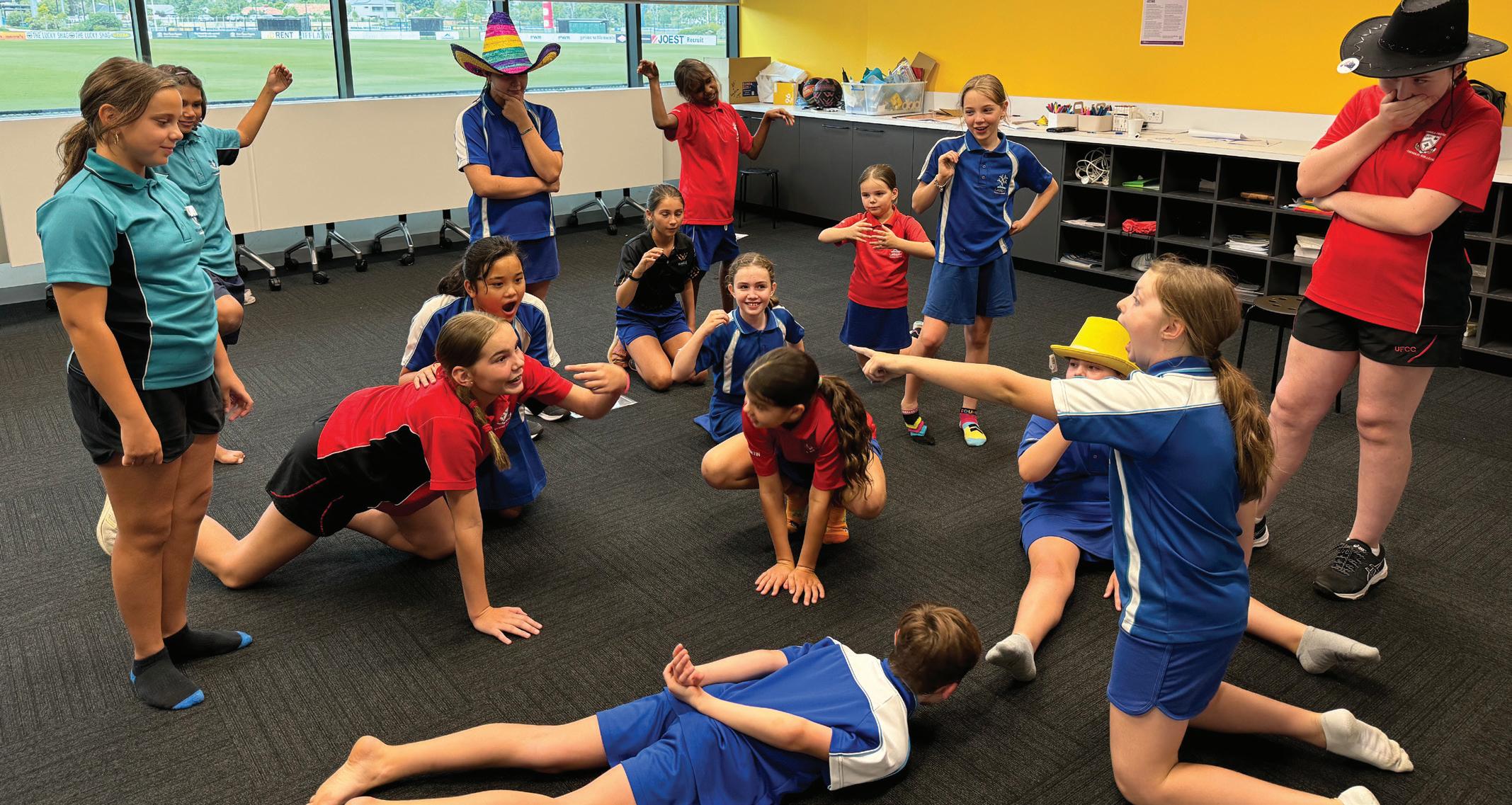
healthier people who take their health seriously and get vaccinated.”
The Waalitj Club program is the latest initiative developed by Jacqui Hume, and its design followed the success of a pilot program with pre-kindy children conducted in late 2023.
“Our first program took place with four- and five-yearolds attending Climb Early Learning Centre, where educators and a visual artist helped the kids brainstorm what they know and how they feel about germs, and then guided the creation of a beautiful art piece they presented to family and friends,” Mrs Hume said.
“Our pilot project at Climb really demonstrated the tremendous potential of engagement activities with the local community – strengthening relationships and giving kids the opportunity to learn in a fun and interactive way.
“It opened the door for meaningful connections and collaboration and encouraged us to build on the idea of using dance and play to encourage thinking around new concepts.
“We would like to thank the Waalitj Foundation for collaborating on this project and of course the kids who welcomed us with so much spirit and passion.”
Wesfarmers Centre Manager, Sarah Brazier, said the Centre was proud to support these initiatives.
“We are so fortunate to have Jacqui bring her ideas of engaging with the community through different art forms in order to gain insights into children’s understanding of vaccines and infectious diseases,” Mrs Brazier said.

NEXT STEPS
• Wesfarmers Centre researchers hope to run further education sessions and workshops with the Waalitj Club throughout the year.
• Future sessions will aim to take conversations about infections and vaccines further, as well as a potential focus on other global health challenges such as antimicrobial resistance.
Waalitj Club students take part in the after school project.
The Kids researchers working to tackle wicked threat of antimicrobial resistance
Identified by the World Health Organization as one of the top global public health and development threats, antimicrobial resistance (AMR) is now a key focus for numerous research teams at the Wesfarmers Centre of Vaccines and Infectious Diseases, based at The Kids Research Institute Australia.
Occurring when bacteria develop resistance to the antibiotics designed to kill them, AMR is expected to claim 10 million lives worldwide by 2050.
Professor Chris Blyth, Head of the Wesfarmers Centre, sees AMR as a wicked problem and rapidly evolving public health crisis.
“If left unchecked, many of the gains made in modern medicine will be reversed, with untreatable infection impacting us all like in the pre-antibiotic era,” Professor Blyth said.
“As a research centre, we have the capacity to help turn around AMR, whether that be understanding the burden and drivers of AMR, designing better ways to diagnose and treat resistant infections, or using vaccines and tools to help prescribers reduce inappropriate use.
“We are leading the way in this space, and this has been recognised by an invitation to contribute to the Antimicrobial Use and Resistance in Australia (AURA) Report by the interim Australian Centre for Disease Control.
The AURA request follows latest research led by the Centre’s Infectious Diseases Epidemiology team that demonstrated that AMR has become a serious and growing threat to Australian kids.
The Australian Group on Antimicrobial Resistance (AGAR) Kids Report – the world’s first-ever, government commissioned surveillance study investigating nation-wide prevalence of AMR in children – used data collected from laboratories throughout the country to identify the patterns of drug-resistant bloodstream infections.
AGAR Kids Report statistics from 2022-2023:
1,745 blood culture samples were collected
12.2% of the bacteria causing bloodstream infections were multi-drug resistant (MDR)
Staphylococcus
aureus – known as Golden Staph or S.aureau – most common blood stream infection found in children aged one upwards
Escherichia coli was most frequently reported bacteria in babies (<12 months), but E. coli infections in older children and adolescents are more commonly drug resistant
Northern Australia (including WA and NT) have some of the highest rates of methicillin-resistance staph aureus (MRSA) in the world
The report tracked national data from the past 12 years and revealed that more than one in every 10 children with a bloodstream infection was infected with a multidrug-resistant organism.
Lead author of the AGAR Kids Report, Ms Anita Williams, said this research provided a unique national snapshot on bacterial infections and antibiotic resistance.
“Australia is the first country to answer the call by the World Society of Paediatric Infectious Diseases and World Health Organization to publish national AMR data in babies, children and adolescents. This is the critical first step in tackling AMR in kids,” Ms Williams said.
“The study gives us valuable insight into how AMR varies according to geographic location, which groups of children are at greatest risk of AMR and helps guide local treatment recommendations. It also tells us that no matter the location – all children are at risk of resistant infections.
“The AGAR Kids Report provides an essential benchmark for research in paediatric AMR and will inform future treatment and prevention strategies by targeting at-risk age groups in higher-risk states and territories.”
“Now that we have a baseline for monitoring AMR in this age bracket, we will extend our research to examine
how patterns and risk factors differ from the adult population – this will provide crucial information for health providers and policy makers to prevent AMR in
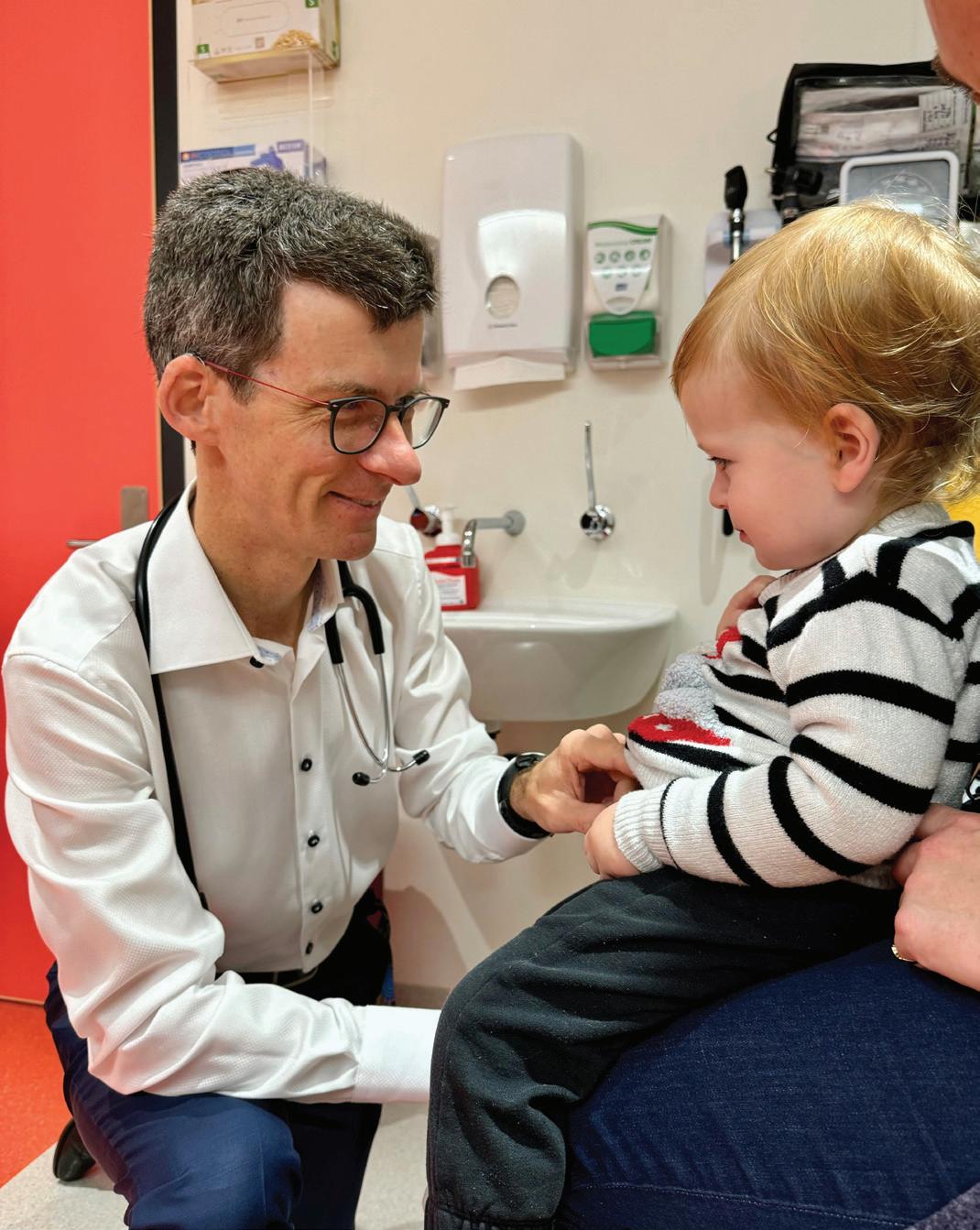
Other AMR projects on the radar

Research by the Strep A Pathogenesis and Diagnostics team has revealed the various ways Strep A bacteria can survive penicillin treatment and continue to replicate. They have identified alternative antibiotics that are useful in these cases, and are working on a way to diagnose infections caused by penicillin resistant Strep A.
A second study is helping to explain why Strep throat infections can relapse despite being susceptible to antibiotics in laboratory testing. Together, this work will pave the way for new diagnostics and improved delivery of alternative treatment options.

The Bacterial Respiratory Infectious Diseases Group are progressing the development of two new therapies to reduce the burden of ear infections and repeat grommet surgeries; Spritz-OM and Blitz-OM.
Middle ear infections affect one in four children and are the main reason children are prescribed antibiotics – ear infections currently account for over 50 per cent of antibiotic prescriptions for children aged two and under.
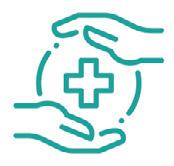
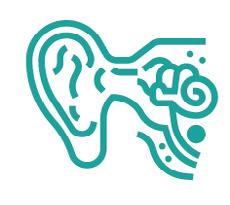

The Healthy Skin & ARF Prevention team are collaborating on the international Staphylococcus aureus Network Adaptive Platform trial (SNAP), which aims to establish best practice antibiotic treatment for people of all ages with golden staph bloodstream infections.
Children being treated for these infections at Perth Children’s Hospital are being recruited into SNAP-PY, a specific paediatric aspect of SNAP being led by Professor Asha Bowen and Dr Anita Campbell.

Professor Chris Blyth with one-year-old Zane.
United approach for strong healthy skin
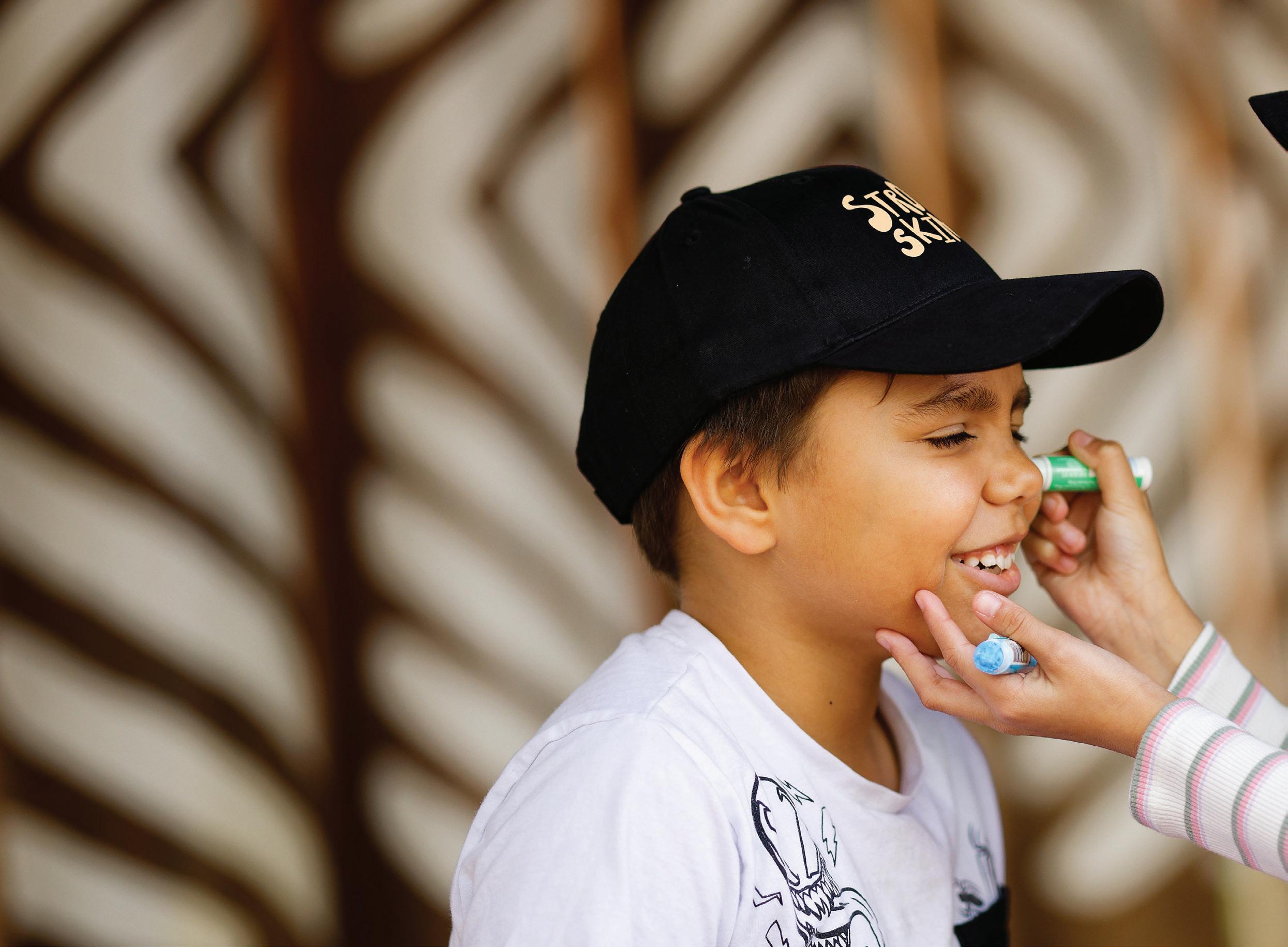
New insights into the skin health of Aboriginal children living in urban WA have sparked a series of co-designed, Aboriginal-led projects now underway at the Wesfarmers Centre of Vaccines and Infectious Diseases, based at The Kids Research Institute Australia.
The Koolungar Moorditj Healthy Skin Project began in 2019 to better understand, describe, and address the skin health needs of Aboriginal children, their families and communities in urban settings. The project was driven by a recognised gap in knowledge around skin health priorities – there has been a major research focus on reducing the burden of skin infections and scabies in WA’s regional and remote communities, but very little has been known about the needs of children in urban areas – home to more than 60 per cent of Aboriginal kids in WA. In addition, linked hospitalisation data revealed that Aboriginal children in urban areas experience significantly high rates of hospitalisation for skin-related issues.
Prominent Aboriginal Elders and researchers, Uncle Noel Nannup and Aunty Dale Tilbrook, led the design and development of the project, joining forces with Aboriginal Community Controlled Health Organisations to explore culturally safe and community-driven approaches to improve skin health outcomes.
“For youngsters, skin health is important because it can lead to harmful downstream health complications – we want kids to feel confident to manage their own skin health, protecting it and looking after it with the right medicine and care,” Uncle Noel said.
“When
supporting Aboriginal
people on their journey to better skin health, it’s important that we have a collaborative approach, that we work together and have a shared understanding and purpose.
“Shame and stigma around skin conditions can make people feel judged or isolated, but by working together and building our knowledge, we can break down that shame and make skin health a normal part of our care practice,” he said.
A popular part of the project has been three Community Skin Screening Weeks held in collaboration with Derbarl Yerrigan Health Service and South-West Aboriginal Medical Service. These events, attended by 248 kids and their families, provided free skin checks, same-day treatment where needed, and culturally tailored education about healthy skin. Several skin
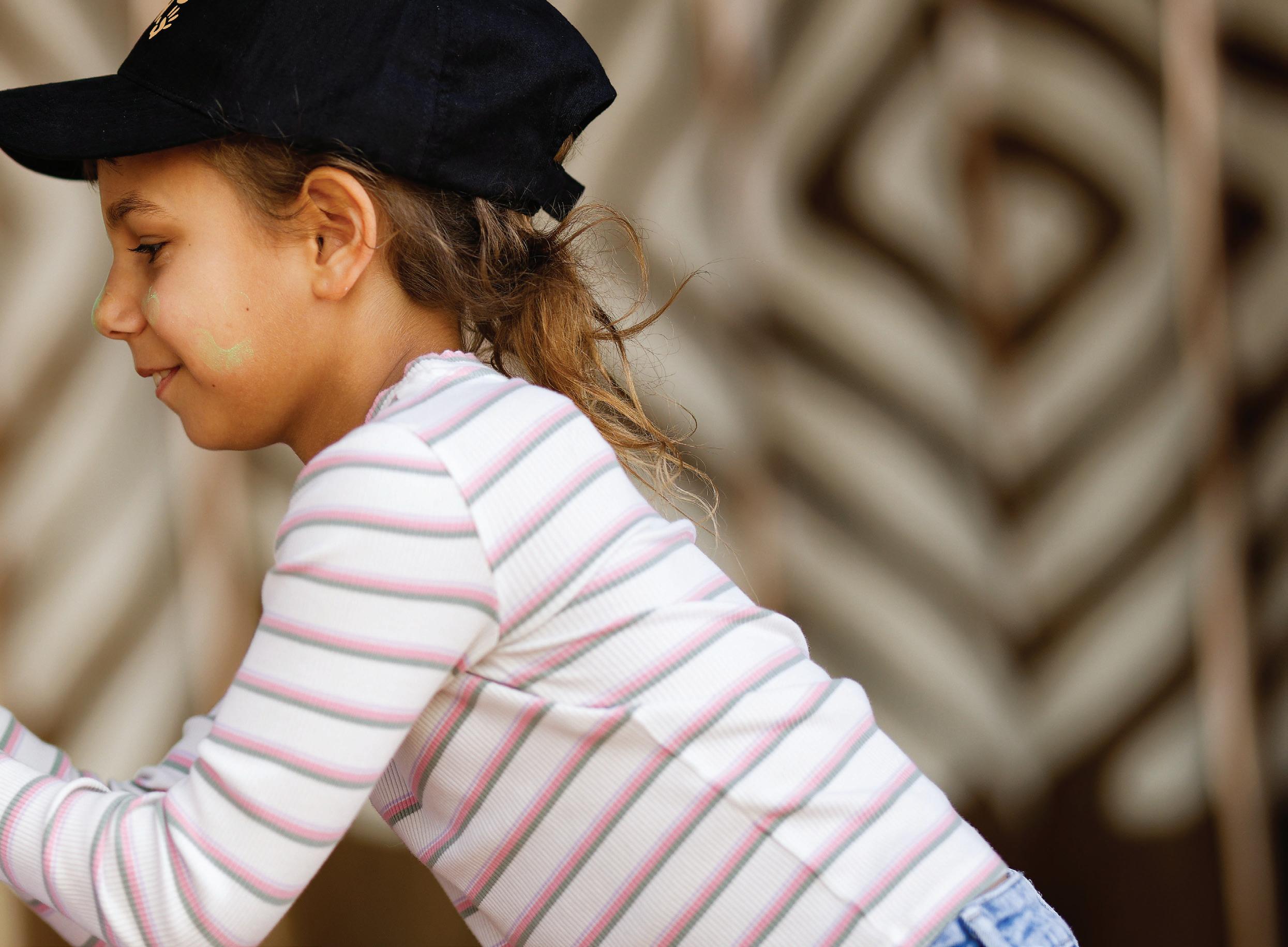
conditions were found during the screening sessions, such as head lice, tinea, and eczema – this was then used to identify priority areas for action going forward.
The latest project, Ngangk Ngabala Ngoonda (Sun Safety) of Aboriginal young mob of WA, is being led by Professor Asha Bowen, Head of the Healthy Skin and Acute Rheumatic Fever Prevention team, and Dr Heather-Lynn Kessaris, Western Australia’s first Aboriginal dermatology trainee, in collaboration with Aboriginal clinicians, Elders, researchers, Aboriginal Community Controlled Health Organisations and community members.
“Throughout the screening weeks, it was identified that some children had already experienced more than 10 serious sun burn incidents, and we discovered there were a number of misconceptions and knowledge gaps around sun safety,” Dr Kessaris said.
“We found that only 40-60 per cent of Aboriginal kids living in urban areas were following two of the five recommended sun-safe strategies such as wearing sun protective clothing and applying sun cream.
“For Aboriginal Australians, skin cancer often presents at an advanced stage and with poorer prognosis
compared to non-Aboriginal Australians, so Ngangk Ngabala Ngoonda aims to increase awareness of skin cancer risk for Aboriginal youth and help with the development of community-led, culturally- inclusive sun safety resources,” said Dr Kessaris.
The team is inviting Aboriginal and Torres Strait Islander children and young people to complete a short survey to determine what they currently know and do when it comes to sun safety, this knowledge will help shape new resources led by community for community.
“We hope these evidence-based prevention and early intervention initiatives will empower Aboriginal communities to make positive sun smart choices and, ultimately, reduce the disparity in skin cancer health outcomes between Aboriginal and non-Aboriginal Western Australians.”

Ngangk Ngabala Ngoonda is supported by the Annie Frida Minna Adams Charitable Trust, The Norman H Johns Trust, Perpetual Foundation - the FW & CF Penberthy Endowment and the Cancer Council of Western Australia
Siblings Lauren,8, and Caiden, 9, practising sun safe behaviours.
Landmark study halves skin infections in remote Aboriginal kids
A large-scale Australian skin study has halved the rate of skin infections experienced by Aboriginal children living in remote communities, with regular skin checks key to the stunning result.
Led by The Kids Research Institute Australia and Aboriginal health organisations in close partnership with nine Aboriginal communities in Western Australia’s Kimberley region, the five-year project set out to identify the best possible methods to See, Treat and Prevent painful skin sores and scabies.
If left untreated, skin infections can cause lifethreatening illnesses including rheumatic heart disease (RHD), sepsis and kidney disease – all of which disproportionately affect Aboriginal and Torres Strait Islander Australians.
“Skin sores, or impetigo, are a massive problem –our previous research has shown children living in Australia’s remote Aboriginal communities have the highest rates of impetigo in the world,” SToP Trial lead Professor Asha Bowen said.
“These painful and itchy infections are so common they were seen as ‘normal’ and often left untreated, which can lead to life-threatening illnesses.”
Researchers worked closely with community members and local health services – including Kimberley
Aboriginal Medical Services, Nirrumbuk Environmental Health and Services and the WA Country Health Service Kimberley, to complete skin check-ups and yarn about the best approaches for local treatment and sharing prevention messages.
Led by Professor Bowen, Head of the Healthy Skin and Acute Rheumatic Fever Prevention team at the Wesfarmers Centre of Vaccines and Infectious Diseases based at The Kids, Professor at The University of Western Australia and Paediatrician at Perth Children’s Hospital – the team followed 915 children and visited schools in nine communities three times per year over the study period.
“The magnitude of the project was huge,” Professor Bowen said. “We completed 3,084 skin checks over the four-year period and covered over 45,000 kms travelling to 81 community visits in order to gain a full picture of how skin infections affect kids and their families.”
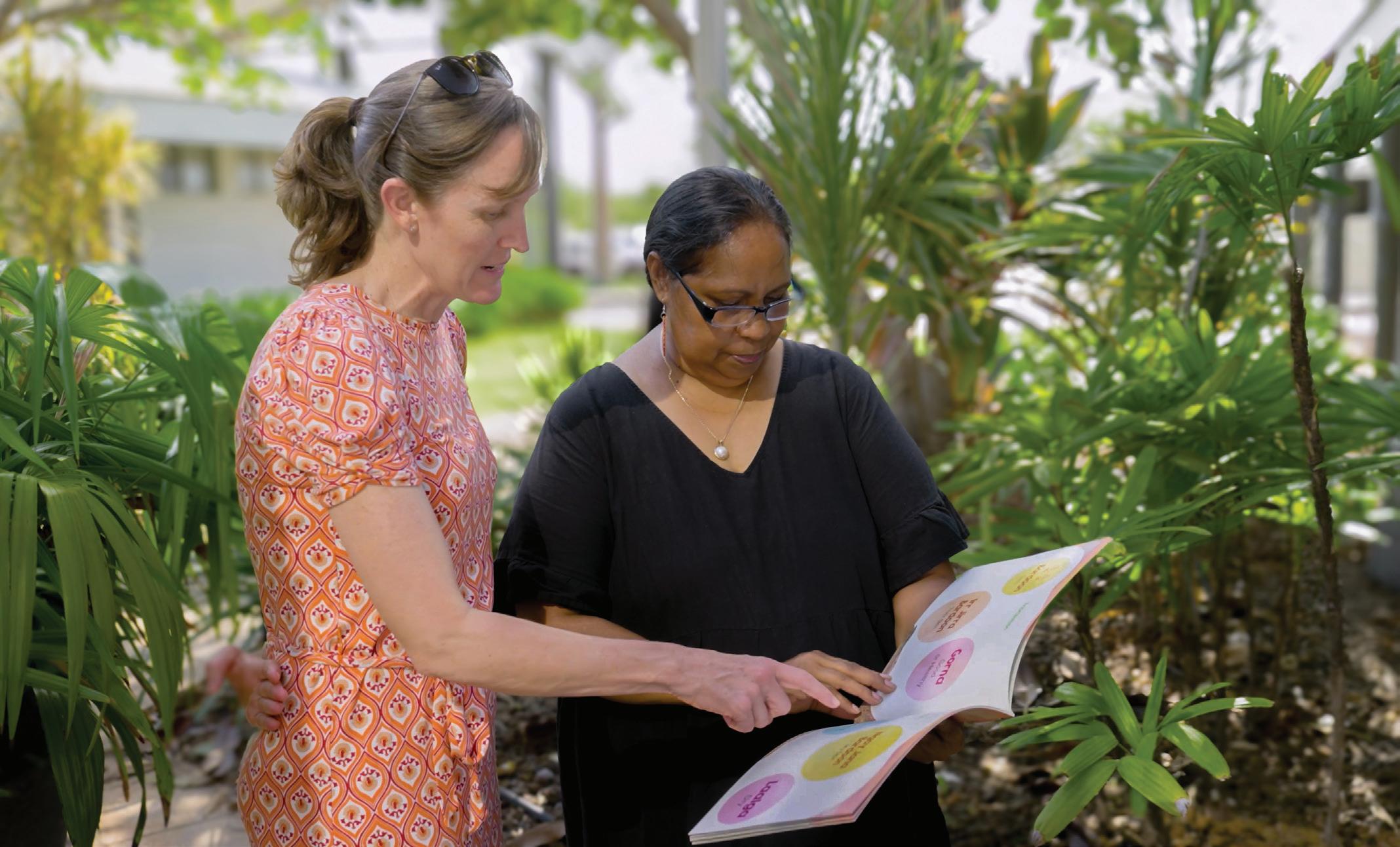
Professor Asha Bowen with Bardi-Jawi Community Navigator Ms Janella Isaac who supported the SToP trial and HipHop2SToP video.
The findings, published in The Lancet Child and Adolescent Health and eClinical Medicine, reveal that while the rate of skin infections early in the study period was close to 40 per cent, this had been reduced to 20 per cent – two in every 10 children – by the end of the trial.
“Our aim for the SToP Trial was to decrease the burden of skin sores by 50 per cent – an outcome we are proud to have achieved,” Professor Bowen said.
“The results demonstrated that improved detection through skin surveillance in schools played the biggest role in achieving our outcome – having a strong focus on regular skin checks, communicating these results to the school, clinic and families, and really elevating skin health as a priority were the key factors we were able to identify in the SToP Trial.
“Ultimately, I would like to see Aboriginal children living in remote communities having the same rates of skin sores as any other child in Australia, which means getting it down to around one in every 20 children.
“The prevention side of our research highlighted the importance of environmental health and the availability of suitable, well-maintained living conditions, so we really need to advocate for solid investment in healthy housing and regular maintenance in order to achieve this,” Professor Bowen said.
One Arm Point Community Navigator for the StoP Trial, Mayala Bardi Jawi woman Ms Janella Isaac, said using the approach of empowering community members to assist with engaging with families and building their own capacity meant the research project was welcomed with open arms.
“Working with community navigators to assist with the delivery of health messages, bringing the community together at BBQs and having the same researchers return to the same place for each visit made all the difference in building relationships with the families involved,” Ms Isaac said.
“For my own children, participating in the study helped us in a big way – they were really engaged in learning how to prevent skin infections both for themselves and future generations.”
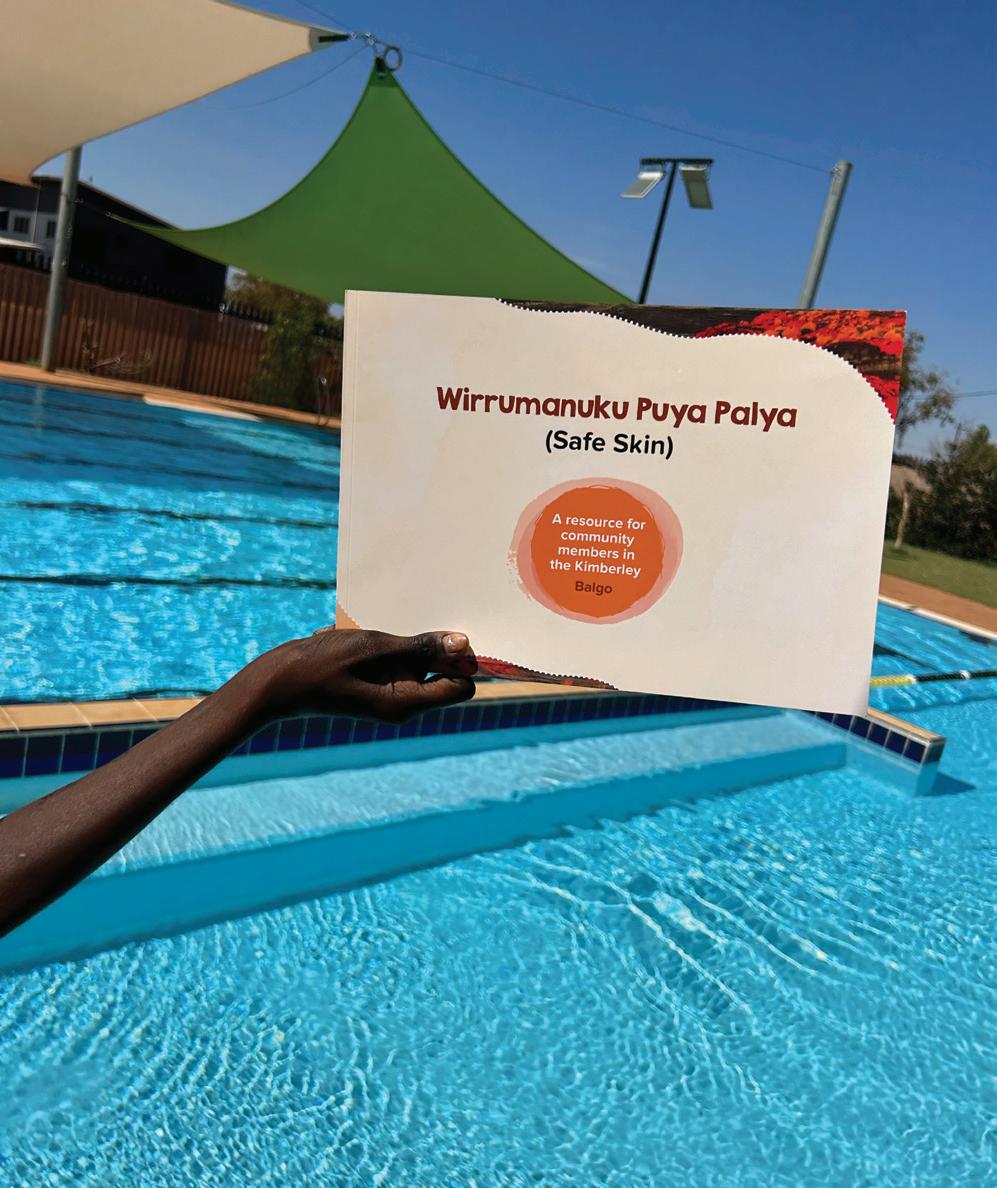
Postdoctoral researcher Dr Hannah Thomas said the involvement of kids and local communities in the Kimberley had been absolutely pivotal, ensuring everyone worked together towards the goal of healthy skin.
“We really wanted to empower the children to prioritise their own health, so in addition to skin checks and efforts to improve treatment we embedded a number of interactive projects for the kids to get involved in,” Dr Thomas said.
“This included a hip-hop video filmed on the Dampier Peninsula that shared healthy skin messages in the children’s own words, co-designing workshop materials in the classroom, and developing healthy skin story books featuring language, photos and artwork created by the students.
“Together, these resources create a legacy that combines western medicine and traditional cultural knowledge that will help communities maintain healthy skin,” Dr Thomas said.
A healthy skin resource for the Balgo community co-designed in local language.
Shaping global policy on infectious disease with mathematical modelling research
Mathematical modelling is being used to guide infectious disease elimination and eradication on a global scale at The Kids Research Institute Australia.
The Global Disease Modelling Team, led by the Fiona Stanley Chair in Child Health Research and UWA Professor Melissa Penny, is conducting world-leading research using mathematical modelling to better understand the transmission and biology of malaria, and to identify effective interventions to curb the rising number of cases of this life-threatening disease.
The World Health Organization’s (WHO) latest world malaria report found there was an estimated 263 million cases and more than 597,000 malaria deaths globally in 2023. This was about 11 million more cases
compared to 2022 and a similar number of deaths. About 95 per cent of deaths occurred in the WHO African region where many people lack services to prevent, detect and treat the disease.
Children and pregnant women are most at risk.
Professor Penny said mathematical modelling had a long history in the fight against malaria. Over the past two decades it had been an integral part of decisionmaking across research and development and policy decisions on malaria interventions.

The Kids/UWA Professor Melissa Penny and members of her team, left to right, Associate Professor Andrew Shattock, Scientific Software Developer Baxter Smith, Forrest research scholar and PhD student Yuval Berman, Dr Quang Nguyen and Dr Josephine Malinga. Additional contributing team members not pictured include: Dr Lydia Braunack-Mayer, Dr Epke le Rutte, Chitra Saraswati, Dr Julian Heng, Cynthia Chen, and University of Basel PhD student Daniella Figueroa-Downing.
Her team’s work has directly informed impact and economic assessments of malaria vaccines rolled out in African countries through the Gavi, The Vaccine Alliance, and her work has been critical to form the evidence behind decisions to administer 24 million doses of the vaccines across 20 African countries to protect lives and prevent serious forms of the illness.
In 2025, with funding from Open Philanthropy, modelling research by the team supported WHO policy decisions on new and existing malaria vaccines (R21/ Matrix-M and RTS,S/AS01). These approaches are also being used to study other infectious diseases including COVID-19, Strep A, and respiratory syncytial virus (RSV).
“The work we are doing in mathematical modelling at The Kids is helping to change global attitudes about the use of mathematical modelling to control, treat and cure infectious diseases,” Professor Penny said.
“Modelling connects key stakeholders that can bring
actionable solutions to global problems in child and adolescent health.”
In December 2024 Professor Penny was appointed to the Malaria Policy Advisory Group, an independent 16-member team that comprises the world’s foremost experts on malaria including immunologists, epidemiologists and community health researchers.
The Group advises the WHO Director-General and its Global Malaria Program on priority activities, policy, engagement and implementation.
“My role on the Advisory Group is to lead the impartial assessment on the available modelling evidence that aids in our ability to understand, control and treat malaria worldwide.”

The Global Disease Modelling team is supported by Open Philanthropy and the Gates Foundation to develop new open-source mathematical models of malaria dynamics and to use the models to support research and development, investment, and policy decisions on novel malaria interventions like new vaccines and drugs.
2.2 billion cases of malaria and 12.7 million deaths have been averted since 2000
In 2023 there were 263 million cases and 597,000 deaths from malaria
The WHO African region is home to 95% of malaria deaths Children under 5 years account for 76% of all malaria deaths in the Africa region WHO aims to reduce malaria deaths by 90% by 2030

IN THE PIPELINE
Research that is in the pipeline towards translation.

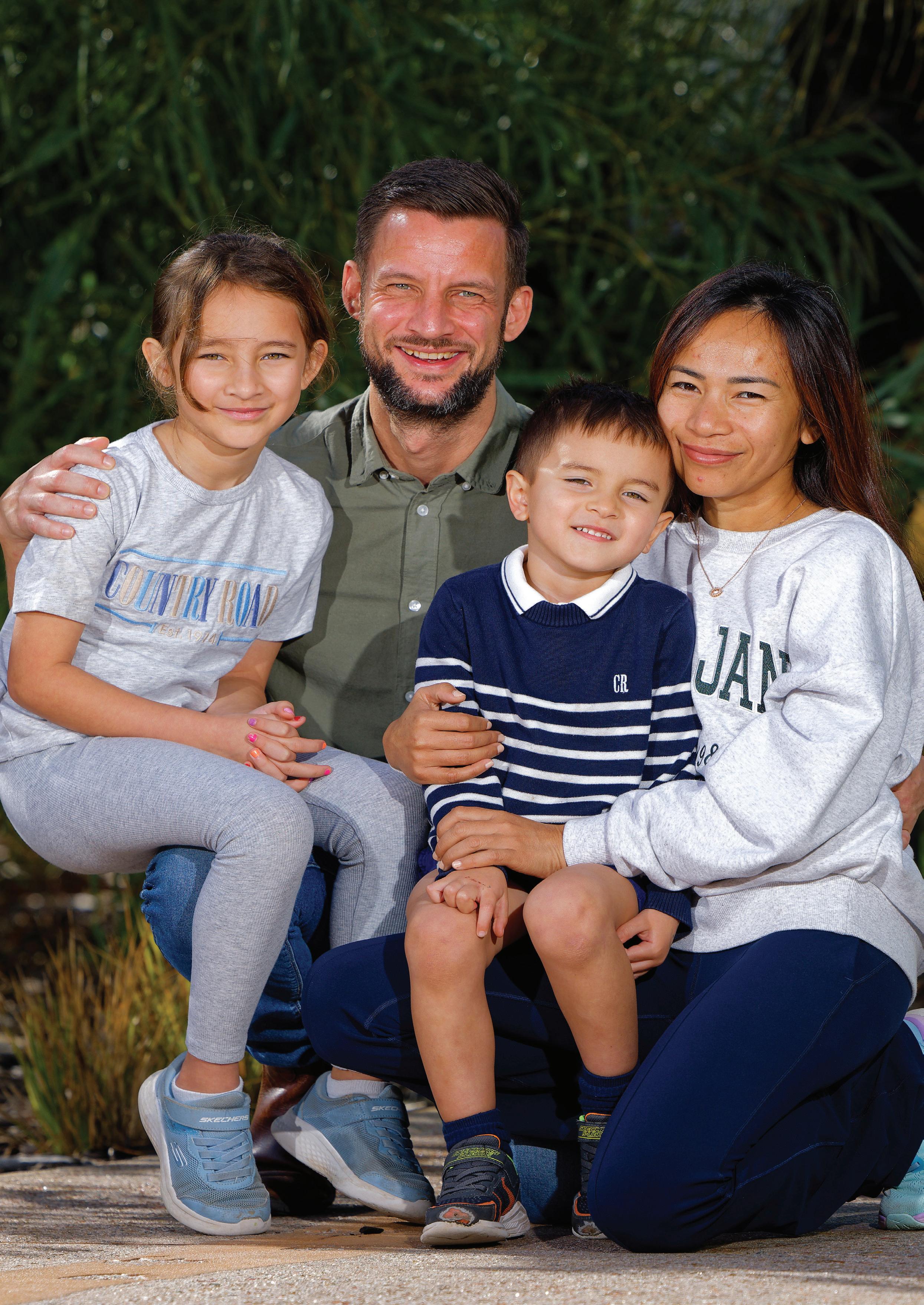
Chris and Evelyn Gorman with their children Lucy, 8, and Josh, 5.
New autism approach is pointing families in the right direction for support
Every child has a voice, but many autistic children are not heard. This is because they are late to talk, do not talk, or communicate in ways other than speech.
Alarmingly, three in five autistic children reaching school age in Western Australia are unable to talk or communicate easily, severely impacting their education and posing challenges for teachers needing to meet the needs of all students.
To address this, CliniKids — The Kids Research Institute Australia’s first integrated clinical and research service — will embark on a five-year research program to help autistic children communicate effectively at school entry and successfully start education in mainstream school.
The program involves developing a world-first approach — called COMPASS — whereby CliniKids researchers map each autistic child’s unique clinical profile and match it to the most effective evidence-based clinical support.
The goal? That all autistic children in WA are able to effectively communicate at school entry.
Professor Andrew Whitehouse — The Kids Deputy Director (Research), Angela Wright Bennett Professor of Autism Research, and Director of CliniKids at The Kids — said the outcome of this program would be a new, evidence-based way to reduce communication disability in autism.
“There is no single therapy that is effective in supporting the communication development of all autistic children, and there is currently little understanding about how to ensure each autistic child receives the most effective therapy for their specific needs,” Professor Whitehouse said.
Three per cent of Australians are diagnosed with autism, up tenfold in the past 20 years.
“This research program will address this urgent issue by, first, using new computerised adaptive testing to develop a new method of communication assessment, and second, acquiring knowledge about which clinical support is most effective in reducing communication disability for different autistic children.
“This research will then be combined to develop COMPASS, an evidence-based approach for personalised matching of communication-focused supports for autistic children.”
CliniKids Senior Principal Research Fellow, Professor David Trembath, will lead the program alongside Professor Whitehouse.
Professor Trembath said the long-term vision was for COMPASS to be a clinical tool that was embedded in health, education and disability systems.
“COMPASS will provide a more accessible, efficient, and personalised assessment approach, reducing time spent on waitlists and appointment costs for families,” Professor Trembath said.
“This bold program is the first step towards transformational change for WA, using a foundation of science to develop and validate a new approach that will improve the efficiency and effectiveness of clinical practice.”
Two in three autistic children experience major challenges with communication
Three in five autistic children reaching school age are unable to talk or communicate easily.
Just over half of all autistic children (56 per cent) enter the school years able to effectively communicate.
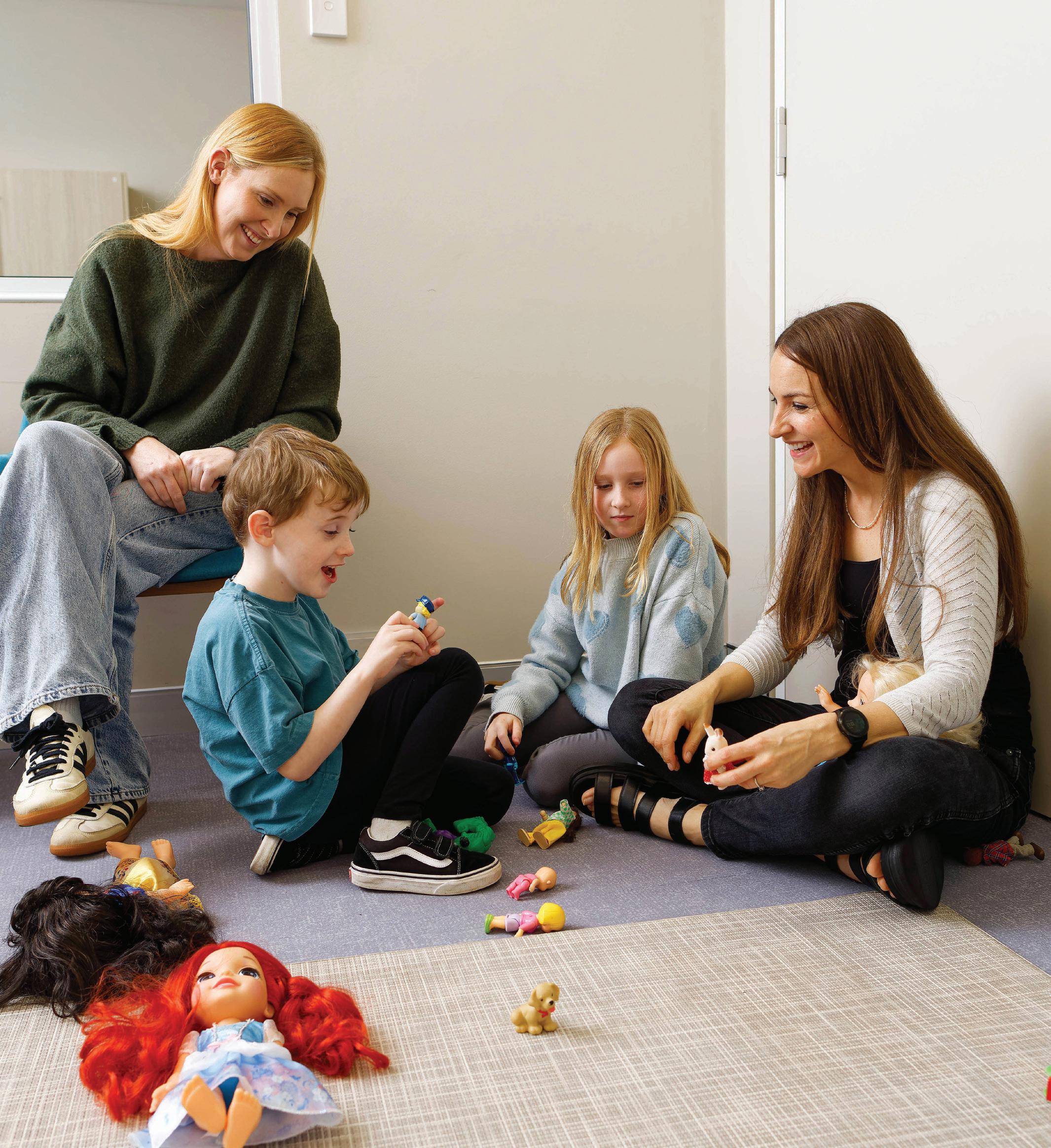
NEXT STEPS
• A clinical trial will test COMPASS to see if it is more effective in reducing communication disability compared to current practice.
• It is hoped COMPASS can be extended across Australia, providing support to an estimated 10,000 children nationally.


Supported by the Stan Perron Charitable Foundation, the Angela Wright Bennett Foundation and the Channel 7 Telethon Trust
Mum Stacey Green (on chair) watching Senior Speech Pathologist Lara Goldie work with her daughter Schyler, 8, and son Harrison, 5.
Parents urged to trust their inklings to help babies’ communication development
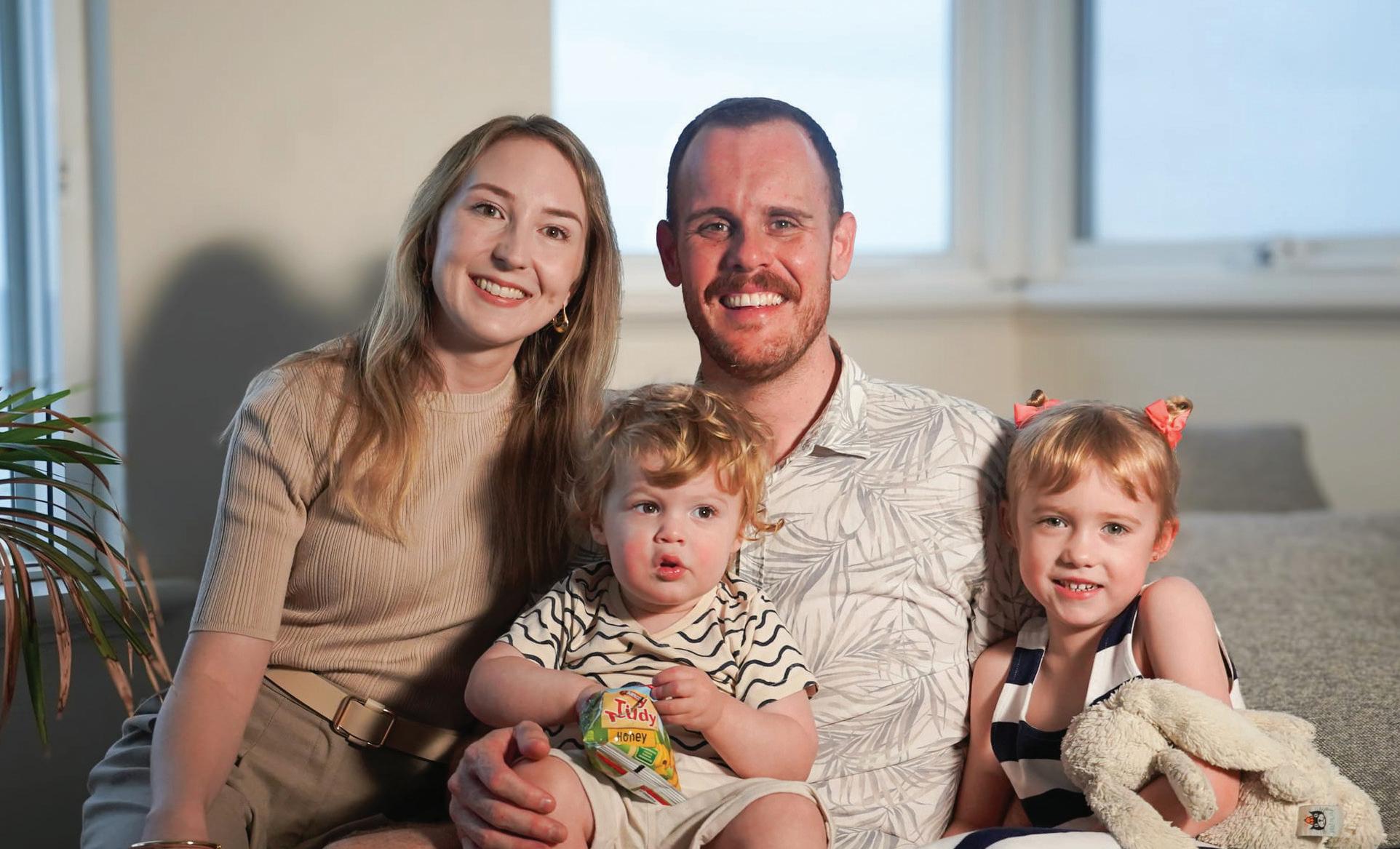
Collyer-Petale and her husband Jonathan with their children Fraser, 2, and Evelyn, 5.
Fraser Collyer-Petale was just 10 months old when his mum, Shanyn Collyer-Petale, noticed subtle differences in the way he communicated. Compared to his older sister, he wasn’t babbling, and he didn’t seem to be meeting the same developmental milestones.
“I didn’t really notice anything unusual at first,” Mrs Collyer-Petale said. “But as he got a bit older, there were small things – like not babbling or responding the way I expected – that started to raise some red flags.”
After watching a news segment about Inklings, an evidence-based program developed at The Kids Research Institute Australia which supports babies aged 6 to 18 months who show early differences in how they communicate and relate to others - Mrs CollyerPetale decided to reach out.
Inklings is a 10-session program that helps caregivers better understand and respond to their baby’s unique ways of connecting.
It involves short video recordings of the baby’s interactions, followed by guided reflection sessions with a trained practitioner who supports families to recognise and build on these early communication attempts.
Funded by NDIA, the pilot program began in 2023 – following its official launch in February 2024 by the then Federal NDIS and Government Services Minister Bill Shorten and WA Health Minister Amber-Jade Sanderson – Inklings has received more than 450 inquiries from families across Western Australia.
“The program was incredibly valuable,” Mrs Collyer-Petale said. “It wasn’t just about Fraser – it was about helping me see how he was trying to communicate, in ways I might not have recognised otherwise.”
The 10 sessions became a special bonding time for mother and son.
Shanyn
“There was one moment where they were playing a ‘ready, set, go’ game, and I realised he was saying ‘go’ in his own way,” Mrs Collyer-Petale said.
“It was something I never would have noticed if it wasn’t pointed out. Those little moments made such a difference.”
Now, Mrs Collyer-Petale and her family take a more intentional approach to communication.
“We’re much more tuned in. We try to pause, observe, and really take notice of the small cues or attempts at interaction,” she said.
“It was lovely to spend one-on-one time with Fraser and really focus on him and his needs. It brought us closer together.”
Inklings General Manager Gemma Upson said the program built on years of research into early childhood development.
“Inklings is all about helping every child reach their full potential, and our goal is to give this opportunity to as many babies as possible, both across WA and beyond,” she said.
Interested caregivers can either be referred by a health professional or enquire directly to Inklings to see if they are eligible to participate.
Mrs Collyer-Petale’s advice to other families is simple: “You know your baby best. Just go for it.”

NEXT STEPS
Listening and learning from First Nations communities
A consultation led by The Kids and funded by the National Disability Insurance Agency has revealed what matters most to First Nations families when it comes to early childhood developmental support.
Over 12 months, 71 consultations were held across Western Australia— from metropolitan to remote regions—hearing directly from First Nations people and service providers. The findings underscored a clear call for culturally safe, accessible information and early support programs, particularly in areas with limited services.
Inklings welcomes all families, and recommendations are being incorporated through ongoing partnerships with First Nations peoples and organisations—with cultural safety at the core.
Inklings expands to South Australia
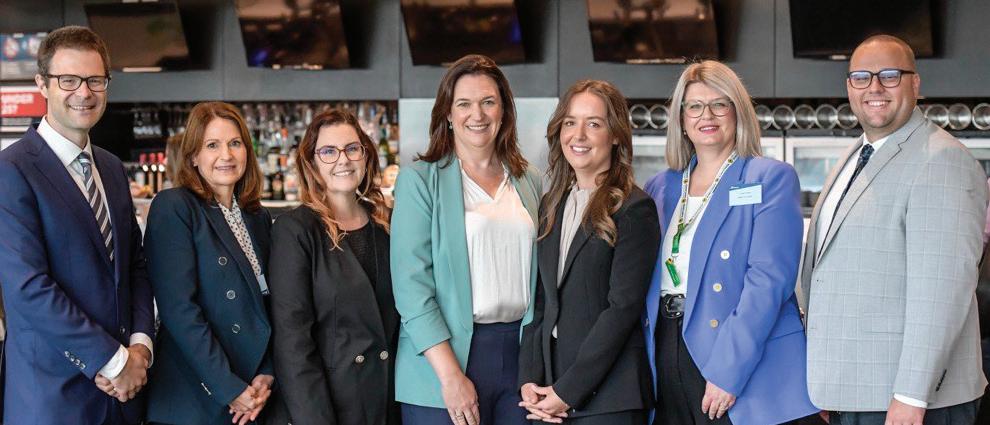
The Kids Inkling has officially launched in South Australia, offering support for families with babies aged six to 18 months showing early social and communication differences.
Funded by a joint investment from the South Australian Government and the Department of Social Services, the program is available across South Australia, including Northern Adelaide,
The Kids Deputy Director Professor Andrew Whitehouse, Inklings South Australia Program Manager Samantha Welke, Inklings SA Operations Coordinator Rachel Buckingham, Inklings General Manager Gemma Upson, Inklings Senior Manager Rebecca Langford, Office for Autism ActingDirector Sarah Kemp and The Kids Chief of Staff Dr Mitch Hartman at the Adelaide launch.
metro areas, regional locations, Lower Eyre, and Far North, building on a successful pilot in Western Australia.
It responds to recommendations from South Australia’s Royal Commission into Early Childhood Education and Care and prioritises access for First Nations, culturally diverse, and low-socioeconomic families.
ORIGINS research uncovers worryingly low iron levels in Western Australian toddlers
A pioneering medical study has found that one in three Western Australian toddlers are iron deficient.
ORIGINS is the largest longitudinal birth study of its kind in Australia, using data from 10,000 babies born at Joondalup Health Campus and conducted in partnership with The Kids Research Institute Australia. It has found that a third of one-year-olds and up to two in three, three-year-olds have low iron.
ORIGINS Co-Director and Joondalup Health Campus Professor of Paediatrics, Desiree Silva, said the findings were concerning because low iron could be detrimental at such a critical stage of life and development.
“Low iron can affect speech, sleep and appetite and can also potentially lead to neurocognitive, mental health and behavioural issues,” Dr Silva said.
ORIGINS is following the participating children and their families, from their time in the womb, into early childhood, to better understand the developmental origins of disease and reduce the rising epidemic of non-communicable diseases.
Since 2017, families participating in ORIGINS have contributed over 400,000 biological samples and 30
million data points - gathered through questionnaires, routine medical information, and biological specimens - enabling researchers to uncover new insights into improving child and adult health.
Early in the project, the ORIGINS team made an alarming discovery after analysing samples from blood tests taken during the project’s one and three-year Kids Check appointments: a third of the one-year-old’s samples were low in iron, and 60 per cent of blood samples from the three-year checks also appeared low in the vital mineral.
Professor Silva said the findings effectively revealed an iron crisis among Australian’s toddlers, with huge implications for families across the country.
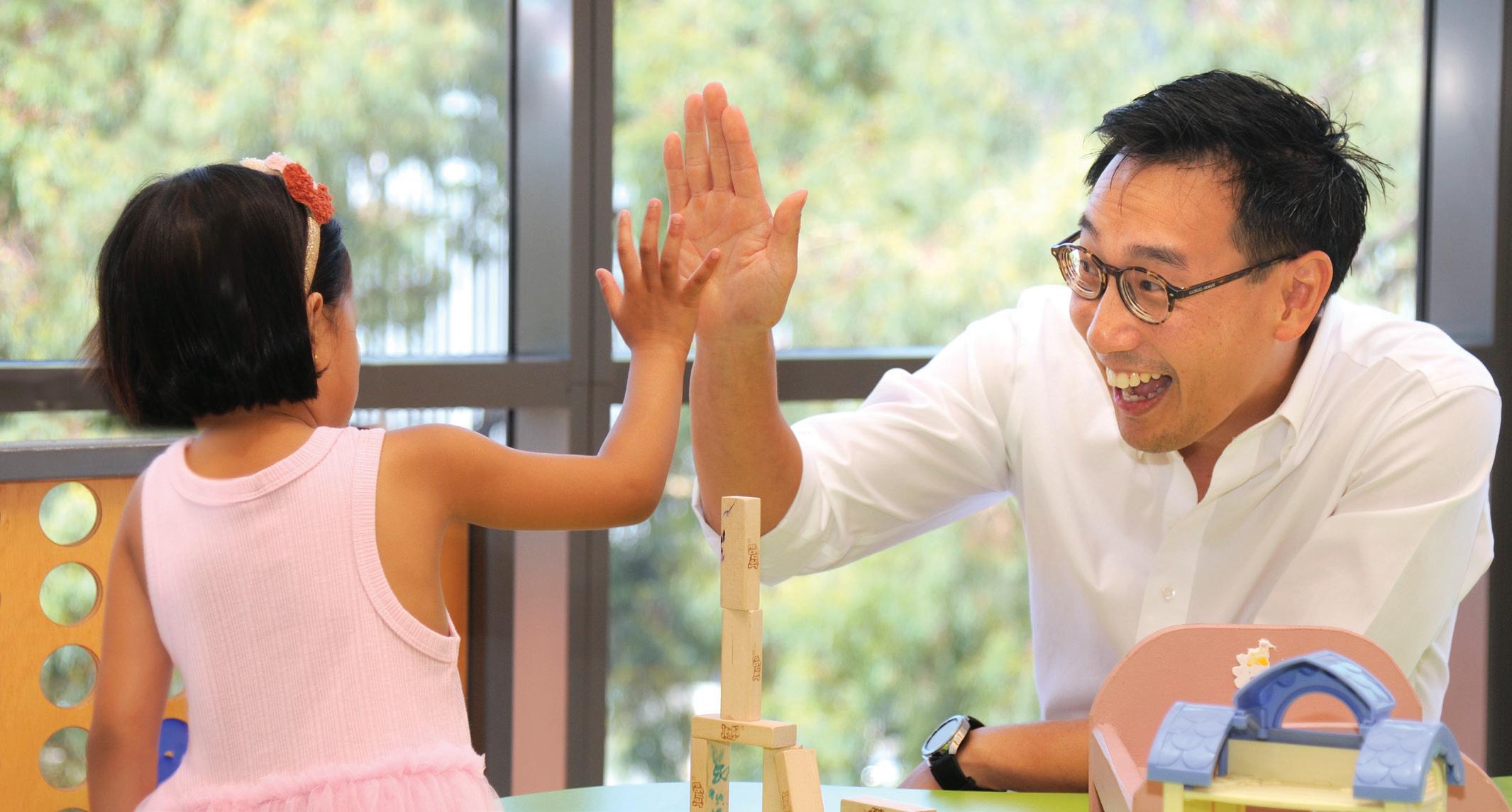
Dr Jamie Tan with IRON Child participant Hope Castillo, aged four years.
“Iron is crucial for infants and toddlers for a variety of reasons, including immunity and helping to carry oxygen in the blood to the body,” Professor Silva said.
“If iron status is low, it can mean your toddler becomes tired, lethargic, develops fussy eating habits and sleeps poorly, with a longer-term effect on learning and neurodevelopmental issues.”
Convinced there was more she could do, Professor Silva created IRON Child – an ORIGINS sub-project investigating mechanisms to prevent and treat issues caused by iron deficiency before they become clinically significant.
The project also aims to translate these findings to other communities to improve childhood flourishing.
IRON Child project lead and Head of Paediatrics at Joondalup Health Campus, Dr Jamie Tan, said that by addressing issues caused by iron deficiency early, treatment could become relatively easy and cost effective for children and their families.
“We’re currently using a variety of methods to develop prevention and treatment mechanisms, including undertaking patient focus groups to understand the barriers and enablers to detect and manage childhood iron deficiency,” Dr Tan said.
“We’re also developing an AI platform to understand the prevalence and major contributing factors of iron deficiency in children one to five years old.”
IRON Child aims to shed light on the causal factors and impacts of iron deficiency in children and to provide patient and community-focused strategies that reduce the socio-economic pressures around iron deficiency, ultimately improving child physical and mental health.
“So far, 864 children across ORIGINS and IRON Child have been detected as being low in iron, with their guardians notified and a treatment plan provided to increase iron intake through diet and nutritional changes,” Dr Tan said.
“It’s our hope that the nutritional guidelines we’re developing for families as part of IRON Child will influence changes to national policy and provide a cost-effective treatment plan that benefits both the families and the health care system.”

Top tips from ORIGINS researchers with expertise in nutrition to help boost children’s iron intake.
• Choose a breakfast cereal with added iron e.g. baby rice cereal or Weetbix.
• Spread peanut butter (smooth), pate or fish paste on toast or plain biscuits.
• Add Milo or Ovaltine (both contain iron) to milk drinks.
• Thicken homemade soups with dried peas, beans or lentils.
• Use wholemeal breads rather than white breads.
• Try some dried fruit or nuts at snack times.
• Consider baked beans on wholemeal toast with a piece of fruit.
• Offer cold meats such as nitritefree ham or chicken at snack times.
ORIGINS participant Lucas Dine, 9, having a blood test during his Kids Check appointment.
Harnessing the power of the digital age to improve adolescent mental health and anxiety levels
The world in which children are growing up today is vastly different from a generation or two ago.
Today’s youth are often referred to as ‘digital natives’kids who have grown up in the digital information age, engaging with the internet and new technologies across their childhood and within nearly all areas of their lives.
This includes their use of digital space for coping in the face of stress and challenging daily life events.
Young people are transitioning between online and offline spaces constantly and seamlessly, making it difficult to characterise the most common ways young people are managing their daily stress, and more importantly, which coping strategies are most effective.
It’s an area of expertise for Professor Kathryn Modecki - a Future Health Research Innovation (FHRI) Fund Distinguished Professorial Fellow, Head of the Developmental Science of Mental Health Team at The Kids and Professor in the School of Psychological Science UWA - who is working to tackle the mounting mental health crisis in young people by leveraging untapped resources, data, and technologies to better understand and address mental health across generations.
An early body of research from Professor Modecki’s team has shown that when used judiciously, digital coping strategies can be highly effective for bouncing back from stress on a day-to-day basis
These are strategies the team has measured via bestpractice methodologies from young people’s own phones in everyday life.
“As a researcher at the convergence of developmental and quantitative psychology and prevention science — mobile phones are both a critical tool for understanding young people and for reaching them with knowledge and support in times of challenge. We like to say that for teens, the world is “post-digital”— their online and offline worlds are endlessly intersecting and inter-related.
“As a result, we have been partnering with an array of scientific disciplines as we continue to address how young people’s mobile phones can be
a conduit to meeting their mental health needs when faced with stressful events.
“We are asking : ‘Where are they actually going, what are they doing, and for how long?’
“We are able to take best-practice data privacy approaches and still have access to critical anonymised information like keystrokes made on the virtual keyboard, algorithmic sleep information, screen time, and which apps they are using.
“All of this gives us crucial insight into how they are dealing with their daily stressors via their digital worlds, when, and why—what is the trigger— and just as important, what is the outcome—does it help, hurt, or make little difference?”
Most recently, the team followed more than 200 young people for 14 days, asking them to report on their momentary stressors and mental health directly from their phones ‘in the wild’ across their everyday life.
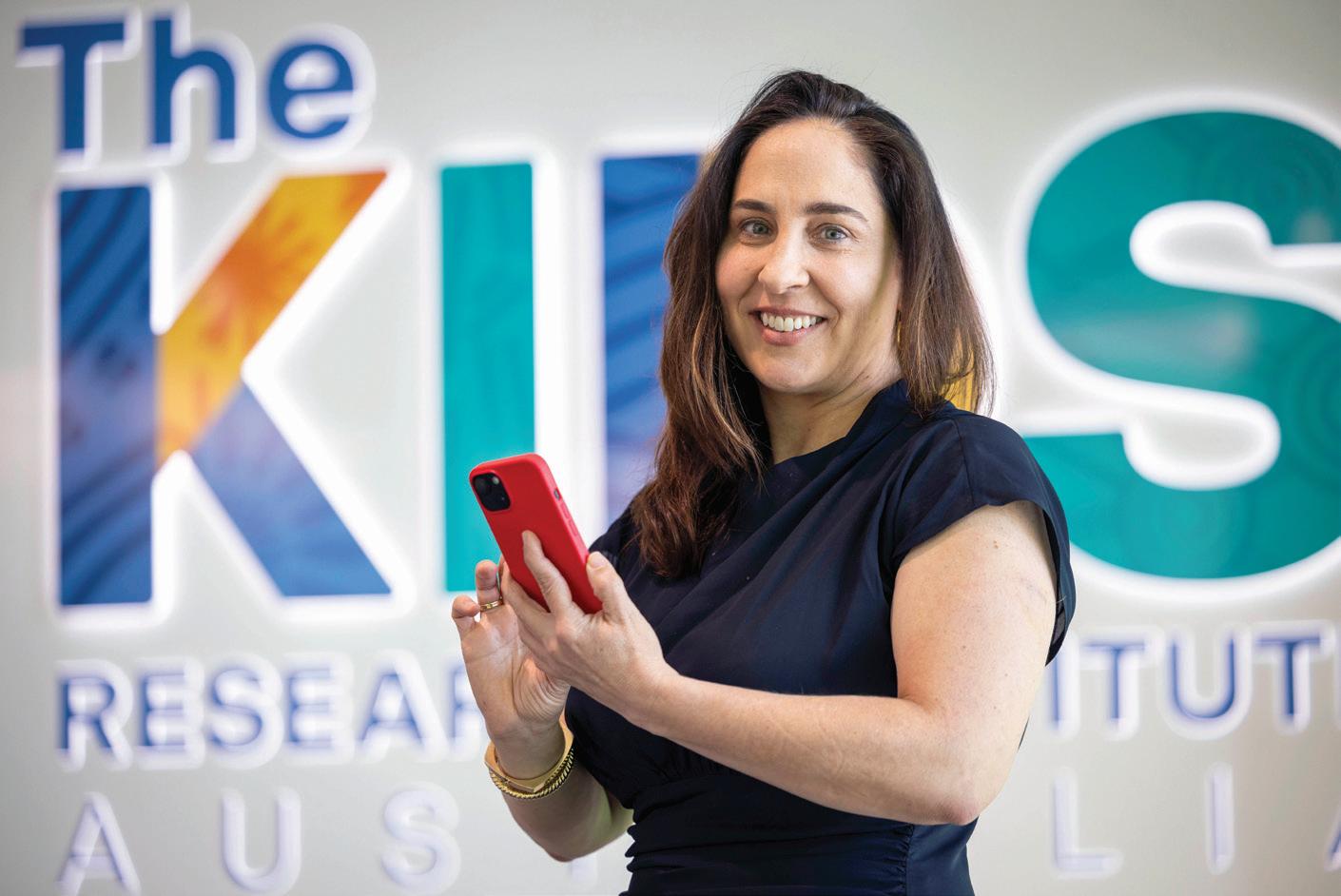
Professor Kathryn Modecki.
They simultaneously streamed screen time, sleep and other key objective markers of daily time use that could be symptomatic of poor wellbeing. Importantly, they addressed how young people were using the digital world to cope with stress as well as more traditional “offline” ways of managing daily stressors.
Measuring their ways, the research found online coping was more prevalent among young people than more traditional offline coping strategies.
“While few effects - either helpful or problematic - emerged for offline coping, our results continue to show positive effects on daily mental health for certain digital coping strategies,” Professor Modecki said.
“The online coping we are describing takes many forms and arguably gives young people agency and immediacy when they are stressed. It is also a window of access that not all young people may traditionally have, depending on their family, neighborhood resources, or community norms.”
“Online coping might include emotional support seeking behaviours, like using chat or social media apps to connect, it might be seeking health information directly or finding information online to book an appointment, using technology for active problem-solving and even as a shortterm distraction.”
Professor Modecki said these findings were important for continued work to reduce and prevent mental health problems and support young people ‘where they are’, and for policy.
“Young people are incredibly resilient, creative, curious and resourceful,” she said, “And different young people have different stressors in their lives.”
“Digital spaces afford myriad opportunities, as well as risks. Asking the right questions to mitigate risk and enhance access to the benefits of the online world - particularly among those facing reduced digital literacy - represents an urgent area of need.
“Digital is part of their life, it isn’t going away anytime soon, and we need to meet them there, provide resources that are evidenced-based, and ultimately ensure that they are wellequipped to navigate this space effectively when it comes to supporting their mental health and wellbeing.”

Cutting edge approach to the science of mental health
Professor Modecki’s team has been leading focus groups with WA parents and teens to better contextualise findings, which will help to co-design and map next-steps for moving digital coping into the prevention science pipeline.
“Our goal is for safe, engaging, and supportive guardrails to help teens best make use of digital capacities—for when and how they need them,” Professor Modecki said.
Her team is also looking to parents to chart what caregivers can do, on a day-to-day basis, to support and enhance their teen’s wellbeing.
“We are drawing on decades of developmental science regarding optimal parenting and marrying this with the emerging realities of parenting in an increasingly digital and uncertain period. Using digital tools, we are mapping ‘just in time’ parenting to provide concrete evidence for diverse families.”
In addition, the team is working to advance methodologies addressing adolescents’ daily mental health, to better fill the gaps in the evidence-base.
“We are partnering with mathematicians and computer scientists, and doing so alongside WA young people, to bring cutting-edge approaches to the science of mental health.”
This summer, the team will be hosting computer scientists at the Institute via competitive internships with the Pawsey Supercomputing Research Centre.
Professor Modecki and her team are supported by State Government’s FHRI Fund and the Stan Perron Charitable Foundation. Professor Modecki is also supported by a 2025-2027 Australian Research Council Discovery Grant focused on parenting adolescents to support their wellbeing.
“Fundamentally, we are committed to designing and conducting rigorous research to advance the development science of mental health and progress the evidencebase.
“We strongly support scientific collaboration, welcome multidisciplinary approaches, and openly share our research protocols and findings.”
Innovative end to recurrent ear infections
One grommet surgery is traumatic enough for the 5,000 WA children who undergo the procedure each year, but for half of these kids, it will take multiple surgeries to eliminate the underlying cause of their middle ear infections.
Dr Ruth Thornton, Co-Lead of the Bacterial Respiratory Infectious Diseases Group at the Wesfarmers Centre of Vaccines and Infectious Diseases, based at The Kids Research Institute Australia, is hoping to make these repeat surgeries history with the invention of Blitz-OM.
Recently awarded $2 million in National Health and Medical Research Council and WA Child Research Fund grants, Dr Thornton and her team are working alongside CSIRO to develop an innovative new treatment designed to target the bacterial slime responsible for chronic infections and eradicating them completely.
“Middle ear infections, also known as otitis media (OM), are very challenging to treat because the bacteria lives inside biofilm or ‘glue’ in the ear, and this makes them up to 1000 times more resistant to antibiotics,” Dr Thornton said.
“The current treatment for children who experience recurrent OM and hearing loss is grommet surgery, followed by antibiotics given twice daily for five days, but up to 50 per cent of the time children will need repeat grommets when the bacteria remain and infections re-occur.
“Parents have also told us that ear drops, even the standard antibiotics after surgery, can be hard to give their kids and they often don’t know if they managed to get them in, which means sometimes kids don’t get the right treatment.
“Some kids suffer through 10 or more surgeries to treat their infections, so we knew better treatment options were urgently required to ensure initial grommet surgeries were successful,” Dr Thornton said.
Blitz-OM has emerged from two decades of research by Dr Thornton and her team, who first discovered that bacterial biofilms were the culprit for chronic and recurrent ear infections back in 2004.
“Our studies identified that Dornase alfa, an enzyme commonly used to clear mucus in lungs of cystic fibrosis patients, could be a secret weapon in the battle to ‘break down’ the biofilm in the ear and prevent kids needing repeat grommet surgery,” Dr Thornton said.
A world-first Phase I trial conducted between 2012-2016 successfully demonstrated the safety of using Dornase alfa in children’s ears, and a follow-up study has demonstrated that multiple applications are also safe, paving the way for further product development
A $25,000 Wesfarmers Centre seed grant awarded in 2018 allowed Dr Thornton to develop a prototype Blitz-OM, provide vital data to secure a partnership with CSIRO and obtain nation-wide, competitive funding grants to develop a product ready for clinical trials.
“We are now developing a single-dose, slow-release gelbased medicine that is administered to the ear during grommet surgery, attacking the biofilm and effectively treating the hidden bacteria so that one procedure is all it takes,” Dr Thornton said.
“The impact on kids and their families will be huge – less pain, fewer surgeries and reduced antibiotic use, while our healthcare system will benefit from shortened hospital waiting lists and significantly less demand for audiology and speech therapy services.
“It has been quite the journey to grow this research from an ‘out of the box’ idea right through to a multimillion-dollar project set to make a real-world, major impact on children’s lives – I’m very excited to see what lays ahead for Blitz-OM.”

NEXT STEPS
• The Blitz-OM team recently completed the CSIRO ON Prime program, conducting customer discovery and market validation activities that will now help them maximise the potential impact of this new treatment.
• Further funding will need to be secured for clinical trials focusing on the safety and efficacy of the Blitz-OM prototype.
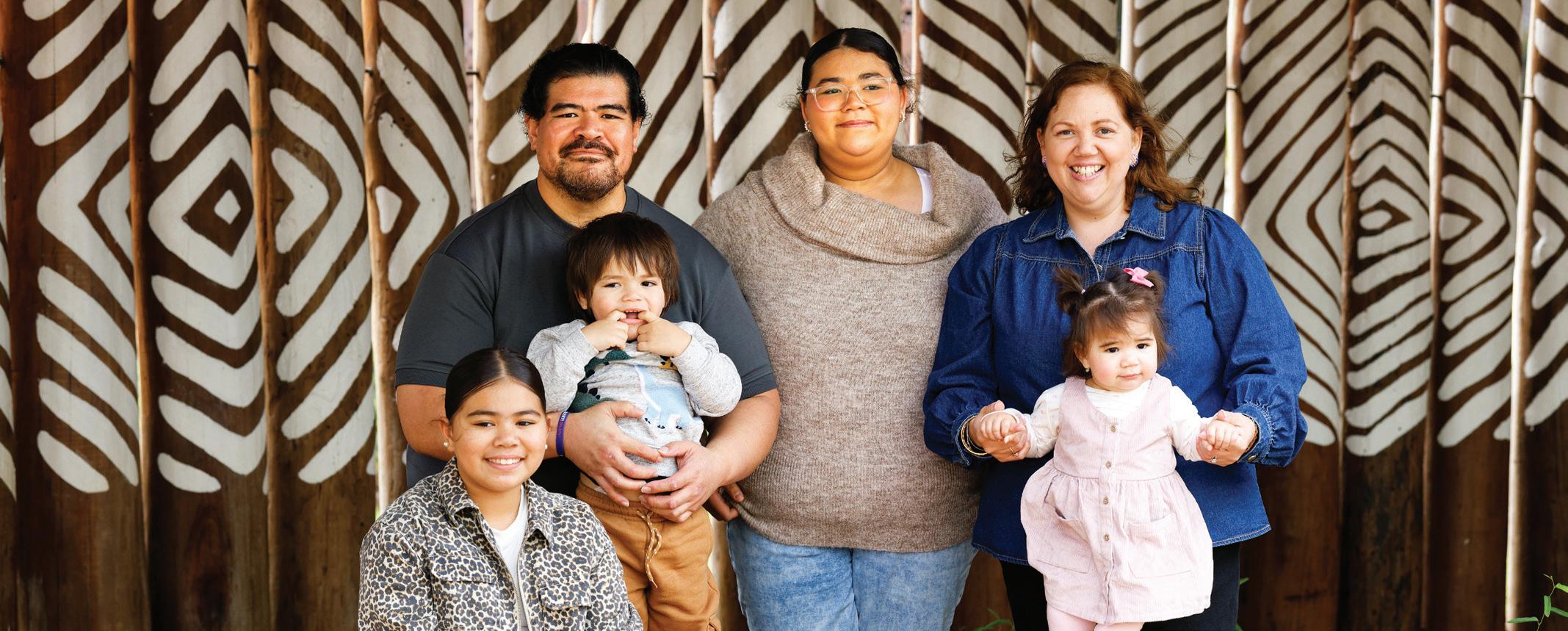
Relief for families dealing with recurrent ear infections
Aboriginal Researcher Mrs Natasha Morrison knows far too much about the impact of recurring ear infections – three out of her four children have had middle ear disease.
As a member of the Ear Health team at the Wesfarmers Centre, and through her own lived experience, she truly understands how important healthy ears can be for a child’s quality of life.
“My children have suffered from constant ear infections, numerous visits to the doctor and many doses of antibiotics and ear drops – this has led to countless sleepless nights, irritability, loss of appetite and the inability to do daily tasks,” Mrs Morrison said.
“My now 10-year-old daughter first began complaining of ringing ears and hearing loss from seven years of age, and recurrent ear problems meant she always
1 in 4 children affected by chronic middle ear infections
700 million ear infections occur worldwide each year
missed out on water-based activities such as swimming lessons.
“For my son, Mareko, his infections started much earlier - he experienced pain and high fevers so often that I had to take him to the emergency department at just nine months of age.
“Both have now had grommet surgery, including a second surgery for my daughter when her ear healed over the grommet, but our battle with ear infections is still ongoing - my baby daughter has needed numerous hospital visits and specialist appointments ahead of her surgery later this year.
“As a parent, it’s so hard watching your children suffer, so I’m excited by the progress being made in ear health research at The Kids and hope to see ear infections become a thing of the past in the near future.”
Affects 50% of Aboriginal and Torres Strait Islander children by 6 – 8 months of age
5,000 grommet surgeries performed each year in Western Australia
$40 million associated health care costs per annum
<50% of kids require repeat grommet surgery
$2 million in funding secured for Blitz-OM
Malo Chang Wai, back left and Natasha Morrison, back right, with their children Ariana, 13, Milahni, 10, Mareko, 2 and Addison, 1.
Global program seeks to unlock immune system secrets to improve children’s lung health
An international, multi-institutional quest is hoping to find ways to increase babies’ vaccine responsiveness and reduce childhood respiratory disease.
The Kids Research Institute Australia is part of the global Immune Development in Early Life (IDEAL) program coordinated by the Precision Vaccines Program at Boston Children’s Hospital in the United States.
The study leverages systems biology – technologies that measure inventories of cells and molecules in the body- and modelling human immunity outside the body (in vitro) to understand how a child’s immunity is established, developed and maintained in the first five years of life. This childhood immune development is then associated with common paediatric health outcomes such as vaccine responsiveness.
The Kids Theme Head, Chronic Disease Research and Clinical Epigenetics team lead, Associate Professor David Martino, said the overall aim was to improve vaccines and immunotherapies to treat and prevent immune-mediated diseases.
“The study is particularly focused on babies prone to infection and children at risk of allergies and asthma,” Associate Professor Martino said. “We want to expand our knowledge of the developing immune system, which is very different in children compared to adults because it undergoes very rapid changes in those early years of life.
“A significant focus is on how early life exposure to respiratory infections such as influenza or COVID-19, even before birth, shape the immune system and affect future immune responses and vaccine efficacy.
“The overarching goal is to accelerate discovery and development of new approaches for preventing childhood diseases by understanding and potentially manipulating key molecular biomarkers to direct immune development towards health and away from disease.”
IDEAL is funded by the United States-based National Institutes of Health’s (NIH) National Institute of Allergy and Infectious Diseases (NIAID) and brings together immunologists, neonatologists, paediatricians, systems biologists and microbiologists from around the world, including North America, Africa, Europe and Australasia.
Associate Professor Martino said The Kids was spearheading the epigenetic work package within the program and has produced genome-scale epigenetic datasets of several thousand newborns and infants which are publicly available through NIAID.
“This is a really exciting program because the insights gained, including the specific factors contributing to low vaccine responsiveness in vulnerable children, could lead to precision vaccine schedules, adjuvants or vaccine formulations that optimise immunity.
“A major focus is also on understanding the susceptibility to respiratory infections and chronic respiratory disease such as asthma. The study is poised to uncover novel biomarkers for risk prediction and ‘treatable traits’ clinical trials.”
Associate Professor Martino said IDEAL would provide a systems level view of how the immune system matures, how environmental factors shape these processes throughout early childhood.

Associate Professor David Martino (right) with Research Assistant Nina Kresoje and PhD candidate Ziyi Wang.
Study proves health benefits of ‘liquid gold’
The transition from fetus to newborn is the most dramatic shift in human life. A baby moves from the sterile, protected environment of the womb –dependent on the mother’s physiology – to breathing, feeding, and facing billions of microbes alone.
At this critical time, the mother produces colostrum –often referred to as liquid gold – the first milk available during the first three days after birth. Known for its rich composition in growth and immune factors, colostrum is believed to support a newborn’s early development and defence. While studies have proven its makeup is biologically unique, research is still emerging on its long-term impact.
Despite its potential, colostrum is often undervalued. Globally, one in three newborns receives formula supplements during this critical window. In Western Australia, nearly half of all newborns receive only a partial dose of colostrum.
Professor Valerie Verhasselt, Head of Immunology and Breastfeeding at The Kids Research Institute Australia, is leading efforts to better understand the lifelong impact of colostrum. Drawing on data from 666 newborns in ORIGINS – Australia’s largest longitudinal birth cohort of its kind – her team discovered that babies exclusively fed colostrum in their first 72 hours were five times less likely to develop a peanut allergy and 11 times less likely to develop multiple food allergies.
Until now, formula supplementation has been viewed mainly through the lens of cow’s milk allergy risk. These new findings suggest early formula use may disrupt the protective effects of colostrum.
“Our research opens new perspectives for peanut allergy prevention, including the promotion of colostrum feeding and the development of colostrum-inspired therapeutics for infants at risk, who require formula for medical reasons or whose mothers are unwilling to breastfeed,” Professor Verhasselt said.
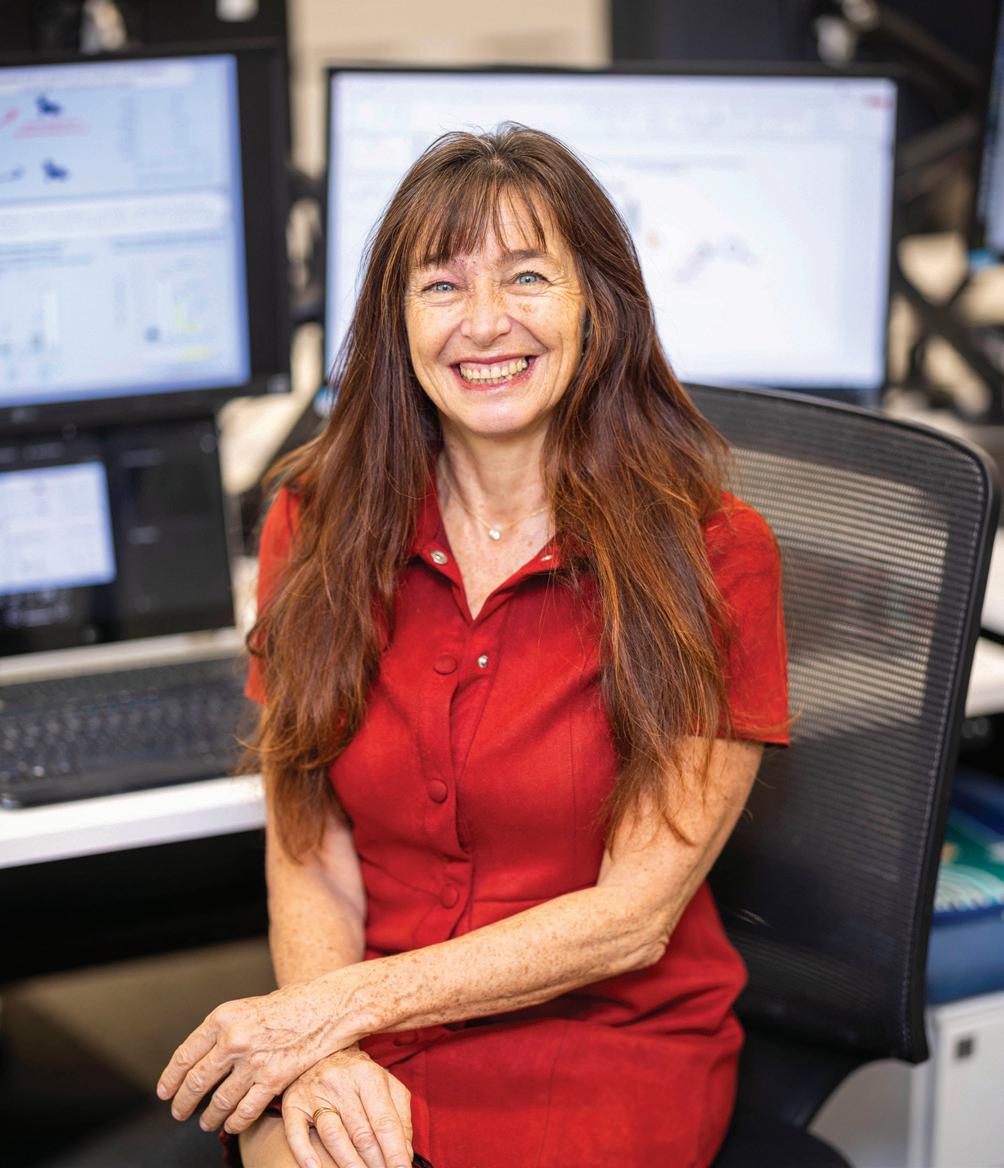
Professor Verhasselt, who is also a Director of the LRF Centre for Immunology and Breastfeeding at The University of Western Australia, acknowledged breastfeeding was a deeply personal and often challenging experience, and that not all mothers could breastfeed, due to personal, health, or medical reasons.
She believed that in cases where formula supplementation was required, it was vital for parents to receive clear and supportive advice on the timely introduction of allergens to help reduce the risk of allergies.
“Although we recommend exclusive colostrum feeding, if your child has been supplied formula within the first days of life, our research shows increased colostrum feeds can assist in reducing the development of a peanut allergy.”
Professor Valerie Verhasselt.
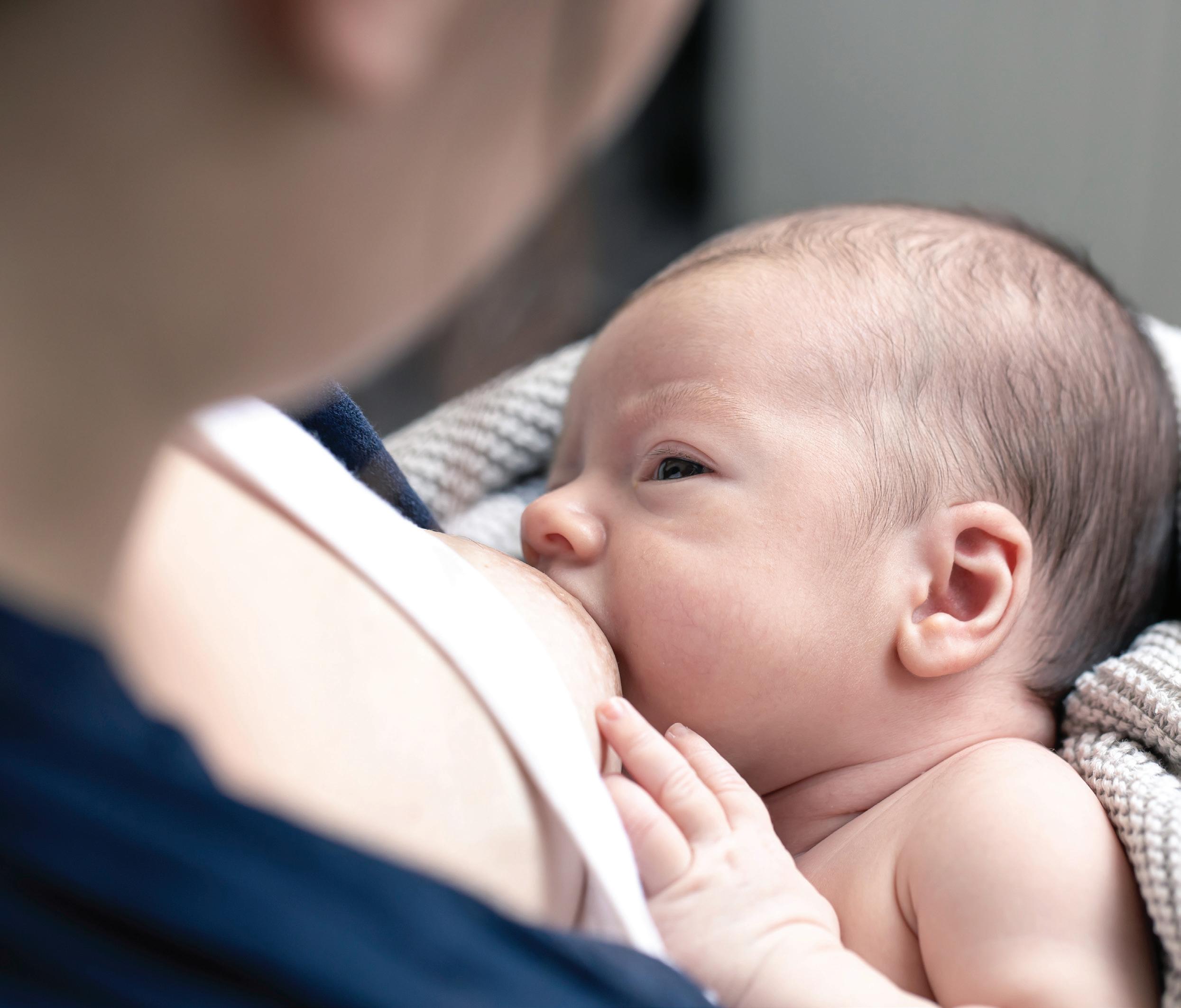

NEXT STEPS
Professor Verhasselt’s team is now expanding their research within the ORIGINS cohort to uncover how colostrum influences long-term health. This next phase will:
• Quantify the health risks linked to partial colostrum feeding, such as allergies, infections, obesity, and neurodevelopmental disorders
• Identify early-life biological signatures related to different colostrum feeding patterns
• Map the biological linking colostrum feeding and long-term health outcomes
This work will provide the first comprehensive evidence of colostrum’s long-term benefits in Western settings – critical for improving healthcare training, guiding parent education, and informing newborn feeding policies. It will also lay the groundwork for innovative, colostrum-inspired, newborn-tailored interventions to support infants requiring medical supplementation, at risk of disease, or whose mothers are unable or unwilling to breastfeed.
Northern Entrance, Perth Children’s Hospital, 15 Hospital Avenue, Nedlands WA 6009
PO Box 855, West Perth Western Australia 6872
T 08 6319 1000
E contact@thekids.org.au
W thekids.org.au
